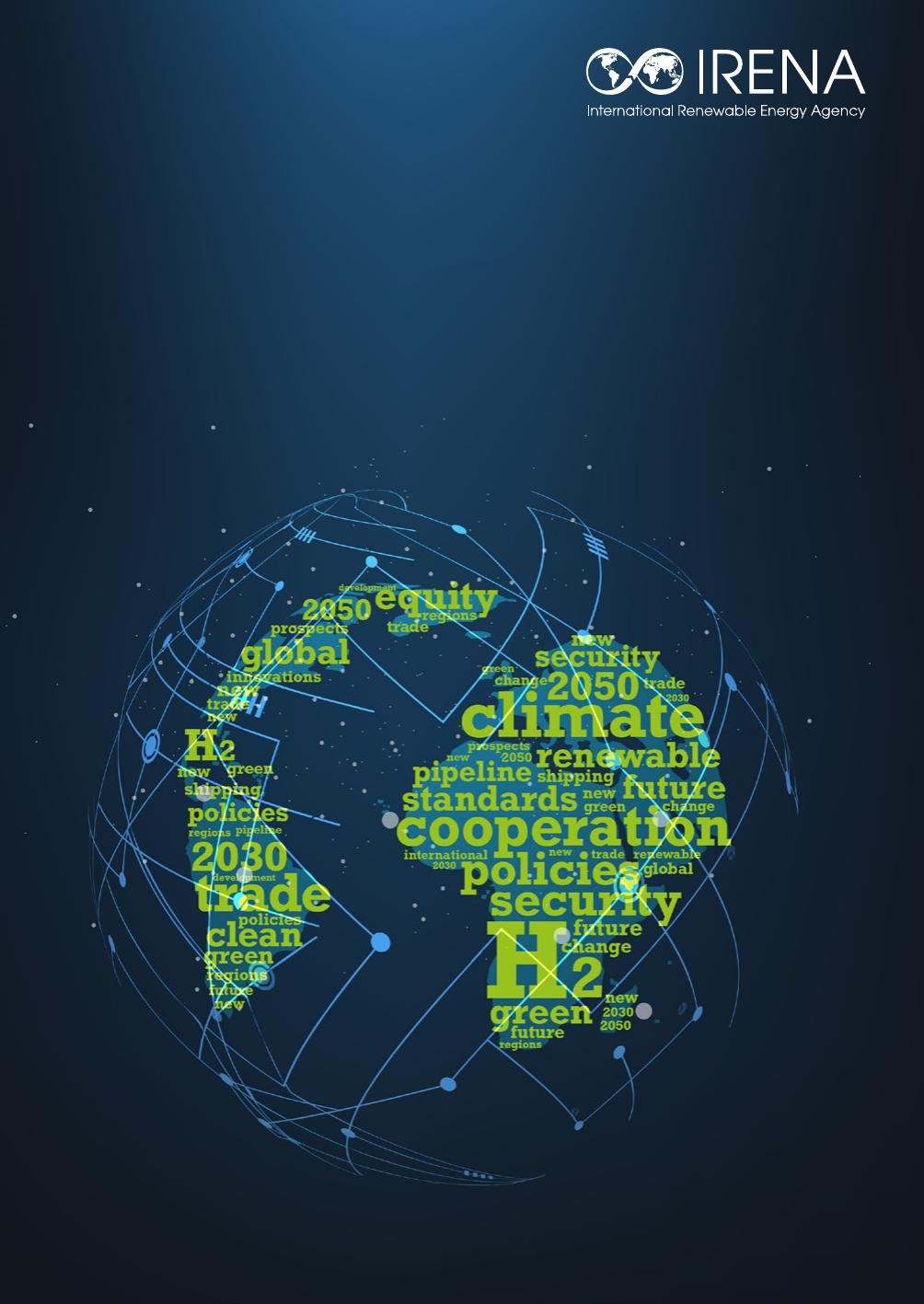GeopoliticsoftheEnergyTransformationTheHydrogenFactor©IRENA2022Unlessotherwisestated,materialinthispublicationmaybefreelyused,shared,copied,reproduced,printedand/orstored,providedthatappropriateacknowledgementisgivenofIRENAasthesourceandcopyrightholder.Materialinthispublicationthatisattributedtothirdpartiesmaybesubjecttoseparatetermsofuseandrestrictions,andappropriatepermissionsfromthesethirdpartiesmayneedtobesecuredbeforeanyuseofsuchmaterial.Citation:�IRENA(2022),GeopoliticsoftheEnergyTransformation:TheHydrogenFactor,InternationalRenewableEnergyAgency,AbuDhabi.ISBN:978-92-9260-370-0Availablefordownload:www.irena.org/publicationsForfurtherinformationortoprovidefeedback:info@irena.orgABOUTIRENATheInternationalRenewableEnergyAgency(IRENA)isanintergovernmentalorganisationthatsupportscountriesintheirtransitiontoasustainableenergyfutureandservesastheprincipalplatformforinternationalco-operation,acentreofexcellenceandarepositoryofpolicy,technology,resourceandfinancialknowledgeonrenewableenergy.IRENApromotesthewidespreadadoptionandsustainableuseofallformsofrenewableenergy,includingbioenergy,geothermal,hydropower,ocean,solarandwindenergy,inthepursuitofsustainabledevelopment,energyaccess,energysecurityandlow-carboneconomicgrowthandprosperity.www.irena.orgDISCLAIMERThispublicationandthematerialhereinareprovided“asis”.AllreasonableprecautionshavebeentakenbyIRENAtoverifythereliabilityofthematerialinthispublication.However,neitherIRENAnoranyofitsofficials,agents,dataorotherthird-partycontentprovidersprovideawarrantyofanykind,eitherexpressedorimplied,andtheyacceptnoresponsibilityorliabilityforanyconsequenceofuseofthepublicationormaterialherein.TheinformationcontainedhereindoesnotnecessarilyrepresenttheviewsofallMembersofIRENA.ThementionofspecificcompaniesorcertainprojectsorproductsdoesnotimplythattheyareendorsedorrecommendedbyIRENAinpreferencetoothersofasimilarnaturethatarenotmentioned.ThedesignationsemployedandthepresentationofmaterialhereindonotimplytheexpressionofanyopiniononthepartofIRENAconcerningthelegalstatusofanyregion,country,territory,cityorareaorofitsauthorities,orconcerningthedelimitationoffrontiersorboundaries.2ForewordFOREWORDFrancescoLaCameraDirector-GeneralInternationalRenewableEnergyAgencyTheacceleratingdeploymentofrenewableshassetinmotionaglobalenergytransformationwithfar-reachinggeopoliticalimplications.Thereport“ANewWorld”,releasedin2019byIRENA’sGlobalCommissionontheGeopoliticsoftheEnergyTransformation,wasthefirstforayintothisarea.Ithighlightedhowtheadventofanewenergyagewouldreshaperelationsbetweenstatesandcommunitiesandbringabouta“newworld”ofpower,security,energyindependenceandprosperity.Giventhefastpaceofchange,itiscriticaltomonitorthegeopoliticaldriversandimplicationsofthetransition,stayabreastofdevelopmentsandplayanactiveroleinshapingthefuture.In2020,theIRENAAssemblyrequestedtheAgencytoadvancethisworkundertheCollaborativeFrameworkontheGeopoliticsoftheEnergyTransformation.Hydrogenwasidentifiedasaprominentareaforfurtheranalysis,giventherecentsurgeofinterest.Severaltimesinthepast,hydrogenattractedmuchattentionbutremainedanicheintheglobalenergydiscourse.Today,thepolicyfocusisunprecendented,givenitscentralrolefordecarbonisationofharder-to-abatesectors.Therearestillmanyuncertaintiesabouthowthehydrogenmarketwilldevelop,whowillemergeasmarketleaders,andwhatthegeopoliticalimplicationsmaybe.Inwritingthisreport,IRENAprovidesaninformedanalysisabouthowtheseuncertaintiescouldplayout.Muchwilldependonthepolicyframeworksgovernmentsputinplace,includingtheincentivestheychooseagainstabackdropofthesocialandeconomicconsequencesofaglobalpandemic,theincreasinglyevidentclimateimpactsandtheurgencytodecreasethegapbetweenthehavesandhave-nots.IRENA’sWorldEnergyTransitionsOutlookenvisagesitcouldmeetupto12percentoffinalenergyconsumptionby2050.Toachievethis,itwillbeessentialtosettheprioritiesright,especiallyearlyon,whilemarketsaredevelopingandcostsarehigh.Andhydrogen’spositivecontributiontoclimateanddevelopmenteffortswillbeensuredonlywithtransparentandcrediblerulesandstandardsandacoherentsystemthattranscendsnational,regionalandsectoralboundaries.Crucially,withinternationalco-operation,theemerginghydrogenmarkethasthepotentialtobebothdecentralisedandinclusive,withopportunitiesfordevelopedanddevelopingcountriesalike.Wehavealongwaytogo.Forexample,justastheUNClimateConferencekickedoffinGlasgowinOctober2021anenergycrisistookholdofglobalenergymarkets.Thevolatilityofoilandgaspricestriggeredarangeofemergencymeasurestoreducetheimpactsonproducersandconsumersworldwide.Theseareastarkreminderofthepersistentcentralityoffossilfuelstothegeopoliticsofenergy.Theyalsounderscoretheurgencyofthemovetoresilientenergysystems,alignedwiththeclimateanddevelopmentimperativessetoutintheParisAgreementandtheAgenda2030.Today,governmentshaveauniqueopportunitytoshapetheadventofhydrogen,bycontributingtothedesignofmarketssupportiveoftheenergytransformationwhileavoidingexistinglimitationsandinefficiencies,reducinginequalities,andinfluencinggeopoliticaloutcomestowardscleanerandfairerenergysystems.Thechallengesaremany,butsoaretheopportunities.Ihopethatthisreportwillhelppolicymakersandstakeholderseffectivelynavigatetheunknowns,mitigaterisksandovercomeobstaclesintheyearsahead.IRENACollaborativeFrameworksareplatformsforpublic,private,andotheractorstoexchangeexperience,deepenanalyticalworkandpromoteinternationalcooperationonenergytransitions.3GeopoliticsoftheEnergyTransformationTABLEOFCONTENTSForeword................................................03Acknowledgments.........................................09SUMMARYFORPOLICYMAKERS...........................10INTRODUCTION.......................................181.1Thedawnofcleanhydrogen................................181.2Geopoliticalsignificanceofcleanhydrogen.....................211.3Objectivesofthereport..................................22THEROLEOFHYDROGENINTHEENERGYTRANSITION................................242.1Whatishydrogen?......................................242.2Mainproductionpathways.................................262.3Hydrogenapplicationsandprioritysetting.....................292.4Barrierstoscalinguphydrogen..............................312.5Prospectsforinternationalhydrogentrade.....................33REDRAWINGTHEGEOPOLITICALMAP...............383.1Policyfront-runnersandleadingmarkets......................393.2Anewclassofenergyexporters............................453.3Transitionpathwayforfossilfuelproducers....................493.4Riseofnewtechnologyleaders.............................553.5Industrialdevelopmentinrenewables-richcountries..............650102034©cokada/istockTheHydrogenFactorTRADE,SECURITY,ANDINTERDEPENDENCE.........684.1Anewgeographyoftrade.................................704.2Shapingtherulesofthegame..............................744.3Hydrogendiplomacy.....................................764.4Shiftsinpoliticalrelations.................................784.5Greaterenergysecurity...................................814.6Traderisksandvulnerabilities..............................85THEROOTCAUSESOFGEOPOLITICALINSTABILITY–ANDHYDROGEN’SROLEINADDRESSINGTHEM....925.1Socio-politicaltransformations.............................935.2Climatechange,waterstressandfoodinsecurity................965.3Hydrogenandthedevelopingworld.........................102POLICYCONSIDERATIONSANDTHEWAYFORWARD.................................104References.............................................108Tableofcontents0405065GeopoliticsoftheEnergyTransformationLISTOFFIGURESFigureS.1Shiftsinthevalueoftradeinenergycommodities,2020to2050......................11FigureS.2Anexpandingnetworkofhydrogentraderoutes,plansandagreements...............12FigureS.3Cleanhydrogenpolicypriorities........................................................14Figure1.1Estimatesforglobalhydrogendemandin2050........................................20Figure2.1Hydrogenconsumptionin2020........................................................25Figure2.2Selectedcolour-codetypologyofhydrogenproduction...............................26Figure2.3Potentialusesforcleanhydrogen......................................................29Figure2.4Cleanhydrogenpolicypriorities.......................................................30Figure2.5Mainperceivedbarrierstodevelophydrogenpoliciesandstrategies..................32Figure2.6Worldsolartechnicalpotential.........................................................33Figure2.7Worldwindtechnicalpotential.........................................................34Figure2.8Costefficiencyoftransportoptionswhenconsideringvolumeanddistance.........35Figure2.9Anexpandingnetworkofhydrogentraderoutes,plansandagreements................37Figure3.1Hydrogenstrategiesandthoseinpreparation,October2021............................39Figure3.2Averageannualfundingpotentiallyavailableforhydrogenprojects,2021-2030..............................................................................42Figure3.3CleanhydrogenprojectsandinvestmentasofNovember2021........................43Figure3.4TechnicalpotentialforproducinggreenhydrogenunderUSD1.5/kgby2050................................................................................45Figure3.5Impactofcostassumptionsonhydrogenproductionofselectedcountries............47Figure3.6Strandedassetriskformajornetfossilfuelexporters,2019...........................50Figure3.7Expertviewsonhydrogenstrategiesandimpactsforoilandgasproducers...........51Figure3.8Expertviewsonfuturehydrogenrevenuesandmarketstructure......................54Figure3.9Technologyleadershipopportunitiesingreenhydrogenvaluechains.................55Figure3.10Geographicdistributionofhydrogen-relatedpatentfamilies,2010-2020..............56Figure3.11Flowofinventionsinhydrogentechnology,2010-2020................................58Figure3.12Estimatedmarketpotentialforhydrogenequipmentandcomponents,2050..........59Figure3.13Estimatedglobalelectrolysermanufacturingcapacity2021-2024,basedoninvestmentplans..............................................................61Figure3.14Fuelcellsales,byregionofadoption,2016-2020......................................636GREENHYDROGENTableofcontents©DilokKlaisataporn/istockTheHydrogenFactorLISTOFFIGURES(continued)Figure4.1IRENAMemberviewsonimplicationsofhydrogenonforeignpolicyby2030.........69Figure4.2Shiftsinthevalueoftradeinenergycommodities,2020to2050.....................70Figure4.3Globalmapofnaturalgastransmissionpipelines......................................73Figure4.4PossiblehydrogenroutesacrossAfricaalongexistingandfuturetrans-Africanhighways.................................................................75Figure4.5�SelectedcountrybilateraltradeagreementsandMOUs,announcedasofNovember2021...................................................................77Figure4.6Theworld’s20largestannouncedgiga-scalegreenhydrogenprojects................87Figure4.7Topproducersofcriticalmaterialsinelectrolysers......................................91Figure5.1Expertviewsonhydrogen’simpactonselectedsustainabledevelopmentoutcomesby2050.......................................................93Figure5.2Countriesinwhichgreenhydrogencouldpossiblybecomecheaperthanbluehydrogen,byyear............................................................94Figure5.3Waterconsumptionofhydrogenin2050comparedwithselectedsectorstoday.................................................................98Figure5.4Heatmapofwaterstresslevels........................................................997©MarsYu/istockGeopoliticsoftheEnergyTransformationLISTOFTABLESTable2.1Mainelectrolysertechnologycomparison................................................28Table3.1Historicexamplesoflarge-scaleelectrolysishydrogenproductionplants................60Table3.2Theeconomicsofindustriallocationchoice..............................................66Table5.1Sevenwaysinwhichclimatechangethreatensstability..................................96LISTOFBOXESBox1.1Keytermsusedinthisreport..............................................................19Box1.2Keyprojectionsofhydrogenuseby2050inIRENA’s1.5°Cscenario......................23Box2.1Whatisanelectrolyser?..................................................................28Box2.2Geopoliticsofhydrogensurveys.........................................................32Box2.3Threemainwaystotransporthydrogenbyship..........................................36Box3.1Earlyadopters?Hydrogenvisionsinselectedfront-runnercountriesandregions........40Box3.2HydrogenprojectsinAfrica..............................................................44Box3.3Theimportanceofcapitalcostassumptionsforhydrogentradeprojections.............46Box3.4Fromenergyimportertoexporter?Hydrogenactivitiesinselectedfossil-fuelimportingcountrieswithgreenhydrogenexportpotential...............................48Box3.5Pivotingtohydrogen?Hydrogenstrategiesofselectedfossil-fuelexportingcountries.......................................................................52Box4.1InfrastructureopportunitiesforAfricaintheshippingsector............................72Box4.2Theemergenceofhydrogendiplomacy..................................................79Box4.3Mitigatingvolumeandpriceriskinhydrogentrade:lessonsfromthedevelopmentoftheliquefiednaturalgasmarket.......................868ACKNOWLEDGEMENTSThisreporthasbeendevelopedundertheguidanceofElizabethPressandauthoredbyThijsVandeGraaf(IRENAconsultantandleadauthor),HeribBlanco,EmanueleBiancoandWaimanTsang.RabiaFerroukhiandDolfGielenprovidedexpertguidanceandoversight.ValuablecontributionswereprovidedbyIRENAcolleagues:RolandRoesch,FranciscoBoshell,FrancescoPasimeni,PaulKomor,AnastasiaKefalidou,ClaireKiss,EmanueleTaibi,UteCollier,KathleenDaniel,ImenGherboudj,BarbaraJinks,JeffreyLu,StefanoMarguccioandKellyRigg(IRENAconsultant).Manygovernmentofficialsandinternationalexpertsalsoprovidedinputandrevieweddraftsofthereport.Theircommentsandsuggestionswereofimmensevalue.TheyincludeRonnieBelmans(KULeuven),LeonardoBeltrano(ColumbiaCenteronGlobalEnergyPolicy),PeterBetts,KingsmillBond(CarbonTracker),HugoBrouwer(MinistryofForeignAffairs,Netherlands),MelindaCrane,MatthiasDeutsch(AgoraEnergiewende),GonzaloEscribano(RealInstitutoElcano),HanFeenstra(MinistryofEconomicAffairsandClimatePolicy,Netherlands),LisaFischer(E3G),GniewomirFlis(AgoraEnergiewende),JonathanGaventa(E3G),HansOlavIbrekk(MinistryofForeignAffairs,Norway),RuudKempener(Directorate-GeneralforEnergy,EuropeanCommission),HolgerKlitzing(FederalForeignOffice,Germany),JamesMnyupe(OfficeofthePresident,Namibia),PaulMunnich(AgoraEnergiewende),AlejandroNuñez-Jimenez(HarvardUniversityandETHZurich),IndraOverland(NUPI),KarstenSach(MinistryfortheEnvironment,Germany),BeatrixSchmuelling(MinistryofClimateChangeandEnvironment,UnitedArabEmirates),GriffinThompson(LoyolaUniversityChicago),NikosTsafos(CSIS),TatianaUlkina(SNAM),CobyvanderLinde(Clingendael),KirstenWestphal(H2GlobalStiftung),RalfVermeer(MinistryofForeignAffairs,Netherlands)andFrankWouters(RelianceIndustries).ThisreportalsobenefittedfromIRENA’sCollaborativeFrameworkonGeopoliticsofEnergyTransformation,whichmetontwooccasionstodiscussthetopic.Manyexpertsalsoparticipatedinsurveysthatinformedthereport’sdevelopmentandprovidedvaluablecomments.TheyincludeiMarcoBaroni,ErinM.Blanton,NoamBoussidan,JamesBowen,MichaelBradshaw,AndyCalitz,KilianCrone,FernandodeSisternes,ChristianDownie,ReshmaFrancy,JulioFriedmann,ArunabhaGhosh,MarcoGiuli,ChrisGoodall,MariaA.Gwynn,LiorHerman,WouterJacobs,SohbetKarbuz,ThierryLepercq,RobinMills,EleonoraMoro,MonicaNagashima,MichelNoussan,MostefaOuki,JorgePena,CédricPhillibert,RainerQuitzow,AurangzebQureshi,AlisonReeve,BarisSanli,MassimoSantarelli,RobertoSchaeffer,DanielScholten,RossanaScita,RadiaSedaoui,AdnanShihabeldinandTomSmolinka.Thepublication,communicationsandeditorialsupportwereprovidedbyStephanieClarke,DariaGazzola,NIcoleBockstallerandDamianBrandy.Thereportwascopy-editedbyStevenB.Kennedy.Thegraphicdesignwasdonebyweeks.deWerbeagenturGmbH.IRENAisgratefulforthegeneroussupportoftheFederalForeignOfficeofGermany,andtheMinistryofForeignAffairsofNorwaywhichmadethisreportpossible.iThosethatarelistedherereflecttheexpertsthathaveconsentedtobeingnamed.TheHydrogenFactorAcknowledgements9Theongoingenergytransitionisunprecedentedduetoitsscaleandtheprofoundimpactontheestablishedsocio-economic,technological,andgeopoliticaltrendsaroundtheworld.Renewables,incombinationwithenergyefficiency,nowformtheleadingedgeofafar-reachingglobalenergytransition.Thistransitionisnotafuelreplacement;itisashifttoadifferentsystemwithcommensuratepolitical,technical,environmental,andeconomicdisruptions.Thecentralquestionthisreportaddressesiswhetherandtowhatextenthydrogenexacerbatesormitigatesthesedisruptionsandinwhatways.Hydrogen,untilnowthemissingpieceofthecleanenergypuzzle,islikelytofurtherdisruptenergyvaluechainsincomingyears.Theclimatechangeimperativehasbeenthemaindriveroftherenewedpolicyfocusonhydrogen.IRENA’s1.5°Cscenarioenvisagesthatcleanhydrogen1couldmeetupto12%offinalenergyconsumptionby2050.Majorityofthiswouldbeproducedusingrenewables,withtherestfromgasandcarboncaptureandstorage.Hydrogenislikelytoinfluencethegeographyofenergytrade,furtherregionalisingenergyrelations.Withthecostsofrenewableenergyfalling,butthoseoftransportinghydrogenhigh,theemerginggeopoliticalmapislikelytoshowgrowingregionalisationinenergyrelations.Renewablescanbedeployedineverycountry,andrenewableelectricitycanbeexportedtoneighbouringcountriesviatransmissioncables.Inaddition,hydrogencanfacilitatetransportoftheenergyrenewablesproduceoverlongerdistancesviapipelinesandshipping,thusunlockinguntappedrenewableresourcesinremotelocations.Someexistingnaturalgaspipelines,withtechnicalmodification,couldberepurposedtocarryhydrogen.Countrieswithanabundanceoflow-costrenewablepowercouldbecomeproducersofgreenhydrogen,withcommensurategeoeconomicandgeopoliticalconsequences.Greenhydrogencouldbemosteconomicalinlocationsthathavetheoptimalcombinationofabundantrenewableresources,spaceforsolarorwindfarms,andaccesstowater,alongwiththecapabilitytoexporttolargedemandcentres.Newpowernodescouldariseinplacesthatexploitthesefactorstobecomecentresofhydrogenproductionanduse.Thehydrogenbusinesswillbemorecompetitiveandlesslucrativethanoilandgas.Cleanhydrogenwillnotgeneratereturnscomparabletothoseofoilandgastoday.Hydrogenisaconversion,notanextractionbusiness,andhasthepotentialtobeproducedcompetitivelyinmanyplaces.Thiswilllimitthepossibilitiesofcapturingeconomicrentsakintothosegeneratedbyfossilfuels,whichtodayaccountforsome2%ofglobalGDP.Moreover,asthecostsofgreenhydrogenfall,newanddiverseparticipantswillenterthemarket,makinghydrogenevenmorecompetitive.1Thepresentreportreferstothismixofgreenandbluehydrogenas“cleanhydrogen”.AlsoseeFigure2.2.GeopoliticsoftheEnergyTransformationSummaryforPolicymakers10Hydrogentradeandinvestmentflowswillspawnnewpatternsofinterdependenceandbringshiftsinbilateralrelations.Afast-growingarrayofbilateraldealsindicatesthatthesewillbedifferentfromthehydrocarbon-basedenergyrelationshipsofthe20thcentury.Morethan30countriesandregionshavehydrogenstrategiesthatincludeimportorexportplans,indicatingthatcross-borderhydrogentradeissettogrowconsiderably.Countriesthathavenottraditionallytradedenergyareestablishingbilateralrelationscenteringonhydrogen-relatedtechnologiesandmolecules.Aseconomictiesbetweencountrieschange,somighttheirpoliticaldynamics.FigureS.1Shiftsinthevalueoftradeinenergycommodities,2020to2050Source:IRENA(2022).AmmoniaBioenergyCoalElectricityGasHydrogenMethanolOil2050USD1.6trillion2020USD1.5trillionOilOilBHGasGasMethanolElectricityElectricityCoalAmmoniaBioenergyCoalElectricityGasHydrogenMethanolOil2050USD1.6trillion2020USD1.5trillionOilOilAmmoniaBioenergyMethanolHydrogenGasGasMethanolElectricityElectricityCoalTheHydrogenFactor11Hydrogendiplomacyisbecomingastandardfixtureofeconomicdiplomacyinseveralcountries.Accesstohydrogenisoftenseenasanelementofenergysecurity,andoverallnationalresilience,particularlyforindustrieswhereothersolutionsarenotfeasibleoruneconomical.Somecountriesthatexpecttobeimportersarealreadyengagedindedicatedhydrogendiplomacy.GermanyandJapanhavebeentrailblazers,butothercountriesarefollowingclosebehindthem.Potentialexportersaredeployingsimilarstrategies,withmanyincludinghydrogen–greenhydrogeninparticular–atthehighestlevelsoftheirdiplomacy.Fossil-fuelexportersconsidercleanhydrogenanattractivewaytodiversifytheireconomies.Manycurrentexportersarepivotingtocleanhydrogentodevelopnewexportindustries.Theycanleverageestablishedenergyinfrastructure,askilledworkforceandexistingenergytraderelations.Whilebluehydrogenseemslikeanaturalfit,manyfossil-fuelproducingcountrieshaveamplerenewablepotentialtoshiftdirectlytothegreenvarietyaswell.UnitedArabEmirates’HydrogenLeadershipRoadmapisexplicitlytakingsuchdualapproach,andseveralothersareexploringthispathincludingAustralia,OmanandSaudiArabia.Nevertheless,fossil-fuelproducersshouldcontinuetodevelopbroad-basedeconomictransitionstrategies,giventhathydrogenwillnotcompensateforlossinrevenues.ImporterNewroutesinplaceorunderdevelopmentExporterMoUsinplaceestablishingtraderoutesPotentialtraderouteexplicitlymentionedinpublishedstrategiesImportingregionExportingregionNorthAfricaAsiaPacificLatinAmericaEuropeFigureS.2Anexpandingnetworkofhydrogentraderoutes,plansandagreementsMapsource:NaturalEarth,2021Notes:Informationonthisfigureisbasedontheinformationcontainedingovernmentdocumentsatthetimeofwriting.Disclaimer:Thismapisprovidedforillustrationpurposesonly.BoundariesandnamesshownonthismapdonotimplyanyendorsementoracceptancebyIRENA.GeopoliticsoftheEnergyTransformation12Thetechnicalpotentialtoproducegreenelectricity–and,inturn,largeamountsofgreenhydrogen–exceedsestimatedglobaldemandbyseveralordersofmagnitude.Manycountrieshavedeclaredtheirambitiontobecomeexportersofhydrogen,limitingthelikelihoodofexportconcentration.Judgingbytheirstrategiesandgrowingbilateraldeals,evennetenergyimporterssuchasChile,MoroccoandNamibiaseempoisedtobecomegreenhydrogenexporters.However,thesupplyofhydrogenwillbeconstrainedbythepaceofdeploymentofcapitalandcostofproduction,particularlywherelong-termmarketsarenotassured.Africa,theAmericas,theMiddleEastandOceaniahavethehighesttechnicalpotentialforgreenhydrogenproduction.Theabilitytoproducelargevolumesoflow-costgreenhydrogen,however,varieswidely.Countrieswillhavetosettheirstrategiesinlightofbroadersocialandeconomicpriorities,includingtheabilitytodecarbonisetheirenergysystemsortackleenergyaccessandpoverty,currentlyprevailinginover80countriesworldwide.Havingaccesstoabundantrenewablesisanassetinthecleanhydrogenrace,butitmightnotbeenough.Manyotherfactorscomeintoplay,includingexistinginfrastructureandthecurrentenergymix,alongwiththecostofcapitalandaccesstonecessarytechnologies.Whetherthetechnicalpotentialcanberealisedwillalsodependonsoftfactorslikegovernmentsupport,theinvestmentclimateandpoliticalstability.Higherprojectfinancecostsdonotnecessarilyimpedeinvestmentincountrieswithhigherriskprofiles.Theupstreamoilandgassectorsshowthatwhererevenuepotentialissufficient,investmentwillflowindespitecountryrisk.Thesameshouldapplytocountriesshowingalow-costpotentialforgreenhydrogen.Therearelimits,ofcourse.Countriesinturmoil,someofwhichhavegreatpotential,areunlikelytobeabletorealiseinvestmentopportunitiesowingtotheimmenserisksofdoingbusinessinsuchlocations.TheHydrogenFactor13The2020scouldbecometheeraofabigracefortechnologyleadership,ascostsarelikelytofallsharplywithlearningandscaling-upofneededinfrastructure.Thegeopoliticsofcleanhydrogenislikelytoplayoutinseveralstages.Greenhydrogenisprojectedtostartcompetingwithblueoncostbytheendofthisdecade.ThisseemslikelytooccursoonerincountriessuchasChina(thankstoitslow-costelectrolysers),orBrazilandIndia(withcheaprenewablesandrelativelyhighgasprices).GreenhydrogenwasalreadymoreaffordablethangreyacrossEuropeduringthe2021spikeinnaturalgasprices.Buttheuptakewillgreatlydependonpredictabledemand,especiallyinhardertoabatesectorswherenoalternativesexist.ELECTRIFICATIONMaturityofhydrogensolutions(comparedwithotherdecarbonisationsolutions)DistributedapplicationsCentralisedapplicationsHYDROGENHIGHPRIORITYSeasonalstorageInternationalshippingSteelRefineriesLong-haulaviationHightemperatureheatingResidentialheatingMidtemperatureheatingUrbanvehiclesShort-termstorageRegionaltrucksShort-haulaviationLong-haultrucksFerriesTrains02468100,00,20,40,60,81,0LOWPRIORITYSources:IRENA(forthcoming-b).FigureS.3CleanhydrogenpolicyprioritiesGeopoliticsoftheEnergyTransformation14Cross-bordertradingofhydrogenwillincreaseinthe2030s,atpacewiththecost-competitivenessofgreenhydrogen.Acrossmanydecarbonisationscenarios,demandstartstotakeofffrom2035.IRENAenvisagesthattwo-thirdsofgreenhydrogenproductionin2050wouldbeusedlocally,andone-thirdtradedacrossborders.Pipelines,includingadaptednaturalgaspipelines,arelikelytofacilitatehalfofthistrade.Theotherhalfwouldbeloadedonshipsintheformofhydrogenderivatives,notablyammonia.Intheshorttomediumterm,countriesandregionscanasserttechnologyleadershipandshapetherulesofthegrowingmarket.Havingastakeinthehydrogenvaluechaincanboosteconomiccompetitiveness.Thedirecteconomicstakesarehigh,andthemarketpotentialisconsiderable.Inthelongrun,countrieswithamplerenewablepotentialcouldbecomesitesofgreenindustrialisation,usingtheirpotentialtoattractenergy-intensiveindustries.Equipmentmanufacturingoffersanopportunitytocapturevalueinthecomingyearsanddecades.Thehydrogenvaluechainisextensive,andthebulkofinvestmentwillbeneededforrenewablepower.Alongthisvaluechain,estimatespointtoaUSD50-60billionmarketpotentialforelectrolysersandaUSD21-25billionmarketforfuelcellsbythemiddleofthecentury.China,EuropeandJapanhavedevelopedastrongheadstartinproducingandsellingelectrolysers,butthemarketisstillnascentandrelativelysmall.Innovationandemergingtechnologiescanchangethecurrentmanufacturinglandscape.Anyformofhydrogenmaystrengthenenergyindependenceandresilience,butmostofthebenefitsstandtocomefromgreenhydrogen.Today,therearethreemainwaysinwhichhydrogencanbolsterenergysecurity:1)byreducingimportdependence,2)bymitigatingpricevolatilityand3)byboostingtheflexibilityandresilienceoftheenergysystem,throughdiversification.Mostofthesebenefitsareassociatedwithgreenhydrogen.Conversely,bluehydrogenwouldfollowthepatternsofgasmarkets,resultinginimportdependenciesandmarketvolatilities.Moreover,theexpectedcostreductioningreenhydrogenmeansthatinvestmentsinsupplychainsbasedonfossilfuels–especiallyassetsplannedtostayinoperationformanyyears–mayendupstranded.Therawmaterialsneededforhydrogenandrenewableenergytechnologiesarelikelytodrawmoreattentiontomaterialsecurity.Whilegeologicalsuppliesformostmineralsandmetalsarepresentlysufficient,marketscouldbecomeverytightowingtorapidlyrisingdemand,andthelongleadtimesofminingandrefiningprojects.Arelativelysmallshiftinsupplyordemandcancausesignificantpricefluctuations.Suchfluctuationscouldreverberatethroughhydrogensupplychainsandaffecttheoverallcostofequipment,alongwiththerevenuesofminersandexportersofrawmaterials.SupplychainproblemscausedbyCOVID-19arealsoinstructivewhenconsideringpossiblerisksbeyondthosealreadywell-known.TheHydrogenFactor15Hydrogentradeflowsareunlikelytobecomeweaponisedorcartelised.Thisisbecausehydrogencanbeproducedfrommanyprimaryenergysourcesandinawidevarietyofplacesworldwide.Indeed,itisamanufacturedproductratherthanarawmaterialorenergysource.Therefore,greenenergytradeflowsareunlikelytolendthemselvesaseasilytogeopoliticalinfluenceasoilandgas.Thatsaid,supplyshortagescouldarise,particularlyintheearlyyearsofhydrogentrade,whenthenumberofsuppliersislimitedandmosttradeisstillgovernedbybilateralarrangements.Shapingtherules,standardsandgovernanceforhydrogentradewillhaveasignificantimpactindeterminingwhichtechnologiesdominatefuturemarkets.Thesuccessofcleanhydrogenmarketshingesupontheabilitytosetcoherentandtransparentrules,standardsandnormstofacilitateitsdeploymentacrosscountries,regionsandsectors.Standardsaredesignedtoimprovethequality,safety,andinteroperabilityofvariousgoodsandservices.Atthesametime,divergentstandardscouldslowdownprogressandleadtomarketfragmentation,stirregulatorycompetition,anderecttradebarriers.Settingstandardscouldbeanarenaforgeopoliticalcompetitionorinternationalco-operation.Ultimately,allplayerscangainfromacoherentandtransparentglobalsystem.Certificatesoforiginrootedinatransparentandcredibleinternationalsystemwillbeneededtomonitorandmanagehydrogen’scontributiontoclimatechangeefforts.Transparencyinhowemissionsaremeasuredwillbeessential.Therearewell-knownrisksofcarbonlock-inifhydrogenstrategiesprolongfossilfueluseandhinderenergyefficiencyandelectrification.Robustandwell-thought-outpolicyframeworkscanhelpensurethathydrogeneffectivelycontributestoreducinggreenhousegasemissions.Pricetransparencyearlyonwouldsupporttherapidevolutionoftheglobalmarketinhydrogen.Thecurrenciesandpricingmechanismsthattakeholdintheemergingmarketarelikelytohaveconsiderablegeopoliticaleffects.Thecurrencychosenwillbepositionedtobecomeaglobalbenchmarkasthemarketexpands.Thoseassociatedwiththatcurrencywilltosomedegreebeshelteredfromexposureduetofluctuatingimportcosts.Forinstance,theEuropeanUnion,likelytobecomeoneofthekeyimportmarkets,seekstodenominateitsfuturehydrogenimportsineuros.Moreover,puttingapriceoncarbonmightbehelpful,orevennecessary,tomakegreenhydrogencompetitivewiththegreyvariantand,ultimately,withfossilfuels.Inthatsense,hydrogenmaybecomeembroiledinabroadersetofcarbontradewars.GeopoliticsoftheEnergyTransformation16Investmentdecisionsarelong-livedandtherisksofstrandedassetshigh,sofixedinfrastructureshouldbeassessedwithalong-termlogic.Everyinvestmentandplanningdecisionaroundenergyinfrastructuretodayshouldconsiderthatthegeographyofadecarbonisedeconomyislikelytobeverydifferentfromwhatcurrentlymakessense.Significantelectrificationofenduseswillreshapedemand.Onthesupplyside,renewablehydrogenproductionwilllikelyoccurinlocationsotherthantoday’soilandgasfields.Whilesomeoftheexistinginfrastructurecouldberepurposed,thetechnicalchallengesandeconomiccostsofsuchrepurposingshouldbeaccountedforfromtheoutset.Helpingdevelopingcountriesdeployhydrogentechnologiesearlyoncouldimproveenergysecurityforall,whilepreventingtheglobaldecarbonisationdividefromwidening.Adiversehydrogenmarketwouldreducesupplychainrisksandimproveenergysecurityforall.Accesstotechnology,training,capacitybuildingandaffordablefinancewillbekeytorealisingthefullpotentialofhydrogentodecarbonisetheglobalenergysystemandcontributetoglobalstabilityandequity.Establishinghydrogentraderelationscouldopennewpossibilitiestosetuplocalhydrogenvaluechains,stimulategreenindustriesandcreatejobsincountriesrichinrenewables.Globaleffortsshouldfocusontheapplicationsthatprovidethemostimmediateadvantagesandenableeconomiesofscale,particularlyinthecomingyears.Prioritisinghigh-demandapplicationsforwhichhydrogenisthebest—andperhapstheonly—alternativeismorelikelytobecost-effectiveandlesssusceptibletotherisksofnascentmarkets.Oneexamplecouldbesupportingandthenacceleratingashifttogreenhydrogeninindustrialapplicationswherehydrogenisalreadyused,suchasrefiningandtheproductionofammoniaandmethanol.Dependingonhowitisdeveloped,hydrogencouldhavebothpositiveandnegativeeffectsonsustainabledevelopment.Theconceptof“humansecurity”isoftenusedtodescribetherootcausesofgeopoliticalinstabilitytoaccountforthreatssuchasclimatechange,povertyanddisease,whichcanunderminepeaceandstabilitywithinandbetweencountries.Goingforward,itwillbeimportanttogaingreaterunderstandingofthemultidimensionalnatureofglobalthreatsandvulnerabilitiestoforeseeanddefusecertainrisksthatmaycomewiththedeploymentofhydrogenonamajorscale.TheHydrogenFactor17INTRODUCTIONCHAPTER1©atkwork/shutterstock.comGeopoliticsoftheEnergyTransformation0121.1THEDAWNOFCLEANHYDROGENInrecentyears,hydrogenhasrisenuptheagendaasapotentialmissingpieceofthecleanenergypuzzle.Agrowingnumberofcountriesnowhaveanationalhydrogenroadmaporstrategy,andasizeableportionoftheCOVID-19stimulusandrecoveryfundshavebeendedicatedtotheaccelerationofhydrogen.Atthe2021UnitedNationsClimateChangeConference(COP26)inGlasgow,32countriesandtheEuropeanUnion(EU)agreedtoworktogethertoacceleratethedevelopmentanddeploymentofcleanhydrogen(Box1.1)andensurethat“affordablerenewableandlow-carbonhydrogenisgloballyavailableby2030”(UNFCCC,2021).18BOX1.1KEYTERMSUSEDINTHISREPORT•�Cleanhydrogenreferstobothgreenhydrogenandbluehydrogen.Althoughbothtypesmayplayaroleintheenergytransition,forthepurposeofthisreport,bluehydrogenwasconceptualisedas“clean”wheremethaneemissionsareextremelylowandwithveryhighcarboncapturerates.•�Low-carbonhydrogenreferstobluehydrogenthatdoesnotmeettheemissionstandardsaboveandtohydrogenmadewithgrid-poweredelectrolysiswherethegridisnotdecarbonised.•�Hydrogenderivativesrefertothedownstreammoleculesintowhichhydrogencanbeconverted(e.g.ammonia,methanol,syntheticfuels).Whentheseproductsareproducedwithhydrogenfromelectrolysis,theyareknownas“Power-to-X”products.•�Syntheticfuelsrefertoavarietyofgaseousandliquidfuelsproducedfromhydrogenandcarbon,includingsynthetickerosene,syntheticdieselandothers.Whenhydrogenisproducedbyelectrolysis,thesefuelsarealsoreferredtoas“powerfuels”or“e-fuels”.Theycanbeusedas“drop-in”fuels,astheycanbeusedinconventionalenginesandfuelsupplyinfrastructure.TheHydrogenFactor01IntroductionHydrogenhasspurredmultiplewavesofinterestinthepastwithoutsignificantimpact.Twofactorsmakethistimedifferent.First,governmentsworldwidehaveralliedbehindthetargetofnetzeroemissionsbythemiddleofthiscentury(Blacketal.,2021).Havingareasonablechanceoflimitingglobaltemperatureriseto1.5°C,thegoallaidoutinthe2015ParisAgreement,requiresreachingnetzeroemissionsby2050(IPCC,2021).Todoso,allsectorsoftheeconomyneedtocuttheiremissions,includingheavyindustryandlong-haultransport,wherelimitedsolutionsexist.Hydrogenhasemergedasakeyoptionforreducingemissionsinthesesectors.Second,theplummetingcostsofrenewablesandelectrolysersareimprovingtheeconomicattractivenessof"green"hydrogen–thatis,hydrogenproducedthroughtheelectrolysisofwaterpoweredbyrenewableelectricity.Theincreasingshareofvariablerenewables,suchaswindandphotovoltaic(PV)solarpower,alsocreatesdemandforflexibilityandstorage,whichhydrogencanhelpdeliver.Greenhydrogencanthuscomplementandextendtheongoingrevolutioninrenewableelectricity.Asaresultofthesefactors,hydrogenandhydrogen-basedfuelsarenowprojectedtomeetasizeableshareoffinalenergydemandin2050,upfromvirtuallynothingtoday(Figure1.1).Inalloftheseprojections,current“grey”hydrogenproduction(basedonfossilfuels)iscompletelyphasedout,andgreenhydrogenisthedominantproductionpathway,complementedby“blue”hydrogen,whichisbasedonfossilfuelswithcarboncaptureandstorage(CCS).19©Audioundwerbung/shutterstock.comGeopoliticsoftheEnergyTransformationFigure1.1Estimatesforglobalhydrogendemandin2050Sources:BloombergNEF(2021a);ETC(2021);HydrogenCouncil(2021);IRENA(2021a);IEA,(2021a).Notes:TheInternationalEnergyAgencyrefersto“fossil-basedwithCCUS”(carboncapture,utilisationandstorage)and“electrolysis-based”hydrogen.TheHydrogenCouncilprojectsthat60-80%ofhydrogenproductionwillberenewablesbased,withtherest“low-carbon”,whichitdefinesas“hydrogenproducedfromenergysourcesofnon-renewableoriginwithacarbonfootprintbelowadefinedthreshold”.Currenthydrogenproductionincludeshydrogencreatedasby-productfromotherprocesses.7006005004003002001000Hydrogenproduction(Milliontonnes)202020502050IEANetZeroScenario2050ETCSupply-sidedecarbonisationonlyscenario2050BNEFGreenScenario2050HydrogenCouncilIRENA1.5°CscenarioCurrenthydrogenproductionGreenhydrogenBluehydrogenGreyhydrogenPercentoffinalenergydemandElectrolysis-basedhydrogen0%12%13%18%22%22%20GREENHYDROGEN©Jayjune69/shutterstock.comTheHydrogenFactor01Introduction1.2GEOPOLITICALSIGNIFICANCEOFCLEANHYDROGENBuildingupglobalcleanhydrogenvaluechainswillbringgeoeconomicandgeopoliticalshifts.Mostnotably,greenhydrogenisemergingasapotentialgamechangerforreducingemissionsandachievingclimateneutralitywithoutstymyingeconomicandsocialdevelopment.Theeconomicstakesarehigh.CurrentannualhydrogensalesrepresentamarketvalueofapproximatelyUSD174billion,whichalreadyexceedsthevalueofannualtradeinliquefiednaturalgas(LNG).2Evenifhydrogen’suseislimitedtoindustrialprocessesandlong-distancetransport,itsmarketpotentialisenormous.Asinglesteelplantusinghydrogenratherthanfossilfueltoreduceironwouldutiliseabout300000tonnesofhydrogenannually,absorbingtheoutputof5gigawatts(GW)ofelectrolysers(MissionPossiblePartnership,2021).Globalelectrolysercapacitytodaystandsatjustover0.3GW.Accordingtomajorinvestmentbanks,by2050,globalsalesofhydrogencouldbeworthUSD600billion(FinancialTimes,2021),andthevaluechainsofgreenhydrogencouldbecomeaUSD11.7trillioninvestmentopportunityoverthenext30years,3coveringeverythingfromdedicatedrenewablecapacityandelectrolysers,totransportinfrastructure(GoldmanSachs,2020).Hydrogen’stransformativereachgoesbeyonditsestimatedmarketvalue.Itisbestthoughtofasageneral-purposeenergycarrierthatcanfosterinnovationacrossmanydifferentindustriesandsectors.Itsgeopoliticalimpactmightfollowthepatternsofsteampower,electricity,ortheinternalcombustionengine.Eachintheirownway,thesetechnologieshavetransformedthemachinesandfuelsonwhichmuchofourmoderncivilizationruns.Intheprocess,theyhavealsoaffecteddifferentaspectsofhumanlife,alteredglobaltradepatterns,andshapedtheglobalbalanceofpower.Whilethesetechnologieshavebroughtmanybenefitstohumankind,thebenefitshavenotbeenfairlydistributed.Theyhavethereforesaddledsocietieswithnewexternalitiesandglobalchallenges.2ThevalueofglobalLNGtradestoodatUSD143billionin2019(UNComtrade,2021).3Includesrenewablepower,hydrogenpowerplants,electrolysersandgaspipelinereconfiguration.21©imaginima/istockphoto.comGeopoliticsoftheEnergyTransformationComparedtotheseepoch-definingtechnologies,cleanhydrogen’simpactwilllikelybesmaller,butitshouldnotbebrushedasidetooquickly.Behindthesimplechemicalformulaofhydrogengas(H2),liesanentiresystemofinfrastructuretoproduce,transport,convertandusehydrogen.Suchasystemcouldcreatenewconnectionsbetweenthepreviouslyseparatedenergysectorsofpower,heat,andmobility.Itcouldfosterpartnershipsthattranscendtraditionalindustryboundaries.Moreimportantly,thepushtodevelopcleanhydrogenasamajorenergycarrierislikelytodisruptcurrentenergyvaluechainsandcreateopportunitiesformorecountriestoplayasignificantrole.Eventually,itmightevenleadtoanentirelyneweconomicgeographyofindustrialactivity.Thegeopoliticsofcleanhydrogenislikelytoplayoutindifferentstages.The2020scouldbetheeraofthebigracefortechnologyleadership,withcostsfallingsignificantlyandrapidscalingupoftherequiredinfrastructure.Inmanylocations,greenhydrogenissettocompeteoncostswithblueby2030(IRENA,2020a).Acrossmanydecarbonisationscenarios,demandstartstotakeofffrom2035(WorldEnergyCouncil,2021).Duringthisperiod,internationaltradeofhydrogenandderivativescouldgrowsignificantly,althoughinitialtradingroutesmightbeestablishedearlier(Rametal.,2020).1.3OBJECTIVESOFTHEREPORTThisreportprovidesacomprehensiveanalysisofthegeopoliticaldriversandpotentialconsequencesofthedevelopmentofcleanhydrogenvaluechains.Acentralthemearoundwhichthisreportisbuiltistheconceptof‘disruption’.Wearewitnessingtransformationsinmanyaspectsofeconomiesandsocieties,rangingfromenergysystems,climatechange,technologicaltrajectories,geopoliticalrelationships,andtradeandinvestment.Giventheturbulenceofpolitical,technical,environmental,andeconomicsystems,thecentralquestionthisreportaddressesiswhether,andtowhatextent,hydrogenexacerbatesormitigatesthesedisruptions,andwhobenefitsormaybedisadvantagedbythesedevelopments.Thegoalofthisreportisnotonlytodescribehowhydrogencandisruptfutureenergysystems,butalsoofferinsightsintohowcountriesandstakeholderscanprepareforpositiveornegativedisruptions.22©bagi1998/istockphoto.comTheHydrogenFactor01IntroductionThepossiblepathwayonwhichcleanhydrogenmightevolvestillinvolvesmanyuncertainties.Thisreportisthereforeahorizonscanningexercisethatisexploratoryinnature.The1.5°CscenariooftheInternationalRenewableEnergyAgency(IRENA),asdepictedintheAgency'sWorldEnergyTransitionsOutlook(WETO),isusedasabaselinefortheanalysis(Box1.2)(IRENA,2021a).However,thisreportfocusesnotonlyonthegeopoliticalimplicationsofadefinedhydrogenpathway,butalsoonthewaysinwhichdifferentactorsareactivelytryingtoshapemultiplepotentialpathwaysforthedevelopmentofhydrogen.Twosurveyswereconductedtoinformtheanalysisinthisreport(Box2.2).OnepolledIRENAMembers,4theotheragroupoftopicalexperts.ThereportalsodrawsonthesubstantialbodyofworkthatIRENAhasalreadycarriedoutonhydrogenandrelatedtopics,fromtechnical,economicandpolicyperspectives.Itfurtherdrawsontheworkofexpertsworldwide,includingthoseparticipatinginIRENA’sCollaborativeFrameworkontheGeopoliticsofEnergyTransformation.Thisreportreflectsonmanyofthekeythemescoveredbythe2019GlobalCommissionreport(IRENA,2019a),includingtechnologyleadership,energysecurityandshiftingtradepatterns,amongothers.Itoutlinespolicyconsiderationsforgovernmentsandotheractorstohelpmitigatethegeopoliticalrisksandcapitaliseonopportunities.BOX1.2KEYPROJECTIONSOFHYDROGENUSEBY2050INIRENA’S1.5°CSCENARIO•�Hydrogenanditsderivativesaccountfor12%offinalenergyuseand10%ofcarbondioxide(CO2)emissionsreductions.Theyplayanimportantroleinharder-to-decarbonise,energy-intensivesectorslikesteel,chemicals,long-haultransport,shippingandaviation.Hydrogenalsohelpsbalancethesupplyofanddemandforrenewableelectricityandservesaslong-termseasonalstorage.•�Some5000GWofhydrogenelectrolysercapacityareneeded,upfromjust0.3GWtoday.•�Theelectricitydemandtoproducehydrogenreachescloseto21000terawatthours(TWh),almostthelevelofglobalelectricityconsumptiontoday.•�Theproductionofgreenhydrogenanditsderivativeswilluse30%ofthetotalelectricitydemandin2050.•�Atleasttwo-thirdsoftotalproductionisgreenhydrogen,withtherestcomingfrombluehydrogen.4IRENAMembershipconsistedof164countriesandtheEuropeanUnionatthetimethesurveywasconductedinJuly2021.23THEROLEOFHYDROGENINTHEENERGYTRANSITIONCHAPTER2©remotevfx.com/shutterstock.comGeopoliticsoftheEnergyTransformation2.1WHATISHYDROGEN?Hydrogenistheoldest,lightestandmostabundantelementintheuniverse.Itisnaturallypresentinmanycompounds,includingwaterandfossilfuels.Hydrogengasisusedmainlyasafeedstockforthe(petro)chemicalindustry:crudeoilrefining,ammoniasynthesis(primarilyforfertiliserproduction)andmethanolproductionforawidevarietyofproducts(includingplastics).Around120milliontonnesofhydrogenisproducedglobally,two-thirdsofwhichispurehydrogenandone-thirdofwhichisamixturewithothergases(IEA,2019a).Chinaistheworld’slargestproducerandconsumerofhydrogen(Figure2.1).Itproducesalmost24milliontonnesofpurehydrogenperyear,accountingfornearlyone-thirdofdedicatedglobalproduction.Hydrogencanalsobeusedasafuel.Whenburned,itcangenerateheatofmorethan1000°CwithoutemittingCO2.5Further,hydrogencanalsobeusedinfuelcells,whereitchemicallyreactswithoxygentoproduceelectricitywithoutemittinganypollutantsorgreenhousegases.Theonlyby-productofthischemicalreactioniswatervapour.025WhileburninghydrogendoesnotemitanyCO2,itdoesleadtoemissionsofnitrousoxide,whichisamajorairpollutant.2402TheroleofhydrogenintheenergytransitionTheHydrogenFactorFigure2.1Hydrogenconsumptionin2020(milliontonnesperyear)Mapsource:NaturalEarth,2021Note:Valuesarederivedfromcurrentproductionofammonia,methanol,refininganddirectreducedironforsteel.Disclaimer:Thismapisprovidedforillustrationpurposesonly.BoundariesandnamesshownonthismapdonotimplyanyendorsementoracceptancebyIRENA.ChinaUnitedStatesofAmericaIndiaRussianFederationEU27+UnitedKingdomIran(IslamicRepublicof)SaudiArabiaCanadaJapanIndonesiaTrinidad&TobagoEgyptRepublicofKoreaRestoftheworld15.711.37.26.45.83.63.42.51.71.51.51.41.323.925GeopoliticsoftheEnergyTransformation2.2MAINPRODUCTIONPATHWAYSDespiteitsabundanceonEarth,hydrogendoesnotexistnaturallyinitspureforminlargequantities.Therearenovastdepositsofhydrogeninthegroundthatcanbeextracted.6Hydrogenisfoundalmostexclusivelyincompounds,notablywatermolecules(hydrogenandoxygen)andfossilfuels(hydrogenandcarbon).Hydrogencanbereleasedfromthesecompounds,butdoingsorequiresenergy.Acolour-codesystemiscommonlyusedtorefertodifferenthydrogenproductionmethods(Figure2.2).Mosthydrogentodayis“grey”hydrogen,whichisproducedusingfossilfuels,notablythroughsteammethanereformingofnaturalgasorgasificationofcoal.7Thesefossilfuel-basedproductionmethods,whichaccountfor95%oftoday’shydrogensupply,resultinasubstantialCO2footprintandarenotcompatiblewithmovingtowardsnetzeroemissions.6�SomepocketsofhydrogengascanbefoundintheEarth’scrust.Knownasnatural,orgoldhydrogen,thepuregascouldintheorybeextractedinasimilarwayasoilandgas.CompaniesaredrillingforsuchresourcesinplacessuchasFrance,MaliandtheUnitedStatesofAmerica.Thistypeofhydrogenremainsageologicalcuriosity,however,andconstitutesanon-renewablesourceofenergy(Prinzhofer,CisséandDiallo,2018;Zgonnik,2020).7�Thiscategoryissometimesfurtherdividedinto"grey"fornaturalgas,“brown”forlignite,and“black”forbituminouscoal.Inthisreport,however,greyreferstofossil-fuelbasedproductioningeneral.Figure2.2Selectedcolour-codetypologyofhydrogenproductionNote:a)CO2-eq/kg=carbondioxideequivalentperkilogramme;b)Forgreyhydrogen,2kgCO2-eq/kgassumedformethaneleakagefromthesteammethanereformingprocess.c)Emissionsforbluehydrogenassumearangeof99.8%and68%capturerate.ProcessEnergysourceEstimatedemissionsfromtheproductionprocessaGREENElectrolysisGREYReformingorgasificationReforming:9–11bGasification:18–20FossilfuelsBLUEHYDROGENHYDROGENHYDROGENReformingorgasificationwithcarboncaptureFossilfuelsRenewableelectricity0.18–6.1c026©luchschenF/shutterstock.com02TheroleofhydrogenintheenergytransitionTheHydrogenFactorTwomainroutesareunderconsiderationtoreplacegreyhydrogenwithacleanformofproduction:greenandbluehydrogen.Greenhydrogenproductionisfullyconsistentwiththenetzeroroute.Itreliesontechnologiesthathavelongbeenwellknown,basedonwaterelectrolysis(Box2.1)poweredbyrenewableelectricity.Currently,hydrogenproductionfromrenewablesourcesislimited,butthisissettochangewiththeglobalfocusonitspotential.BluehydrogenisproducedfromfossilfuelswithCCS.RetrofittingCCStogreyhydrogenproductionfacilitieswouldallowcontinueduseoftheseassetswithlowergreenhousegasemissions.However,bluehydrogenreliesonfossilgas,whichbringsrisksofupstreamormidstreamleakagesofmethane,amuchmorepotentgreenhousegasthanCO2.Bluehydrogencanthusyieldverylowgreenhousegasemissions,onlyifmethaneleakageemissionsdonotexceed0.2%,8withcloseto100%carboncapture.Suchratesarestilltobedemonstratedatscale(Baueretal.,2021;HowarthandJacobson,2021;IEA,2021b;IRENA,2020b;Saunoisetal.,2016).Bluehydrogenhasotherlimitationsthathaverestricteditsdeployment.Itusesfossilfuels,exposingittopricefluctuations,suchasthepricespikeinlate2021inmanypartsoftheworld,notablyAsiaandEurope(Collins,2021a),anddoesnotsupportthegoalsofclimateresilienceorenergysecurity.ItalsoaddsCO2transportandstoragecostsandrequiresmonitoringofstoredCO2.However,ifbluehydrogenmeetsstrictemissionscriteria,itcouldplayanimportantroleinscalinguphydrogenvolumesintheshort-to-mediumtermanddrivethedevelopmentofrelatedinfrastructureandtechnologiesalongthevaluechain.Moreover,bluehydrogencouldofferadditionalflexibilityinthehydrogenmarket.Inthelongrun,however,greenhydrogenisazero-carbonsolutionandshouldthereforebetheendgame.Otherlow-carbonpathwaysforhydrogenproductionexist.Oneoptionis“turquoise”hydrogen,whichreliesonpyrolysisofmethane(naturalgas),whichdoesnotemitCO2.Theonlyby-productofthisprocessisthesolidmaterial“carbonblack”,forwhichthereisanexistingmarket,albeitarelativelysmallone.Anotheroptionis“pink”hydrogen,fromnuclearelectricity.AthirdisbiomassgasificationwithCCS,whichcanresultinnegativeCO2emissions.Noneofthesetypesofhydrogenisincludedinthisreport,whichgivesprioritytomoredevelopedproductionmethods.8�ThisthresholdisinlinewiththetargetsetbytheOilandGasClimateInitiative(Agora,2021).27GeopoliticsoftheEnergyTransformationBOX2.1WHATISANELECTROLYSER?Electrolysisisthechemicalprocessthatproduceshydrogenfromwaterandelectricity.Electrolysers–devicesthatcansplitwaterintooxygenandhydrogen–wereinventedover200yearsago.Multiplewaterelectrolysertechnologiesexist.Fourofthemholdpromise:alkaline,protonexchangemembrane(PEM),solidoxideelectrolysercells(SOEC)andanionexchangemembrane(AEM).AlloftheinstalledelectrolysercapacityuseseitheralkalineorPEMtechnologies.AEMelectrolysersarestillrelativelynewandhavelimiteddeployment;theirpotentialadvantageslieinthefactthattheyusenopreciousmetalsanduseamembranethatislessexpensivethanthatusedforPEM.Table2.1MainelectrolysertechnologycomparisonSources:IRENA(2020a,2020b).TypeCommercialStatusConsiderationsAlkalineMature•Simplesystemdesign.•�Haveotherapplicationswithexistingsupplychainthatcanbescaledup.•�Slowerdynamicresponse;lesssuitedforvariablerenewableenergy(VRE)support.Protonexchangemembrane(PEM)Commercial,fastgrowth•�Platinumandiridiumarerequired.Currentglobaliridiumproductioncouldsupportannualdeploymentofupto3-7.5GWayear.•�Fasterdynamicresponse;wellsuitedtoVREandvoltageregulation.Solidoxideelectrolysercells(SOEC)Demonstrationplants•�Nocycling(rampupordown);wellsuitedforconstantbaseloadhydrogenproduction.Anionexchangemembrane(AEM)Limiteddeployment•Doesnotuseanypreciousmetals.•MembraneislessexpensivethanthatusedforPEM.28©PanchenkoVladimir/shutterstock.com02TheroleofhydrogenintheenergytransitionTheHydrogenFactor2.3�HYDROGENAPPLICATIONSANDPRIORITYSETTINGHydrogenisaversatileenergycarrierthatcanbeusedinmanyapplications.Figure2.3showsthepotentialusesforhydrogen,someofwhichcanprovideearlydemandforhydrogenandhelptheindustrytakeoff.Figure2.3PotentialusesforcleanhydrogenSource:IRENA(2020b).INDUSTRIALPROCESSES•Refining•Ammoniaandmethanolsynthesis•Directreducediron(DRI)forsteelproductionPOWERSECTOR•Flexiblepowergeneration•O-gridpowersupply•Large-scaleenergystoragePOWER-TO-FUEL•Renewablegases•Syntheticfuels•AmmoniaHEATING•Industrialheating•ResidentialandcommercialheatingTRANSPORT•Roadtransport•Trains•Aviation•ShippingFEEDSTOCKAPPLICATIONSENERGYAPPLICATIONS29GeopoliticsoftheEnergyTransformationDecarbonisationstrategiesrequirecarefulmanagementtoensurethatthetechnologiesandsolutionsselectedaremostefficientlydeployed.Thus,thewidearrayofoptionscallsforidentificationofusesinwhichhydrogencanprovidethemostvalue.Itsproduction,transportandconversionrequireenergy,raisingoveralldemand.Indiscriminateusecanslowtheenergytransition,alsodilutingthedecarbonisationeffortsofthepowergenerationsector.Hydrogenisthereforebestreservedfortheusesthatcurrentlyhavenoviablealternative.Figure2.4comparespossibleendusesbasedonthesizeofapplicationandthematurityofhydrogensolutionscomparedwithelectricity-basedones.Policyattentionshouldbegiventothemorematureandcentralisedhydrogensolutions.Thisattentioncaninvolvededicatedresearch,planningandsupportingpolicies(IRENA,forthcoming-b).Makingtheshifttoatrulysustainableeconomyisnotsimplyaboutswitchingenergysourcesandkeepingthecurrentenergysystem;moreefficient,justandequitablewaysofusingenergymustbedeveloped.Doingsoinvolvesreducingunnecessaryenergyconsumptionacrossmanyfinalusesandchangingthecurrenteconomicsystem,whichisbasedoncontinuouslyincreasingconsumption.Inheavyindustry,forexample,40%ofCO2emissionscouldbesavedbyreusingsteel,aluminiumandplasticsmoreeffectively(Lovins,2021a).Anotherexamplewouldbeamodalshiftfromshort-distanceflightstoelectrifiedtrains,wherepossible,toreducedemand.Figure2.4CleanhydrogenpolicyprioritiesSource:IRENA(forthcoming-b).ELECTRIFICATIONMaturityofhydrogensolutions(comparedwithotherdecarbonisationsolutions)DistributedapplicationsCentralisedapplicationsHYDROGENHIGHPRIORITYSeasonalstorageInternationalshippingSteelRefineriesLong-haulaviationHightemperatureheatingResidentialheatingMidtemperatureheatingUrbanvehiclesShort-termstorageRegionaltrucksShort-haulaviationLong-haultrucksFerriesTrains02468100,00,20,40,60,81,0LOWPRIORITY30©KingRopesAccess/shutterstock.com02TheroleofhydrogenintheenergytransitionTheHydrogenFactor2.4BARRIERSTOSCALINGUPHYDROGENThefollowingbarrierscurrentlypreventcleanhydrogenfrommakingalargercontributiontotheenergytransformation:•�Cost:Thecostofcleanhydrogen,particulargreenhydrogen,isstillhighrelativetohigh-carbonfuels.Notonlythecostofproductionbutthecostsoftransporting,convertingandstoringhydrogenarealsohigh.AdoptingcleanhydrogentechnologiesforendusescanbeexpensiveandCCSisyettobedeployedatscale.•�Technologicalmaturity:Sometechnologiesinthehydrogenvaluechainrequiredfordecarbonisationstillhavealowleveloftechnologicalreadinessandneedtobeprovenatscale.Forinstance,gasturbinesthatoperateexclusivelywithhydrogenarenotcurrentlyavailableofftheshelf,andwhenitcomestomaritimetrade,thereisonlyoneprototypevesselthatcantransportliquidhydrogen.•�Efficiency:Hydrogenproductionandconversionincursignificantenergylossesateachstageofthevaluechain,includingproduction,transport,conversionanduse.Moreover,productionofbluehydrogenisenergy-intensive,addingtooverallenergydemand.•�Sufficientrenewableelectricity:By2050,theproductionofhydrogenwithelectrolysersmayconsumecloseto21000TWh–almostasmuchelectricityasisproducedgloballytoday(IRENA,2021a).Asmoreend-usesectorsareelectrified,alackofsufficientrenewableelectricitymaybecomeabottleneckforgreenhydrogen.•�Policyandregulatoryuncertainty:Althoughover140countrieshavepledgedtoachievenetzeroemissionswithinthecomingdecades,thespeedwithwhichthesegoalswillbeachievedremainsuncertain.Stable,long-termpolicyframeworksareneededtosupportdevelopmentanddeploymentatscale.•�Standardsandcertification:Countrieslackinstitutionalisedmechanismstotracktheproductionandconsumptionofanyshadeofhydrogenandidentifyitscharacteristics(e.g.originandlife-cycleemissions)(IRENA,2020b;IRENA,IEAandREN21,2020).9Moreover,hydrogenisnotcountedinofficialstatisticsoftotalfinalenergyconsumptionandtheeconomicvalueofcleanhydrogen’scontributiontoemissionreductionsisnotrecognised.•�Chicken-and-eggproblem:Thereisachicken-and-eggprobleminbuildingoutthenecessaryinfrastructureforhydrogen.Withoutdemand,investmentsremaintooriskyforwide-scaleproductionthatcouldreducecosts,butwithouteconomiesofscalethetechnologyremainstoocostly.9�Themechanismtotrackoriginandlife-cycleemissionsisoftenreferredtoas“GuaranteeofOrigin”system.Itisconsideredapillarofgreenhydrogenpolicymaking(IRENA2020b).31GeopoliticsoftheEnergyTransformationBOX2.2GEOPOLITICSOFHYDROGENSURVEYSForanemergingandrapidlyevolvingtopicthathasgatheredwidespreadinterest,twovoluntarysurveysweredesignedtogarnerfeedbackfrompolicymakersandindustryexpertstoprovideabaselineforobservinghydrogensectordevelopments.Thefirstsurveywasfocusedongatheringinputfromcountriestodevelopahigh-levelunderstandingofcountryplansandassociateddriversandbarriersofhydrogen’sroleintheenergytransition.ThesurveywasissuedtoIRENA’sMembership,164countriesandtheEUatthetime.Atotalof48responsesfrom37Memberswerereceived.Asecondsurveywasissuedtotargettopicalexperts(purposivesampling)togathermoretechnicalviews.Underthissecondsurvey,162expertswereapproached,and78responsesreceived.Inputreceivedwasanalysedandaggregated.Selectedoutputsareprovidedthroughoutthisreport.Thefullsurveyresultsareavailableinadigitalannex.Figure2.5MainperceivedbarrierstodevelophydrogenpoliciesandstrategiesSource:IRENAMembersurvey,2021HighcostsoflowcarbonhydrogenproductionLackofdedicatedinfrastructureClimateconcerns(regardingcurrentfossilfuelbasedH2production)TechnologylimitsLackofaccesstocapitalandinvestmentincentivesNeutralNotimportantImportant3202TheroleofhydrogenintheenergytransitionTheHydrogenFactor10�Thedifferenceacrossregionsismainlydefinedbyi)thequalityoftheresource;ii)thecapitalcost(CAPEX)forrenewableenergyandtheelectrolyser;iii)theweightedaveragecostofcapital(WACC).Thelasttwowillvaryovertimeasmorecapacityisdeployedandexperienceisdeveloped(IRENA,forthcoming-a)Figure2.6WorldsolartechnicalpotentialSource:Vortex(2021a)Note:Annualaverageglobalhorizontalirradiation(kWh/m2).AlsoavailableontheIRENAGlobalAtlasforRenewableEnergywebplatform.Disclaimer:Thismapisprovidedforillustrationpurposesonly.BoundariesshownonthismapdonotimplyanyendorsementoracceptancebyIRENA.2.5PROSPECTSFORINTERNATIONALHYDROGENTRADEToday,hydrogenisaverylocalbusiness.About85%ofhydrogengasisproducedandconsumedon-sitewithinafacilityratherthanboughtandsoldonthewidermarket(IEA,2019a).Evenwherehydrogenissold,itisusuallynottransportedacrosslargedistancesbecauseofthelogisticaldifficultiesandcosts.Overtime,hydrogencouldbecomeaninternationallytradedcommodity.Thegreenvarietyoffersadditionalmeansto“shipsunshine”,thatis,transportsolarandotherrenewablesacrossborders.Thesingle-largestcostcomponentofproducinggreenhydrogenisthecostofelectricity(IRENA,2020a).Asthelevelisedcostofrenewablesdifferssignificantlyacrossregions,thepriceofhydrogenwillalsodiffer.10Greenhydrogenwillbemosteconomicallyproducedinlocationsthathaveanoptimalcombinationofabundantrenewableresources(Figure2.6andFigure2.7),availableland,accesstowaterandtheabilitytotransportandexportenergytolargedemandcentres.034168310241365170620482389273001.883.755.637.509.3811.2513.1315.033GeopoliticsoftheEnergyTransformation11�Intheory,trucksarealsoanoption.However,trucktransportisviableonlyforsmallquantities–tosupplyrefuellingstations,forexample.Inpractice,pipelinesandshipsarethemeansoftransportationforbulkvolumesoverlongdistances.12�Existinggasnetworkwithamaterialcompatiblewithhydrogenandwithadecreasinggasdemandthatallowsthesimultaneousrampingupofhydrogen.Repurposedpipelinescanbe65-94%cheaperthannewpipelines.Therearetwomainmodesfortransportinghydrogenacrossborders:pipelinesandships.11Distanceandvolumedeterminewhichmodeischeapest(Figure2.8).Forinstance,withsmallvolumes(e.g.0.3milliontonnesofhydrogenperyear),pipelinescouldbecheaperthanshipsfordistancesbelow1500km.Forlargevolumes(e.g.1.5milliontonnesofhydrogenperyear),newlybuilthydrogenpipelineswouldbethemostcost-effectiveoptionfordistancesupto4000km.Incaseswhererepurposednaturalgaspipelinesareanoption,12thecosteffectiverangeextendsto8000km.Toputsomeofthesedistancesintoperspective,connectingWindhoek,NamibiatoJohannesburg,SouthAfrica,wouldrequireapipelineofabout1500km.ConnectingToronto,CanadatoMexicoCity,Mexicowouldrequireapipelineofabout4000km.ShippingfromChiletoJapanisalmost17000km.Figure2.7WorldwindtechnicalpotentialSource:Vortex(2021b)Note:Annualaveragewindspeedat100metres(m/s).AlsoavailableontheIRENAGlobalAtlasforRenewableEnergywebplatform.Disclaimer:Thismapisprovidedforillustrationpurposesonly.BoundariesshownonthismapdonotimplyanyendorsementoracceptancebyIRENA.01.883.755.637.509.3811.2513.1315.034©Oxanaso/shutterstock.com02TheroleofhydrogenintheenergytransitionTheHydrogenFactorFigure2.8CostefficiencyoftransportoptionswhenconsideringvolumeanddistanceSource:IRENA(forthcoming-a)Note:H2=hydrogengas;km=kilometre.MtH2/yr=milliontonnesofhydrogenperyear.NewpipelineLiquidH2RepurposedpipelineAmmoniaVolume(MtH2/yr)Distance(km)10001.51.00.55000100002NH3SUISOFRONTIER©Hunini,CCBY-SA4.0,viaWikimediaCommons352NH3GeopoliticsoftheEnergyTransformationThereareabout4600kmofdedicatedhydrogentransmissionpipelinesoperatinginnorth-westernEurope,theRussianFederation(Russia)andtheUnitedStatesofAmerica(UnitedStates).PlansareinthemakingfortrunkpipelinesystemsinEurope,calledthe“hydrogenbackbone”(GasforClimate,2021a).Itisalsopossibletosimplytransmitrenewableelectricityviacablesandtransformitintohydrogenattheendoftheline.Whetherapipelineoracableistheoptimalsolutiondependsonseveralfactors,includingthedesiredendproduct,thetopographyoftheterrain,andthedistance.Hydrogentransportbyshipistechnicallypossibleforlargerdistanceswherepipelinesarenotanoption.Becauseofitslowenergydensitybyvolume,13gaseoushydrogenisbestconvertedintoamoreenergy-denseliquidbeforebeingloadedontoaship.Thereareseveralvectorsforhydrogentransportviaship(Box2.3),butammoniaisthemostpromising.Itisalreadyaninternationallytradedcommodity,withsome18milliontonnestradedin2020(about10%ofglobalproduction)(Atchison,2021).13�3kilowatthourspercubicmetre(kWh/m3)comparedto10kWh/m3formethaneundernormalconditions.BOX2.3THREEMAINWAYSTOTRANSPORTHYDROGENBYSHIPLiquidhydrogen.Thehydrogenmoleculesmustbecooledto-253°Catportterminalsbeforebeingloadedontohighlyinsulatedtankerships.Asaresult,theliquefactionprocessconsumes25–35%oftheinitialquantityofhydrogen.Currently,onlyoneocean-goingshipcantransportpurehydrogen,theSuisoFrontier,builtbyKawasakiinlate2019andonitsfirstroutetoAustraliainlate2021(Harding,2019).Liquidorganichydrogencarriers(LOHCs).Aslateofdifferentorganiccompoundscanabsorbandreleasehydrogenthroughachemicalreaction.LOHCscanserveasastorageandtransportationmediumforhydrogenandcanbetransportedasliquidswithoutcooling.LOHCsareverysimilartocrudeoilandoilproducts,sotheexistingoiltransportinfrastructurecouldevenbeadaptedtotransportLOHCs(Niermannetal.,2019).Ammonia.Hydrogencanbeturnedintoammoniabyreactingwithnitrogenfromtheair,usingnothingbutelectricity,waterandair.Ammoniahasamuchhigherenergydensitythanhydrogenthatmeansalargervolumeofenergycanbetraded.Thereisawell-establishedinternationaltradeinammoniathatcanbeleveraged.Itiscurrentlyusedasafeedstock,notablytomakefertilisers.Itcouldalsobeusedasadecarbonisationfuel,suchasintheshippingindustryandpowergeneration.Thedownsideisthatammoniaistoxicifleakagesoccurandapotentialsourceofnitrogenoxideemissions.3602TheroleofhydrogenintheenergytransitionTheHydrogenFactorHydrogentransportcostsarestillveryhigh,buttheyaresettocomedownthankstoeconomiesofscale,lowerprojectrisksandimprovementsintechnology.Tradecouldbescaledupmorerapidlyinbluehydrogenthangreen,becauseitcurrentlyenjoyslowerproductioncostsandbenefitsfromexistinggasinfrastructure.Greenhydrogentradeisexpectedtoincreasetowards2030,thankstoimprovingeconomiesofscaleandtheadoptionofenablingpolicies,whichwilldecreaseproductioncosts.IRENAanalysissuggeststhataboutone-thirdofgreenhydrogenwouldbetradedacrossbordersby2050(IRENA,forthcoming-a).Thisshareisslightlylargerthantoday’sshareofnaturalgastradedglobally(24%).Abouthalfofthehydrogentradein2050islikelytogothroughpipelines,includingrepurposednaturalgaspipelinesthatexisttoday.Theotherhalfwouldbetransportedbylong-haulshipsintheformofammonia.Thissituationisakintothatofnaturalgas,whichissplitintoregionalpipeline-basedtrade(48%in2020)andglobalLNGtrade(52%)(BP,2021).Countriesarealreadyforgingbilateraldealsthatcouldpavethewayfornewhydrogentraderelations(Figure2.9).Figure2.9Anexpandingnetworkofhydrogentraderoutes,plansandagreementsMapsource:NaturalEarth,2021Notes:Informationonthisfigureisbasedontheinformationcontainedingovernmentdocumentsatthetimeofwriting.Disclaimer:Thismapisprovidedforillustrationpurposesonly.BoundariesandnamesshownonthismapdonotimplyanyendorsementoracceptancebyIRENA.ImporterNewroutesinplaceorunderdevelopmentExporterMoUsinplaceestablishingtraderoutesPotentialtraderouteexplicitlymentionedinpublishedstrategiesImportingregionExportingregionNorthAfricaAsiaPacificLatinAmericaEurope37REDRAWINGTHEGEOPOLITICALMAPCHAPTER3GeopoliticsoftheEnergyTransformationHydrogencouldaltertheglobalbalanceofpowerandbringaboutshiftsintherelativepositioningofstatesandregionsintheinternationalsystem.Thischapteridentifiesfront-runnersintermsofpolicy,futurehydrogenexportersandemergingtechnologyleaders.Italsodiscussesthepositionoffossil-fuelproducercountries,whichcouldusehydrogentohedgeagainstsomeofthetransitionrisksastheworldmovestowardsnetzeroeconomies.Thischapteralsodescribeshowhydrogencouldfostertherelocationofenergy-intensiveindustriestorenewablehotspots,whichcouldbecomesitesofgreenindustrialisation.03©imaginima/istockphoto.com3803RedrawingthegeopoliticalmapTheHydrogenFactor3.1�POLICYFRONT-RUNNERSANDLEADINGMARKETSAgrowingnumberofcountriesandcompaniesareengagedinintensecompetitionforleadershipincleanhydrogentechnologies.Thissectiondiscussesthreemetricswithwhichtoidentifypolicyfront-runnersandpotentialleadingmarkets:nationalhydrogenstrategies,investmentsandprojectsontheground.In2017,justonecountry(Japan)hadanationalhydrogenstrategy.Today,morethan30countrieshavedevelopedorarepreparinghydrogenstrategies(Figure3.1),indicatinggrowinginterestindevelopingcleanhydrogenvaluechains.Figure3.1Hydrogenstrategiesandthoseinpreparation,October2021Source:Bloomberg(2021b)andWEC(2021).Mapsource:NaturalEarth,2021Disclaimer:Thismapisprovidedforillustrationpurposesonly.BoundariesandnamesshownonthismapdonotimplyanyendorsementoracceptancebyIRENA.JapanRepublicofKoreaRussianFederationNewZealandAustraliaChileParaguayColombiaMoroccoOmanEgyptUruguaySingaporeSaudiArabiaItalySpainPortugalFranceCanadaChinaUzbekistanFinlandSwedenDenmarkPolandGermanyAustriaCroatiaUnitedKingdomNorwayEuropeanUnionBelgiumNetherlandsHungaryCzechRepublicSlovakia39GeopoliticsoftheEnergyTransformationThereisconsiderablevariationinthescopeanddetailofthesestrategies.Box3.1describesthevisionandfocusofselectedcountriesandregionsthatcouldbecomeearlyleadingmarketsforhydrogenbecauseoftheirmarketsizeand/orambitioushydrogenplans.Theselargemarketsarewellpositionedtosetstandardsandotherrulesofthegameiftheirstrategiesandplansareoperationalised.BOX3.1EARLYADOPTERS?HYDROGENVISIONSINSELECTEDFRONT-RUNNERCOUNTRIESANDREGIONSCHINA:Withannualconsumptionofmorethan24milliontonnes,Chinaistheworld’slargestuserandproducerofhydrogen.Productionofhydrogen,whichispredominantlycoal-based,accountsfor3-5%ofChina’scoalconsumption.14Since2019,Chinahashadmorethan30greenhydrogenprojectsintheworks.Itsfirsthydrogenroadmap,issuedin2016,focusedonhydrogenapplicationsintransport(StrategyAdvisoryCommitteeoftheTechnologyRoadmapandSAE-China,2016).Witharound8400fuelcellelectricvehicles(FCEVs)deployed,Chinahastheworld’sthird-largestFCEVfleet(aftertheRepublicofKoreaandUnitedStates),anditleadstheworldinthedeploymentoffuelcelltrucksandbuses(IEA,2021c).InthecurrentFive-YearPlan(2021-2025),hydrogenisoneofChina’ssixindustriesofthefuture(CSET,2021).Althoughthecountrydoesnotyethaveanationalstrategyforhydrogen,16provincesandcitieshavelaunchedfive-yearplansthatfeatureit.EUROPEANUNION:TheEuropeanUnion(EU)issueditshydrogenstrategyinJuly2020.ItidentifiedhydrogenasakeypriorityforachievingtheEuropeanGreenDeal.Thestrategyfocusesonrenewablehydrogen.Itincludestheinstallationof40gigawattsofrenewablehydrogenelectrolysersintheEuropeanUnionby2030(EuropeanCommission,2020a).TheEuropeanUnionaspirestobecometheindustrialleaderincleanhydrogen.Toachievethisgoal,itlaunchedtheCleanHydrogenAlliance.SomeEUcountriesexpecttobecomelarge-scaleimportersofhydrogen;othersexpecttobecomeexportersortransithubs.INDIA:IndialauncheditsNationalHydrogenMissioninAugust2021,withtheambitionofbecoming“aglobalhubforgreenhydrogenproductionandexport”.PrimeMinisterNarendraModiconsidersgreenhydrogenvitaltomakinga“quantumleap”towardsachievingenergyindependenceby2047(RechargeNews,2021a).Thegovernmentisconsideringmakingitmandatoryforrefineriesandfertiliserplantstousesomegreenhydrogen.Indiaistheworld’slargestammoniaimporter,akeyinputforfertiliserproduction,withimportsofUSD1.27billionin2019(UNComtrade,2021).14�The3%figurewasestimatedasfollows:Chinaproduces24milliontonnesofhydrogen,62%ofwhichismadewithcoal.Ittakesabout8kilogrammes(kg)ofcoaltomake1kgofhydrogen.Totalcoalconsumptionforhydrogenproductionisthus119.04milliontonnes,whichwas3%oftotalcoalconsumption(3.8billiontonnes)in2019.The5%figurecomesfromBrasington(2019).4003RedrawingthegeopoliticalmapTheHydrogenFactorJAPAN:Japanwasthefirstcountrytoadoptanationalhydrogenstrategyin2017.Itaimstobecometheworld’sfirst“hydrogensociety”,throughwidespreaduseofhydrogenacrossallsectorsoftheeconomy(METI,2017).Itsplanisbackedbyconsiderablegovernmentinvestmentinhydrogentechnologiesandinfrastructure.In2020,aroundUSD670millionwasinvestedinthehydrogenandfuelcellbusiness(JapanMinistryofEnvironment,2020),andmobilitytargetsweresetfor800000FCEVunitsand900hydrogenfuellingstationsby2030(CSIS,2021).Itisdevelopinglong-termsupplyagreementsforhydrogen,likethosethatspearheadedtheliquefiednaturalgastrade(METI,2017).REPUBLICOFKOREA:TheRepublicofKorea's2019hydrogenroadmapidentifiedhydrogenasanengineofeconomicgrowthandjobcreation.ThecountryseekstobecomeagloballeaderinproducinganddeployingFCEVsandlarge-scalestationaryfuelcellsforpowergeneration(CSIS,2021).By2020,around10000passengerFCEVshadbeendeployed,morethaninanyothercountry(E4Tech,2021).Thegovernmentaimstoincreasethatnumberto200000by2025aspartoftheGreenNewDeal(MOEF,2020).Italsoplanstousehydrogentopower10%ofthecountry’scities,countiesandtownsby2030and30%by2040(KoreaHerald,2019).Thegovernmentexpectshydrogentobecomethecountry’slargestsingleenergycarrierin2050,accountingforathirdoftotalenergyconsumption(RechargeNews,2021b)andisexploringhydrogenimportswithvarioussuppliercountries,includingAustraliaandSaudiArabia.THEUNITEDSTATESOFAMERICA:TheUnitedStatesisthesecond-largestconsumerandproducerofhydrogenintheworld,accountingfor13%ofglobaldemand.Until2020,itwastheworld’slargestFCEVmarket,ledbyCalifornia,whichhassupportedthesectorforalmostadecadethroughtheCleanVehicleRebateProgram.InNovember2021,theUnitedStatessignedtheInfrastructureInvestmentandJobsActintolaw.ItdedicatesUSD9.5billiontoacceleratingthedevelopmentofcleanhydrogentechnology.TheUnitedStatesalsolaunchedtheHydrogenEarthShottobolsterthedevelopmentofcleanhydrogenprojects.Itsetsanambitious"111goal":toreducethecostofcleanhydrogentoUSD1per1kilogrammein1decade.41GeopoliticsoftheEnergyTransformationFigure3.2Averageannualfundingpotentiallyavailableforhydrogenprojects,2021-2030Source:BloombergNEF(2021b).Note:Figureprovidesasnapshotofsupporttohydrogeninselectedcountriesasof5August2021.Itdoesnotshowsupportmechanismsthathavebeenannouncedsinceorareunderdiscussion,suchasthehydrogenproductiontaxcreditproposedbytheUnitedStates(USCongress,2021).3.02.52.01.51.00.505.0Funding(USDbillion)4.56EuropeanUnionGermanyAustraliaNetherlandsJapanFranceItalyUnitedKingdomRepublicofKoreaNorwayUnitedStatesCanadaSpainPolandDenmarkChinaPortugalChileTechnology-neutralfundsforwhichH2projectscanapplyTargetedsupportforH2TheCOVID-19pandemichasheateduptheraceforleadershipincleanhydrogen,asmanycountriesrecognisetheimportanceofhydrogenforaddressingthetwinchallengesofclimatechangeandeconomicrecoveryfromCOVID-19.Significantsharesofcountries'stimulusfundshavebeenearmarkedforhydrogenprojects,bringinghydrogenintotherealmofgeoeconomiccompetition.ByearlyAugust2021,governmentshadallocatedatleastUSD65billionintargetedsupportforcleanhydrogenoverthenextdecade,withFrance,GermanyandJapanmakingthemostsignificantcommitments(Figure3.2).Theseamountsaresizeable,buttheypaleincomparisonwithenergysectorsubsidies,whichamountedtoUSD634billionin2017,70%ofwhichsupportedfossilfuels(IRENA2020c).4203RedrawingthegeopoliticalmapTheHydrogenFactorOnthebackofthesenationalplansandsupportschemes,investmentincleanhydrogenhastakenoffinrecentyears(Figure3.3).AsofNovember2021,globalannouncementsofhydrogenprojectsby2030adduptoUSD160billionofinvestment,withhalfoftheinvestmentsbeingplannedforgreenhydrogenproductionusingrenewableenergysourcesandelectrolysis(HydrogenCouncil,2021).Figure3.3CleanhydrogenprojectsandinvestmentasofNovember2021Source:HydrogenCouncil(2021).Mapsource:NaturalEarth,2021Note:Thefiguredescribeslarge-scaleprojectsonly,includingcommissioningafter2030.Itdoesnotincludemorethan1000small-scaleprojectsandprojectproposals.GW=gigawatt;H2=hydrogen;ktpa=kilotonnesperannum.Disclaimer:Thismapisprovidedforillustrationpurposesonly.BoundariesshownonthismapdonotimplyanyendorsementoracceptancebyIRENA.Refinery,ammonia,methanol,steelandindustryfeedstockTrains,ships,trucks,carsandotherhydrogenmobilityapplicationsCross-industryandprojectswithdierenttypesofendusesH2distribution,transportation,conversionandstorage221large-scaleindustrialusage133transport74integratedH2economy51infrastructureprojects43giga-scaleproductionRenewableH2projects>1GWandlow-carbonH2projects>200ktpa43GeopoliticsoftheEnergyTransformationThepipelineofannouncedelectrolyserprojectsreachedover260GWgloballybyOctober2021,and,ifimplemented,wouldbringanadditional475GWofwindandsolarPVcapacityonlineby2030(IEA2021d).15Althoughthisisadramaticincreasefromthe0.3GWofelectrolysisthatwasinstalledin2020,itisfarfromthe160GWthatmustbeinstalledonaverageeveryyearthrough2050tomeetthe1.5°Cgoal(IRENA,2021a).Witharoundhalfoftheworld’sannouncedmegawatt-scaleprojects,Europeissurgingahead,drivenlargelybystrongmomentuminambitiousdecarbonisationpolicies,nationalstrategiesandgovernmentsupport.EuropeisfollowedbyAsia(23%ofannouncedprojects)andNorthAmerica(13%).ThelargestvolumesofcleanhydrogenareprojectedtocomefromEuropeandOceania,whichtogetheraccountformorethanhalfthecapacitythrough2030,mostofwhichisfromrenewables.Giga-scaleprojectshavealsobeenannouncedthatfocusonhydrogenexportsinAfrica,LatinAmerica,theMiddleEastandOceania(Box3.2).BOX3.2HYDROGENPROJECTSINAFRICA15�Someoftheprojectscountedinthetallyof260GWareonlyintheconceptstage.Africa’svastrenewablepotential,alongwithitsexperiencewiththepreviousgenerationofelectrolyserfromtheearly20thcentury,hasdrawntheattentionofinternationalinvestorsthathaveannouncedseveralgreenhydrogenprojects.EGYPTandZIMBABWEalreadyhaveinstalledover100megawatts(MW)ofelectrolysers.InDecember2021,Egyptannouncedanew100MWprojectforproducinggreenammonia.InMay2021,CWPGlobal,arenewabledevelopmentcompany,signedamemorandumofunderstandingwiththeGovernmentofMAURITANIAtodevelopa16gigawatt(GW)electrolysisproject,intandemwith45GWofrenewables.ThetotalcostoftheprojectisexpectedtobeUSD40billion(EnergyVoice,2021).MauritaniaalsogaveexclusivedevelopmentrightstoChariot(anoilandgascompanyactiveinBrazil,Morocco,andNamibia)todevelopupto10GWofoffshoreandonshorewindforgreenhydrogenproduction,aprojectthatcouldspearheadAfrica’sfirstoffshorewindfarm(RechargeNews,2021c).AtCOP26,theGovernmentofNAMIBIAannouncedtheselectionofHYPHENHydrogenEnergyasthepreferredbidderforagreenhydrogenproject.Thefirstphaseoftheprojectwouldbring2GWofrenewable-electricitygenerationcapacity,alongwiththeelectrolysercapacitytoproducegreenhydrogenforconversionintoammonia.Furtherexpansionphasesinthelate2020swouldraisethetotalinvestmentvaluetoUSD9.4billion,whichisalmostinlinewithNamibia’scurrentGDP.Oncecomplete,theintegratedfacilitywouldhavearenewablegenerationcapacityof5GWandanelectrolysercapacityof3GW,withsurpluselectricitycapacitytobefedintotheNamibiangridandpotentiallyintotheregionalpowerpool.Theprojectwillusedesalinatedwater,partofwhichwillbesuppliedtocommunitiesinnearbyLuderitz(EngineeringNews,2021).44SoutheastAsiaEuropeNortheastAsiaRestofAsiaLatinAmericaOceaniaNorthAmericaMiddleEastandNorthAfricaSub-SaharanAfrica202313141272111468421288642715200010000SoutheastAsiaEuropeNortheastAsiaRestofAsiaLatinAmericaOceaniaNorthAmericaMiddleEastandNorthAfricaSub-SaharaAfrica03RedrawingthegeopoliticalmapTheHydrogenFactor3.2ANEWCLASSOFENERGYEXPORTERSCountriesandregionswithhighrenewablepotentialandalowlevelisedcostofelectricitycanusetheirresourcestobecomemajorproducersofgreenhydrogen.Theabilityofdifferentregionstoproducelargevolumesoflow-costgreenhydrogenvarieswidely.Africa,theAmericas,theMiddleEastandOceaniaaretheregionswiththehighesttechnicalpotential;Europe,NortheastAsiaandSoutheastAsiahavefewerresourcesforproducinggreenhydrogen(Figure3.4).Countries’technicalrenewablepotentialisnottheonlyfactordetermininghowlikelytheyaretobecomemajorproducersofgreenhydrogen.Manyotherfactorscomeintoplay,includingexistinginfrastructureand“softfactors”(e.g.governmentsupport,businessfriendliness,politicalstability)andthecurrentenergymixandindustry(e.g.renewableplans,potentialdemandforhydrogen).Figure3.4�TechnicalpotentialforproducinggreenhydrogenunderUSD1.5/kgby2050,inEJSource:IRENA(fothcoming-a).Mapsource:NaturalEarth,2021Note:Assumptionsforcapitalexpenditures(CAPEX)2050areasfollows:PV:USD225-455/kW;onshorewind:USD700-1070/kW;offshorewind:USD1275-1745/kW.Weightedaveragecostofcapital:Per2020valueswithouttechnologyrisksacrossregions.Technicalpotentialhasbeencalculatedbasedonlandavailabilityconsideringseveralexclusionzones(protectedareas,forests,permanentwetlands,croplands,urbanareas,slopeof5%[PV]and20%[onshorewind],populationdensity).Wateravailabilitywasnotconsideredintheanalysis.EJ=exajoule;kW=kilowatt.Disclaimer:Thismapisprovidedforillustrationpurposesonly.BoundariesandnamesshownonthismapdonotimplyanyendorsementoracceptancebyIRENA.45GeopoliticsoftheEnergyTransformationOnewaytoforeseefutureimportersandexportersofgreenhydrogenistocomparetheirdomesticproductionpotentialwiththeirexpectedhydrogendemandby2050,andthecostofimport.16Threegroupsofcountriescanbeidentified.Thefirstgroupincludescountrieswithlowcostgreenhydrogenproductionthatcoulddevelopintoexporters.Theycanleveragetheirrenewablemarketstoattractinvestmentsingreenhydrogenproduction.Australia,Chile,MoroccoandSpainareamongsuchnethydrogenexporters.Thesecondgroupincludescountriesthatcanbecomeself-sufficientingreenhydrogen.Thesecountrieshavesufficientproductionpotentialtocatertotheirownneedswithoutresortingtoimports.ItincludesChinaandtheUnitedStates.Thethirdgroupincludescountriesthatwillneedimportstosatisfydomesticdemand,includingJapan,RepublicofKorea,andpartsofEuropeandLatinAmerica.Ofcourse,thispicturecansignificantlychangewithinvestmentatscaletodevelopnewrenewablemarketsandhydrogeninfrastructurewherepotentialsareabundantbutlackingaccesstotechnology,know-howandlocalcapabilities.Oneofthekeyunknownsisthecostofcapital(weightedaveragecostofcapitalorWACC),whichiscurrentlydifferinggreatlybetweencountries(Box3.3).16�Keyparametersinthemodelarethedomesticproductionpotentialandpriceofblueandgreenhydrogen,aswellastheimportcostofbothblueandgreenhydrogen(whichitselfisafunctionofproduction,(re-)conversion,andshippingcost)IRENA(forthcoming-a).BOX3.3THEIMPORTANCEOFCAPITALCOSTASSUMPTIONSFORHYDROGENTRADEPROJECTIONSInafuturedominatedbyrenewables,energycostwillbedominatedbythecapitalcost.Itisoftenseenasaprudentapproachtoassumethatthecostofcapitaldifferencesseenaroundtheworldtodaywillpersistin2050(Egli,SteffenandSchmidt,2019).However,ifoneassumesthatthesedifferencesevenout(Bogdanov,2019),thepicturechangescompletely(Figure3.5).LatinAmerica,theMiddleEastandTurkeywouldbecomegreenhydrogenexportersinsteadofimporters,whileSpainwouldmoveintheoppositedirection.TheexportpotentialofcountriessuchasAustraliaandChile,whichalreadyenjoylowWACCtoday,wouldbeseverelydiminished,whiletheimportneedsoftheEUandGermanywouldrisesignificantly.WACC4603RedrawingthegeopoliticalmapTheHydrogenFactorFigure3.5ImpactofcostassumptionsonhydrogenproductionofselectedcountriesNote:Figureshowsproductionanddemandvolumesforgreenhydrogenbyregionorcountryin2050basedonoptimistic2050CAPEXassumptions:PV:USD225-455/kW;onshorewind:USD700-1070/kW;offshorewind:USD1275-1745/kW;electrolyser:USD130/kW.GreenhydrogenproductionisbasedonassessmentoflandavailabilityforsolarPVandwind.Demandisinlinewitha1.5°Cscenario.Productionanddemandvolumesusealogarithmicfunctiontoputthedifferentordersofmagnitudeonasimilarscale.Thismakestheaxisdimensionless:itcouldbeinterpretedasanindexratherthanasenergyflows"WACC2050"assumesafutureworldwheretheriskisthesameeverywhere."WACCtoday"meansalltheregionshavedifferentWACCasisthecasetoday.LargelyunaectedDrasticreductionDrasticincreaseCountrydemandExporterImporterBrazilSuadiArabiaIndiaAustraliaChileColombiaMoroccoEuropeUnitedKingdomArgentinaTurkeyWACCtodayWACC205047GeopoliticsoftheEnergyTransformationExpertsbelievethatAustralia,Chile,Morocco,SaudiArabiaandtheUnitedStatesarebestplacedtoemergeasmajorcleanhydrogenproducersby2050(seeFigureB.3inAnnex).Someofthesecountries,namelyAustralia,SaudiArabiaandtheUnitedStates,arecurrentenergyexporters.Theycanretaintheirroleasenergyexporters,althoughtheywillenteramuchmorecompetitivemarket,asgreenhydrogencanbeproducedalmostanywhere.Othercountries,suchasChile,MoroccoandNamibia,arecurrentlynetenergyimporters.17Forthesecountries,agreenhydrogentransformationrepresentsacompletereversaloffortune,asamplerenewablepotentialopensnewpossibilities.Countriesthatsucceedinbecomingmajorexportersofgreenhydrogenandderivedfuelsalsostandtogainingeostrategicimportance(Box3.4).17Chilecurrentlyimportsabout65%ofitsenergyneeds,Morocco91%andNamibia74%(WorldBank,n.d-a).BOX3.4FROMENERGYIMPORTERTOEXPORTER?HYDROGENACTIVITIESINSELECTEDFOSSIL-FUELIMPORTINGCOUNTRIESWITHGREENHYDROGENEXPORTPOTENTIALCHILE:Chilelaunchedagreenhydrogenstrategyin2020.Itaimstoreach5GWofelectrolysercapacityby2025and25GWby2030,producetheworld’scheapesthydrogenby2030andbecomeoneoftheworld’stopthreehydrogenfuelexportersby2040(GobiernodeChile,2020).ItisestimatedthatthecountrycouldbeexportingUSD30billionworthofgreenhydrogenandderivativesby2030(Mander,2020).HydrogenhasattractedgrowingattentioninLatinAmerica,mostlybecauseoftheregion’shighrenewablespotential.Severalcountriesintheregionhaveeitherpublishedorarepreparingnationalhydrogenstrategiesandroadmaps(Figure3.1).MOROCCO:MoroccocreatedaNationalHydrogenCommissionin2019andpublishedagreenhydrogenroadmapinJanuary2021.Hydrogenismentionedasakeygrowthsectorinthenationaleconomy.By2030,thecountryenvisagesalocalhydrogenmarketof4terawatthours(TWh)andanexportmarketof10TWh,which,takentogether,wouldrequiretheconstructionof6GWofnewrenewablecapacityandsupportthecreationofmorethan15000directandindirectjobs(MEM,2021).4803RedrawingthegeopoliticalmapTheHydrogenFactorNAMIBIA:Thecountry’svastsolarandwindenergyresourceshaveattractedattentionfrominvestors.Thegovernmentidentifiedgreenhydrogenandgreenammoniaasemergingexportopportunities(GovernmentofNamibia,2021).ItsetupanationalGreenHydrogenCouncilandappointedaspecialgreenhydrogencommissioner.Thegovernmentisalsolookingintosettingupablademanufacturingplantforwindturbines,agreensteelplantandanammoniafertiliserproductionline(Weidlich,2021).ThesizeoftheseproposedprojectsisverylargerelativetoNamibia’seconomy,pointingtothetransformativepotentialofgreenhydrogenforthenationaleconomy(Geingob,2021).3.3TRANSITIONPATHWAYFORFOSSILFUELPRODUCERSTheenergytransitionwillsignificantlyaffectfossilfuelproducers:Itishighlylikelythatlargepartsofoil,gasandcoalreserveswillneverbeextractedandmonetised.AforeshadowingoftheseeffectswasevidentduringtheCOVID-19pandemicin2020,whenlowerpricesandcollapsingdemandwipedoutaroundaquarterofthevalueofalloilandgasreserves(IEA,2020).Althoughlow-costproducersmayseeanincreaseintheirmarketshareastheenergytransitionprogresses,eventheywouldseelargedeclinesinrevenuesastheoverallmarketisexpectedtoshrink(IEA,2021a).Severaloilandgasproducershavealreadyseentheirsovereigncreditratingsdowngraded.The20countrieswiththehighestnetfossilfuelexportstoGrossdomesticproduct(GDP)ratio(Figure3.6)sufferedamediannetdowngradeof1.6notchesintheircreditratingsbetween2015and2020(Fitchratings,2021).Asdecarbonisationprogresses,producercountrieswillhavetomovetheireconomiesawayfromarelianceonoilandgas.©RobertGo/istockphoto.com©Astalor/istockphoto.com49GeopoliticsoftheEnergyTransformationFigure3.6Strandedassetriskformajornetfossilfuelexporters,2019Source:UNComtrade(2021)andWorldBank(n.d.-b)Note:ThepriceofBrentcrudeoil(theinternationalbenchmark)averagedUSD64perbarrelin2019.Itsaveragein2010-2020wasUSD76.2perbarrel(EIA,n.d.).50403020100-10NetexportrevenuesasshareofGDP(%)KuwaitUnitedArabEmiratesCongoQatarAzerbaijanAngolaIraqOmanGabonSaudiArabiaKazakhstanMongoliaNorwayRussianFederationNigeriaGhanaCameroonColombiaEcuadorCanadaBolivia(PlurinationalStateof)UzbekistanMozambiqueAustraliaBahrainIndonesiaNaturalGasCoalOil5003RedrawingthegeopoliticalmapTheHydrogenFactorCleanhydrogenoffersanattractivetransitionpathwayforoil-andgas-exportingcountriestodiversifytheireconomiesasmajorexportmarketsmovetowardslow-andzero-carbonfuelsandenergycarriers(Figure3.7).Oil-andgas-producingcountriesarewellplacedtopivottohydrogen,astheycanleverageestablishedenergyexportinfrastructure(ports,pipelinesandstoragefacilities);askilledworkforcefamiliarwithproducing,convertingandhandlingenergyfuelsandgases;andexistingenergytraderelations.Intherun-uptoCOP26,severalexportersadoptedanetzerogoal,includingAustralia,Russia,SaudiArabiaandtheUnitedArabEmirates.Cleanhydrogenisavitalavenueforachievingthesegoals.Somefossil-fuelproducingcountrieshavealreadyadoptednationalhydrogenstrategies(e.g.Australia,Canada,Colombia,Norway,RussiaandtheUnitedKingdom)orarepreparingtodoso.Thestrategiesoffossilfuelexportersoftenmentiontheopportunitythathydrogenofferstodevelopnewexportindustries(Box3.5).Severalespousea“technology-neutral”approachandexplicitlyincludethepossibilityofbluehydrogen(thisisthecaseforAustralia,CanadaandNorway,forinstance).AustraliaandCanadaprovidedetailsofexpectedornecessarycarboncaptureratesforhydrogenproducedfromfossilfuelstobeconsidered“clean”,whichtheysetatorover90%(Longdenetal.,2022).Figure3.7ExpertviewsonhydrogenstrategiesandimpactsforoilandgasproducersHydrogenoersopportunitiestodiversifynationaleconomiesawayfromoilandgas.Oilandgasproducercountrieswhodonotpivottohydrogenintimerisktoloseouteconomically.Hydrogencouldthrowaneconomiclifelinetolong-lastingnaturalgasassetsandavoidassetstranding.NeutralNegativePositiveSource:IRENAexpertsurvey(SeeBox2.2).51GeopoliticsoftheEnergyTransformationBOX3.5PIVOTINGTOHYDROGEN?HYDROGENSTRATEGIESOFSELECTEDFOSSIL-FUELEXPORTINGCOUNTRIESAUSTRALIA:Australiaaimstobecomea“majorglobalplayer”incleanhydrogenproductionandtradeby2030;itconsidershydrogenits“nextbigexport”.By2030,thecountrywantstobeamongtheworld’stopthreeexportersofhydrogentoAsianmarkets(GovernmentofAustralia,2019).ThegovernmenthasinvestedoverUSD1billiontostimulatethedomestichydrogenindustry,includingco-sponsoringsevenhydrogenhubs(GovernmentofAustralia,2021).Ninegigawatt-scalegreenhydrogenprojectsareplannedorunderdevelopment,althoughthegovernmentdoesnotruleoutbluehydrogenproduction.Australiahasalsoforgeddealswithprospectiveexportmarkets,suchasGermany,Japan,andSingapore.CANADA:Canada’sstrategyidentifiesnewexportopportunitiesandstatesthatthecountryiswellplacedtobecome“aleadingglobalcleanfuelsexporter”(GovernmentofCanada,2020).By2050,itaimstobeoneoftheworld’stopthreecleanhydrogenproducers.AlthoughCanadaisopentomanyproductionpathways,itsstrategymentionstheneedtoultimatelytransitiontoanincreasingpercentageofrenewableorzero-emissionproductionmethodsandrefersspecificallytothecountry’slargehydropowercapacity.NORWAY:NorwayisamajorgasexportertoEurope,deliveringaroundaquarterofEurope’sgasneeds,mostlythroughpipelines.Equinor,aNorwegianenergycompany,iscurrentlystudyingthepossibilityofdeliveringnaturalgastoGermanyortheNetherlands,whereitcanbeconvertedintobluehydrogen.ThehydrogenwouldthengotoasteelmillinDuisburg,Germany,andthecarbondioxidewouldbeshippedbackforstorageundertheseabedoftheNorwegianshelfoftheNorthSea(EquinorandOGE,2019).OMAN:Omanispreparinganationalhydrogenstrategywiththeaimofestablishingahydrogen-centricsocietyby2040.Italsoplanstobecomealarge-scaleexporterofgreenhydrogenorgreenammonia.Severalgigawatt-scaleprojectshavealreadybeenannounced,allcapitalisingontheabundantsolarandwindresourcesinthealWustagovernorateandeyeingtheArabianseaportofDuqmforexports.Thebiggestoftheseprojectswillbepoweredby25GWofsolarandwind(Argus,2021).RUSSIA:Russiaaimstobecomeoneoftheworld’slargestexportersofcleanhydrogen,mainlythebluevariant.InthewordsofPrimeMinisterMikhailMishustin,“hydrogenenergywillreducetherisksoflosingenergymarkets”(TheRussianGovernment,2021).By2030,Russiaaimstoaccountfor20%oftheglobalhydrogenmarket,whichislargerthanitscurrentshareofthenaturalgasmarket(RIANovosti,2021).Bythemiddleofthecentury,Russiaforeseesexportingupto50milliontonnesofhydrogen,bringinganadditionalUSD23-100billiontotheannualbudget(Patonia,2021).5203RedrawingthegeopoliticalmapTheHydrogenFactorSAUDIARABIA:InJuly2020,theHeliosGreenFuelProjectwasannounced,aUSD5billiongreenhydrogenandgreenammoniaplantpoweredentirelybysolarandwind.Theplantisexpectedtostartoperationin2025intheplannedmegacityofNeom,ontheshoresoftheRedSeanearSaudiArabia’sborderswithEgyptandJordan(HELIOS,n.d.).SaudiAramco,thenationaloilcompany,acquireda70%stakeintheSaudiBasicIndustriesCorporation,theworld’sthird-largestexporterofammonia(Aramco,2020a).SaudiAramcomadethefirstshipmentofblueammoniatoJapaninSeptember2020,foruseinpowergeneration(Aramco,2020b).SaudiEnergyMinisterPrinceAbdulazizbinSalmansaidatapressbriefinginlate2020thathiscountry“willnotbechallengedinitsrecordofbeingthebiggestexporterofhydrogenonearth”(Ratcliffe,ElWardanyandMartin,2020).UNITEDARABEMIRATES(UAE):UAE'shydrogenroadmap,releasedinNovember2021,aimstoestablishthecountryasaleaderinblueandgreenhydrogenexports.Theambitionistocapture25%ofthegloballow-carbonhydrogenmarketby2030.Morethansevenprojectsarealreadyintheworksviamainstakeholders,includingtheAbuDhabiHydrogenAlliance,whichismadeupoftheAbuDhabiNationalOilCompany(ADNOC),theAbuDhabistateinvestorMubadalaandthestate-ownedholdingcompanyADQ.ADNOChasconcludedpartnershipswithcountriessuchasJapan(ADNOC,2021a),Malaysia(ADNOC,2021b)andtheRepublicofKorea(ADNOC,2021c)toexploreoptionsforhydrogentrade,andithasalreadysoldfourtestcargoesofblueammonia(EmiratesNewsAgency,2021).©OlegRi/shutterstock.com©DorothyChiron/shutterstock.com53GeopoliticsoftheEnergyTransformationThebluehydrogenproductionroutemightappealtocountrieswithcheapgasreserves.Severaloilandgasexporters–includingAustraliaandsomeofthesunnyandwindycountriesofNorthAfricaandthePersianGulf–couldalsobecomecompetitivegreenhydrogenproducers.Totaloilandgasexportrevenuesareexpectedtofallsignificantlyby2050.Althoughcross-borderhydrogentrademightgrowsignificantly,expertsdoubtthathydrogenwillgenerateasmuchrevenuesasoilandgasdotoday(Figure3.8).Hydrogencanthusnotbeconsideredanew,zero-carbonversionofoil.Unlikeoilandgas,hydrogenisaconversionbusiness,notanextractionbusiness,whichwilllikelylimitthepossibilitiestocaptureeconomicrent(UCL,n.d.).Thehydrogenbusinesswillbemorecompetitiveandinvolvemoreplayersthanoilandgas.Asthecostsofgreenhydrogenfall,newanddiverseparticipantswillenterhydrogenmarkets.Figure3.8ExpertviewsonfuturehydrogenrevenuesandmarketstructureTotaloilandgasexportrevenueswilldeclineby2050.Thehydrogenexportmarketwillbemorecompetitiveandinvolvemoreplayersthantheoilandgasmarket.Hydrogenexportscaneventuallygeneratethesamelevelofrevenuesascurrentoilandgasexports.NeutralNegativePositiveSource:IRENAexpertsurvey(SeeBox2.2).©imaginima/istockphoto.com5403RedrawingthegeopoliticalmapTheHydrogenFactor3.4RISEOFNEWTECHNOLOGYLEADERSOverthepastfewyears,zero-carbonsolutionshavegrownmorerapidlythanexpected,givingwaytonewsourcesofwealthcreationanddestruction(Systemiq,2020).Havingastakeinthevaluechainsofclimate-safeenergytechnologies,suchascleanhydrogen,canboostacountry’seconomiccompetitiveness,nationalsecurityandenergyindependence.Technologyleadershipmightbedevelopedaroundmanyaspectsofthehydrogenvaluechain.Amongcountriesthataspiretoexporthydrogenorderivatives,thereiswidevariationintechnologyownership,whichmayaffecttheirabilitytoinfluencestandardsandoperatingframeworks.Australia,CanadaandSaudiArabia,forexample,developedhundredsofinventionsbetween2010and2020(IRENAINSPIREwebtool,2021).Colombia,Egypt,Morocco,OmanandtheUnitedArabEmiratessawmuchlessactivity(withthreeorfewerhydrogen-relatedpatentsfiledbyeachofthesecountriesinthisperiod).Ineachofthesegmentsofthevaluechain,countriescouldplayleadingrolesinmultipleways(seeFigureB.8inAnnex).Thissectionfocusesoninnovationandmanufacturing.Figure3.9TechnologyleadershipopportunitiesingreenhydrogenvaluechainsSource:IRENA(2020b).Note:CO2=carbondioxide;N2=dinitrogen.RenewableenergyElectrolysisSustainableCO2captureStoragePipelineSteelindustryChemicalindustryRefineriesTrucksShippingGreenammoniaSyntheticfuels2222222CO2N22INDUSTRYPOWERGENERATIONHEATINGShippingAviationCarsRailTrucksBusesTRANSPORTPRODUCTIONFURTHERPROCESSINGENDUSETRANSFORMATIONNH3TRANSPORTATIONNH355GeopoliticsoftheEnergyTransformationFigure3.10Geographicdistributionofhydrogen-relatedpatentfamilies,2010-2020100%80%60%40%20%0ShareoftechnologytypeChinaEuropeJapanRepublicofKoreaRestoftheWorldUnitedStatesofAmericaFuelcellsHydrogendistributionHydrogenproductionHydrogenstorageFuelcells41%Hydrogendistribution2%HydrogenproductionHydrogenstorage36%21%China100%Percentageshareofhydrogentechnologypatents80%60%40%20%0%EuropeJapanRepublicofKoreaUnitedStatesRestoftheworldSource:IRENAINSPIREwebtool.Note:Patentdatafor2020arenotcomplete,becauseofconfidentialityintheearlystageofthepatentingprocess.Analysisfocusesonthetopfiveplayersandtheirpatentoffices.PatentapplicationsfiledattheWorldIntellectualPropertyOrganizationareallocatedtothecorrespondingreceivingoffice.Equalsharesareassignedtoapplicantsandpatentofficesinthepatentfamily.HydrogentechnologyisdefinedbasedonthesubcategorypatentcodesoftheCooperativePatentClassificationthatconcernthedevelopmentofenablingtechnologiesforthereductionofgreenhousegasemissionsrelatedtoenergygeneration,transmissionordistribution–insofarashydrogenisspecificallymentioned(Y02E60/34Distribution,Y02E60/50FuelCells,Y02E60/36ProductionandY02E60/32Storage).InnovationleadersThelandscapeofhydrogentechnologiesandcompaniesisstillinflux;renewedpolicyfocushastriggeredinnovationalongthehydrogenvaluechain.Toassesshowcountriesarepositionedinthecleanhydrogeninnovationrace,itisusefultolookattwometrics:researchanddevelopment(R&D)spendingandpatents.ThecountriesoftheOrganisationforEconomicCo-operationandDevelopment(OECD)havehistoricallyaccountedforthebulkofglobalR&Dspendinginhydrogen,althoughChinaisquicklycatchingup,asevidencedbythegovernment’ssix-foldincreaseinhydrogenR&Dexpenditurein2019(IEA,2021c).Publicfundingforhydrogenhasbeensplitrelativelyequallybetweenfuelcellsandotherapplications(IEA,2021c).IftherecentgrowthinhydrogenR&Dissustained,governmentsupportcouldreturntolevelsnotseensincethelate2000s.TheOECDcountriesaccountforthevastmajorityofpatentsinthefieldofhydrogen.Japandominatesfuelcellresearch,holdingalmost40%ofallpatents;Europeleadsinhydrogenproduction(primarilyelectrolysers)andhydrogenstoragetechnologies(Figure3.10).Fuelcellsaccountforabout41%ofallhydrogen-relatedpatents,butthefastestgrowthinrecentyearshasbeenrecordedinotherareas,suchasproductionandstorage.Benefits,suchasdomesticvalueadded,willdependonwheretheintellectualpropertyisconcentrated.5603RedrawingthegeopoliticalmapTheHydrogenFactorLookingatregionswherehydrogen-relatedinventionsareprotectedcangiveasenseofwheretechnologyleadersarelookingatcommercialisation(Figure3.11).In2010-2020,EuropeandtheUnitedStateswerethetwogeographicalareaswhereinventionswerehighlyprotected.MostofEuropeaninventions(60%)areprotectedintheEuropeanmarket;therestareprotectedinotherareas,particularlytheUnitedStates,whereEuropeaninventionsmakeupabout20%ofallpatents.AlthoughJapandevelopedthelargestnumberofinventions(36%ofthetotal),veryfewareprotectedinJapanfromabroad,indicatinghightechnologycapabilitybutfewermarketopportunities.ThegrowingnumberofinternationaltechnologypartnershipscouldseeJapanemergeasatechnologyleader,evenasanetimporterofhydrogen.Chinaliesattheoppositeendofthespectrum:morethan90%ofinventionsprotectedbytheChinaNationalIntellectualPropertyAdministrationcomefromabroad.Inthepastdecade,Chinahasremainedanattractivemarketasamanufacturinghub,atrendthatcouldcontinue.©remotevfx.com/shutterstock.com57GeopoliticsoftheEnergyTransformationFigure3.11�Flowofinventionsinhydrogentechnology,2010-2020PatentOceLocationChinaChinaNationalIntellectualPropertyAdministrationEuropeanPatentOceJapanPatentOceKoreanIntellectualPropertyOceOthersUnitedStatesPatentandTrademarkOceEuropeJapanRepublicofKoreaRestoftheworldUnitedStatesSource:IRENAINSPIREwebtool.Note:Flowofinventionsfromcountrydevelopinghydrogen-relatedtechnologies(ontheleft)tothemarketwheretheseareprotected(ontherightside).Moreinformationavailableat:https://public.tableau.com/app/profile/irena.resource/viz/IRENA_INSPIRE_Hydrogen_Patents/HydrogenTech5803RedrawingthegeopoliticalmapTheHydrogenFactorFigure3.12�Estimatedmarketpotentialforhydrogenequipmentandcomponents,2050TransportIndustryUSD60-65bnUSD50-60bnforelectrolysers,includingbalanceofplantUSD5-7bnforstorageUSD11-15bnforotherdistributionUSD16-20bnforcarbon-basedcompounds(e.g.methanol,synfuels,LOHC)USD3-6bnforfuelingstationsUSD11-15bnforequipmentUSD8-10bnforheatandpowergenerationUSD16-20bnforironreductionandelectric-arcfurnaceUSD8-10bnforcombustionenginesUSD11-15bnforonboardstorageUSD21-25bnforfuelcellsUSD21-25bnforammoniaUSD2-5bnforpipelinesUSD5-7bnforcompressionUSD5-7bnforcapturetechnologyUSD25-30bnUSD35-40bnUSD80-90bnPRODUCTIONENDUSETRANSPORTATION2TRANSFORMATIONSource:Ludwigetal.(2021).Note:LOHC=Liquidorganichydrogencarrier.EquipmentmanufacturingThenascentmarketforhydrogen-relatedequipmentishighlycomplexandfragmented.Afulldiscussionofalltechnologiesinvolvedisbeyondthescopeofthisreport.Thissectionfocusesonthetwokeyhardwarepiecesinthehydrogenvaluechain:electrolysersandfuelcells.Thesetwopiecesofequipmentofferthegreatestopportunitiesforcountriesandcompaniestocapturevalueinthecomingyearsanddecadesandestablishthemselvesasindustryleaders.EstimatespointtoaUSD50-60billionmarketpotentialforelectrolysersandaUSD21-25billionopportunityforfuelcellsbythemiddleofthecentury(Figure3.12).Thesetechnologiesaremorematurethantechnologiesinotherpartsofthevaluechain.NootheraspectofthehydrogenvaluechainwasconsideredasstrategicaselectrolysersinIRENA’sexpertsurvey,whilefuelcellsweredeemedessentialfortechnologicalleadership(seeAnnex).59GeopoliticsoftheEnergyTransformationElectrolysersElectrolysershavebeenusedfordecades.Severalalkalinewaterelectrolyserswithacapacityofmorethan100megawatts(MW)werebuiltduringthe20thcentury(Table3.1),oftennearhydropowerdamsthatcouldprovidecheapelectricity.Renewablehydrogenwasusedprimarilytoproducefertilisers.Infact,untilthe1960s,mostfertilisersoldinEuropecamefromhydropower-basedelectrolysisandammoniaproductioninRjukanandVemork,Norway(Philibert,2017).Electrolysiswasthuscrucialforfoodproduction.1818�OntheeveofWorldWarII,electrolysiswouldalsobecomeofgreatmilitaryimportance.TheRjukanplantwasthefirstsitetoproduceheavywater(deuterium)inindustrialquantitiesinthe1930s,asaby-productoftheelectrolysisofwater.Sincedeuteriumcouldbeusedtodevelopnuclearweapons,thesitebecameastrategicflashpointduringWorldWarII.Table3.1�Historicexamplesoflarge-scaleelectrolysishydrogenproductionplantsPlantlocation(country,city)Capacity(MW)CommissioningyearNorway(Rjukan)1651929Canada(Trail)901939Norway(Glomfjord)1601953India(Nangal)1251958Peru(Cuzco)251958Egypt(Aswan)1601960Zimbabwe(QueQue)951974Source:Smolinka,GüntherandGarche(2011);Godula-Jopek(2015).Note:AlloftheseplantsexcepttheplantinPeruhavebeenclosedorhaveswitchedtofossilfuels.19201930194019501960197019801651601251609095256003RedrawingthegeopoliticalmapTheHydrogenFactorDespitemorethan100yearsofexperienceinwaterelectrolysissystemsandthousandsofinstalledplantsworldwide,by2014,theindustrywasdescribedassmallandfragmented(FCHJU,2014).Althoughthetechnologyismature,electrolytichydrogenproductionwasnotabletocompetewithfossilfuels(Godula-Jopek,2015).Theopportunityofferedbythedecliningcostofrenewableelectricityandtheneedtoreduceglobalemissionstonetzeroarenowpromptingarenaissanceoftheelectrolyserindustry.In2018,annualglobalelectrolysermanufacturingcapacitywasabout135MW(IRENA2020a).Itisprojectedtoriseto16GWby2024(Figure3.13).Severalgigafactories(factorieswithgigawattproductioncapacity)havebeenannouncedforlarge-scaleproductionofelectrolysers,includinginAustralia,France,India,Italy,Norway,SpainandtheUnitedKingdom(IRENA,2021b;Bullard,2021;BrisbaneTimes,2021;LaRepubblica,2021).Projectsofthisscaleareexpectedtodramaticallyreducethecostofelectrolytichydrogenbyachievingeconomiesofscalethroughmassmanufacturingandfullyautomatedproductionlines.Figure3.13�Estimatedglobalelectrolysermanufacturingcapacity2021-2024,basedoninvestmentplansSource:BloombergNEF(2021b).Note:AMER=Americas;APAC=Asia-Pacific;EMEA=Europe,theMiddleEastandAfrica.202220232024202110.113.316.05.120151050Production(GW)56%30%14%50%41%9%50%39%11%53%36%12%AMERAPACEMEA61GeopoliticsoftheEnergyTransformationEuropehastraditionallyheldastrongpositionintheelectrolysermanufacturingindustry.Eventoday,roughlyhalfofallelectrolysermanufacturersarelocatedinEurope,andtheircomponentsuppliersaremostlyEuropean(FraunhoferISE,2020).Europe,theMiddleEastandAfrica(EMEA)areprojectedtoaccountforhalfofelectrolysermanufacturingcapacityinthecomingyears,basedonannouncedinvestmentplans(seeFigure3.13).19TheEuropeanhydrogenstrategyisgearedexplicitlytowardsmaintainingtheregion’scompetitivestrengthsinelectrolysermanufacturing.20ThereisastrongdesireinEuropetopreventitsfledglinghydrogenindustryfromfollowingthepathofthecontinent’ssolarPVindustry,anindustryinwhichEurope,particularlyGermany,onceheldaverystrongpositionbutwhichcollapsedinthefaceofcheaperChinesesolarmodules(Amelang,2020).AlthoughEuropehasthelargestmanufacturingcapacity,Chinaistheleaderinelectrolysershipments(BloombergNEF,2021b).ChineseelectrolysersarealsovastlycheaperthanEuropeanones.ChinesemanufacturerscanreportedlyproducestandardalkalineelectrolysersforUSD300/kilowatt–75%cheaperthanWestern-mademachinesofthesametype(BloombergNEF,2021b).Several,mostlyWestern,companiesareinvestinginmoreinnovativetechnologies,suchasprotonexchangemembrane,solidoxideandpressurisedalkalineelectrolysers.Althoughmoreexpensive,thesetechnologieshaveadvantages.Protonexchangemembraneelectrolysers,forinstance,aremorecompactandbettersuitedtooperatewithvariablerenewableelectricityproductionthanthestandardalkalinetype.21CompaniesinChina,EuropeandJapanhavedevelopedastrongheadstartinproducingandsellingelectrolysers,butthemarketisstillnascentandrelativelysmall.Ashydrogenproductionplantsmovefrommegawatttogigawattscaletomeettheanticipatedboomindemandforcleanhydrogen,marketsharescouldshiftquickly.Innovationandemergingtechnologiesalsohavethepotentialtoreshapetheelectrolysermarketandthecurrentmanufacturinglandscape.19�Europeaccountsforbyfarthelargestmanufacturingcapacityinthiscategory.AnotherestimateseesEurope’selectrolysermanufacturingcapacityriseto~18GWby2025(GasforClimate,2021b).20�TheEuropeanUnion’shydrogenstrategynotesthatEurope’spreferenceforrenewablehydrogen“buildsonEuropeanindustrialstrengthinelectrolyserproduction”andthat“Europeishighlycompetitiveincleanhydrogentechnologiesmanufacturingandiswell-positionedtobenefitfromaglobaldevelopmentofcleanhydrogenasanenergycarrier”(EuropeanCommission,2020a).21�Thesedifferencesarelikelytobetrivialforlargeprojectsorcanbesurmountedwithengineeringsolutionsandbatteries(Wang,2021).2©Timphoto-video/shutterstock.com6203RedrawingthegeopoliticalmapTheHydrogenFactorFuelcellsFuelcellsaredevicesthatelectro-chemicallyconverthydrogenintoelectricity.Theyareessentiallyelectrolysersworkinginreverse:insteadofusingwaterandelectricitytomakehydrogen,theyusehydrogenandairtomakeelectricityandwater.22Fuelcellscanbedeployedinstationaryapplications(atlarge-scalepowerplants,forinstance);theycanalsobeusedintransportapplications,suchasfuelcellelectriccars,trucks,buses,forklifts,ferriesandships,andaircraft.Historically,mostpolicysupportforhydrogenwenttofuelcellelectricvehiclesandhydrogenrefuellingstations(IRENA,2020b).Thecostofautomotivefuelcellsfellbyabout70%between2008and2020(KleenandPadgett,2021),andfurthercostreductionscanbeexpectedifproductionisscaledup.Globalshipmentsoffuelcellshavegrownatarelativelymodestpace,however.In2020,1.3GWoffuelcellsweresoldglobally.Mostofthecapacitywentintocars,busesandtrucksinAsia(Figure3.14);some8000FCEVsweresoldin2020(E4Tech,2021).Althoughitisthehighestnumberonrecord,thefigurepalescomparedwiththe3millionelectriccarssoldgloballythesameyear(IEA,2021e).22�Onetypeofelectrolyser,asolidoxideelectrolysiscell,isbasicallythecorrespondingsolidoxidefuelcelloperatedinreverse.Figure3.14�Fuelcellsales,byregionofadoption,2016-2020Source:E4Tech(2021).150012009006003000Fuelcellsales(MW)20162017201820192020RestofworldAsiaNorthAmericaEurope63GeopoliticsoftheEnergyTransformationStill,severalcountriesarepushingaheadwithfuelcellsinmanyend-usesectors.Chinaaimstohave1millionFCEVsinoperationby2030;Japanhasinstalled400000residentialfuelcellsystems,withatargetof5.3millionby2030;theRepublicofKoreaistargetingtomanufacture15GWoffuelcellsforpowergenerationby2040(ofwhich7GWistargetedforexport);inEurope,acoalitionofcompanieshascommittedtodeployupto100000hydrogenfuelcellheavy-dutytrucksby2030.Californiahastheofficialgoalof200hydrogenrefuellingstationsby2025(CARB,2019),andvisiondocumentsforeseeupto1000suchstationsserving1millionFCEVsby2030(CACFP,2018).Comparedtoelectrolysers,theroleoffuelcellsintheenergytransitionisstillevolving.Innovationinfuelcellsmightshiftmarketsandattentioninthecomingyears.Inanycase,theoverallscaleofthemarketislikelygoingtobesmallerthanthatofelectrolysers.©Tramino/istockphoto.com©Scharfsinn/shutterstock.com6403RedrawingthegeopoliticalmapTheHydrogenFactor3.5INDUSTRIALDEVELOPMENTINRENEWABLES-RICHCOUNTRIESForcenturies,accesstoenergyhasbeenoneofthemajorfactorsdecidingthelocationofindustrialactivity.Fromthe12thcenturySongdynastyinChinatoEnglandduringtheIndustrialRevolutiontotheUpperMidwestoftheUnitedStatesinthe20thcentury,steelindustriesemergedinlocationswithaccesstocoalandironore(Lovins,2021b).Coalisbulky,heavyandcostlytotransport.Itwasthereforemoreefficienttoproducesteelatsitesofcoaldepositsandthentransportthesteelthantotransportcoaltothesiteofsteelproduction(McWilliamsandZachmann,2021).Coal-richareasoftenattractedwiderindustries.Inthe1770s,AdamSmithobservedinTheWealthofNationsthat“alloverGreatBritain,manufacturershaveconfinedthemselvesprincipallytothecoalcountries”(Smith,1776).Oneeconomichistorianremarkedthat“themapoftheBritishIndustrialRevolution,itiswellknown,issimplythemapofthecoalfields”(Pollard,1981).Itwasonlythemassivefallinfreighttransportcostssincethe19thcenturythatenabledindustriallocationstobecomeindependentofproximitytonaturalresources–aphenomenondescribedasthe“deathofdistance”(GlaeserandKohlhase,2004).Theglobalenergytransitionwillchangethesourcesofenergycapture,conversionanddistribution.Inanetzerofuture,accesstoenergywillbedeterminedlargelybyrenewablesourcesofelectricityandfuelsderivedfromthisinput(hydrogen,ammonia,etc.).Whetherthisshiftgoeshandinhandwithageneralindustrialrelocationtorenewables-richareashingesonthreekeyfactors:location-specificdifferencesinthecostofrenewableenergy,thecostoftransportingenergyandthestickinessofexistingindustrialfacilitiesandagglomerations(McWilliamsandZachmann,2021).Manyfactorsdrivelocationchoiceforindustrialproduction,includinghumancapital,infrastructureandlabourcosts,butthecostofenergycanplayadecisiverole.Forenergy-intensiveindustriessuchasiron,steel,chemicals,petrochemicals,non-ferrousmetalsandceramicmaterials,theinputcostofenergyandfossilfuelfeedstockrepresentsamajorshareoftotalproductioncosts(MoyaRiveraandBoulamanti,2016).Asmorecountriescommittonetzeroeconomiesandimposecarbon-reducingpoliciessuchascarbonpricing,theinputcostoffossilfuelswillriseevenmore.Asaresult,manyoftheseindustrieswillneedtoconsideraccesstolow-cost,cleanenergytoremaincompetitive.©NguyenQuangNgocTonkin/shutterstock.com65GeopoliticsoftheEnergyTransformationAlthoughthecostofrenewablesisfallingacrosstheglobe,sizeabledifferencesremainacrosscountriesandregions.Forinstance,manydevelopingcountriesinthetropicshaveanaturalcompetitiveadvantageinsolarenergy.23Capitalcostsacrossregionscandifferbyafactorofmorethanthree,andthecostofcapitalcandifferbyafactorofmorethansix.Asaresult,somecountriesarealreadyenjoyingathree-to-onecostadvantageinusingsolartechnologies–andtheratiocouldbemuchhigherforthebestlocations.24Thecostoftransportingrenewableenergy,whetherintheformofelectricityorhydrogen,remainsrelativelyhigh.Thecheapestwaytotransportenergyisinmaterialsandproducts.Thus,renewablepotentialscreateasignificantcompetitiveadvantageforregionswithsurplusrenewableresourcestobecomesitesofgreenindustrialisation.Relocatingindustrymakessensewheretheenergycostreductionexceedstheadditionalshippingcost.Relocationmaybenefitcommoditiessuchasaluminium,ammonia,iron,jetfuelandmethanol(Table3.2).23�Thereisnouniversallyagreeddefinitionof“developingcountries”.Inthisreport,theyarethecountriestheWorldBankdefinesaslow-andmiddle-incomecountries.24�CalculationisbasedoncommercialsectorsolarPVlevelisedcostofelectricityofUSD0.055/kilowatthourinIndiaandUSD0.190/kilowatthourinMassachusetts(UnitedStates)in2020(IRENA,2021c).Table3.2�TheeconomicsofindustriallocationchoiceSource:Gielenetal.(2021).Note:Energycostbenefitswerecalculatedbymultiplyingenergyintensitybycostsavingsperunitofenergy.Shippingcostdataarefromrecentmarketsurveys.Figuresareindicative;theytendtofluctuatebasedonsupplyanddemand.TheenergycostbenefitisUSD0.03/kilowatthourforelectricity,USD5/gigajouleforthermalenergyandUSD1.5/kilogrammeforhydrogen.t=tonne.Worldproduction,2021(Mt/yr)Productprice(USD/t)Greenproductprice2030(USD/t)Shippingcost(indicative)(USD/t)Energycostbenefitofrelocation(USD/t)Primaryaluminium652500250070-100425Ammonia200250-400600100340Cement2900201005020Iron1389300-500400-60015-50115Jetfuel250300-500100050600Methanol100410-520600100375Hydrogen1208001500150015006603RedrawingthegeopoliticalmapTheHydrogenFactorTherearemanyexamplesofindustrialrelocationsbasedonaccesstocheapenergy.Followingtheoilcrisesinthe1970s,Japanphasedoutaluminiumsmeltersandswitchedtoimports.Aluminiumsmeltersaretypicallysituatedclosetohydropowerdamswithlargeamountsoflow-costelectricity,inplacesasdiverseasCanada,Iceland,Mozambique,Norway,Russia,Suriname,TajikistanandVenezuela(BolivarianRepublicof).Ammoniaplantshavebeenlocatedclosetosourcesoflow-costnaturalgas,inNorway,theMiddleEastandRussia,forexample.Renewableammoniaplantsarebeingplannedinplaceswithverylow-costwindandsolarproduction,inremotepartsofAustralia,Chile,OmanandSaudiArabia,forexample(Gielenetal.,2021).Ofcourse,tomorrow’slocationalchoicesarenotmadeonablankmap,andtheydependonmorethanjustcheapenergy.Existingindustrialclustersandagglomerationsarelikelytoberesistanttochangeandexhibitpathdependency.Mostlow-carbonsteelplantsinEurope,forexample,arelocatedwithinexistingindustrialclusters(McWilliamsandZachmann,2021).Moreover,countrieswillwanttoretaintheirindustrialbasewhilelookingforwaystodecarbonisepollutingindustries.Settingupnewproductionfacilitiesinrenewables-richcountriesdoesnotnecessarilyimplytheclosureofplantselsewhere.Onthecontrary,inmanyindustries,thereisscopeforgrowth.By2050,around200milliontonnesperyearofexpectedglobalsteeldemandcannotbemetbyretrofittingexistingproductionsites(Batailleetal.,2021).Newopportunitieswillexisttosetupadditionalcleanproductionfacilitiesincountrieswithironoreandcheaprenewables.25Inaddition,somecountrieswithoutaccesstocheaprenewableswillbeabletokeepdownstreamindustries,justascountrieswithoutoilcanhavelargepetrochemicalindustries.Butsomeenergy-intensiveindustriesmayrelocatetocountrieswithlow-costrenewablesurpluses,exportingcommoditiesorsemi-finishedproducts(directreducediron,etc.)forfinishinginothercountries.Australia,forinstance,currentlyexportsironoretoChina’scoal-firedblastfurnaces,whichproducehalftheworld’ssteel(Lovins,2021b).GivenAustralia’smassiverenewablepotential,acasecanbemadeforitshiftingfromexportingcokeandironoretoexportingdirectreducedironbasedonrenewablehydrogen(Gielenetal.,2020).25�Hydrogen-basedsteelmakingrequireshigh-gradeironorepelletsasfeedstock.Onlyalimitedamountofhigh-gradeoreiscurrentlybeingproduced,mostlyintheAmericas,EuropeandtheMiddleEast,althoughBrazil,India,RussiaandSouthAfricaallhavegood-qualityreserves.Australia,theworld’slargestironoreproducer,currentlyproduceslower-gradeores.Australianironoreproducerswillneedtorefinetheirproductinordertomakeitsuitableforhydrogen-basedsteelmaking,possiblyraisingproductioncosts(BloombergNEF,2021c).©AJ_Watt/istockphoto.com67TRADE,SECURITY,ANDINTERDEPENDENCECHAPTER4©©imaginima/istockphoto.comGeopoliticsoftheEnergyTransformationAshydrogenbecomesaninternationallytradedcommodity,thehydrogensectorwillattractgrowingsumsofinternationalinvestment.Alongwiththesenewtradeandinvestmentflowswillcomepatternsofglobalinterdependencedifferentfromthehydrocarbon-basedenergyrelationshipsofthe20thcentury.Theshiftwillchangethegeographyofenergytrade.Countriesthathavenotpreviouslytradedenergywitheachotherhaveanopportunitytoestablishbilateralenergyrelationscentredonhydrogen-relatedtechnologiesandmolecules.Aseconomicrelationsbetweencountrieschange,somighttheirpoliticalrelations.Theadventofaninternationalhydrogenmarketcouldwellreshapeforeignpolicyandbringshiftsinbilateralrelationsandalliances(Figure4.1).046804Trade,security,andinterdependenceTheHydrogenFactorFigure4.1IRENAMemberviewsonimplicationsofhydrogenonforeignpolicyby2030Source:IRENAmembersurvey,2021(seeBox2.2).Respondentscouldselectmultipleoptions.Chartshowsshareofcastvotes.CreationofnewbilateraltraderelationsDecreaseinfossilfueltradeRegionalizationofenergyrelationsLessenergyinterdependenceShiftsinpoliticalalliancesCreationofnewbilateraltraderelationsDecreaseinfossilfueltradeRegionalisationofenergyrelationsLessenergyinterdependenceShiftsinpoliticalalliancesOpeningofdedicateddiplomaticocesNosignificanteect69GeopoliticsoftheEnergyTransformation4.1ANEWGEOGRAPHYOFTRADETheimpactofcleanhydrogenonglobalenergytradeneedstobeassessedinthecontextofthebroaderenergytransformation.Theshiftfromfossilfuelstorenewableswillfundamentallyalterthenatureandgeographyoftheenergytrade.Tradeinenergyresourceswillgraduallyturntotradeinenergytechnologiesandrelatedcomponentsandrawmaterials(IRENA,2019a).Asaresult,thevalue26oftradeinfossilfuelswilldeclineandthatinelectricity,hydrogenandhydrogen-richfuelswillrise(Figure4.2).26�Suchvaluealsoincludessocial,political,andgeostrategiceffects,amongothers.Figure4.2Shiftsinthevalueoftradeinenergycommodities,2020to2050AmmoniaBioenergyCoalElectricityGasHydrogenMethanolOil2050USD1.6trillion2020USD1.5trillionOilOilAmmoniaBioenergyMethanolHydrogenGasGasMethanolElectricityElectricityCoal70©LaurenceDutton/istockphoto.com04Trade,security,andinterdependenceTheHydrogenFactorEnergyrelationsarelikelytoberegionalised,therebytransformingthegeopoliticalmap.Renewablescouldbedeployedineverycountry,withrenewableelectricityexportedtoneighbouringcountriesviatransmissioncables.Inaddition,cleanhydrogencouldfacilitatethetransportofrenewableenergyoverlongdistancesviapipelinesandshipping,unlockingpreviouslyuntappedrenewableresourcesinremotelocations.However,drivenbytransportcosts,adualmarketforhydrogenislikelytoemerge:aregionalmarket,tradedthroughpipelines,andaglobalmarketforammonia,methanol,andotherliquidfuels.Inotherwords,hydrogenmaywellendupbeingtradedinamarketthatismorediverseandregionalisedthanoilandgasmarkets.Currentuseofhydrogenisconcentratedinindustrialcoastalzones,wheremanyoftheworld’srefineriesandchemicalfacilitiesarelocated.Theseportsformidealspringboardstoleveragethescaleupofcleanhydrogen.Withtime,theycoulddevelopintoimportorexporthubsaswellasstoragesitesforbunkeringfuelsforthemaritimesector.Theseportsandotherareaswithconcentratedactivitiesalongthehydrogenvaluechain(sometimesreferredtoas“hydrogenvalleys”)could,inalaterstage,becomeconnectedthroughhydrogentransportationlinks.Theportscouldalsobecomethenodesfromwhichanetworkofhydrogenrefuellingstationsbranchesoutalongmajorfreightcorridors.Someexistingnaturalgastransmissionpipelinescouldberepurposed(withtechnicalmodifications)tocarryhydrogen.Themapofexistingnaturalgastransmissionpipelines,asshowninFigure4.3,suggestswherepotentialcross-borderlinkscouldremain,evenwithgreenhydrogen.Clearly,notallregionsareequallycoveredbynaturalgaspipelines.ThedensenetworksofpipelinesinEastAsia,Eurasia,andNorthAmericastandinstarkcontrastwiththerelativelysparsenetworksinothercontinents,andthealmostcompleteabsenceofsuchinfrastructureinSub-SaharanAfrica.However,Africa’svastrenewablepotentialopensnewopportunitiesforthecontinent’sdevelopmenttoanet-zeroworld(Box4.1).71©AvigatorPhotographer/istockphoto.com©fivepointsix/istockphoto.comGeopoliticsoftheEnergyTransformationBOX4.1INFRASTRUCTUREOPPORTUNITIESFORAFRICAINTHESHIPPINGSECTORAfricahasvastrenewableenergypotentialthatcouldbeusedtomeetdemandfromgrowingseatrade.In2019,totalmaritimetradeinAfricawas762milliontonnes,representingabout7%oftheglobaltotal(UNCTAD,2020).Intermsofmaritimefreight,Nigeriarepresentsalmostathirdoftheactivity,followedbyMoroccoandSouthAfrica.Lookingto2050,higherincome,economicgrowthandalargerpopulationcouldcausemarinefreighttogrowbymorethan11timescurrentvalues(Khalilietal.,2019).Evenconsideringenergyefficiencyandapotentialreductionof45%inships’energyconsumption(IRENA,2021d),electricitydemandforsyntheticfuelscouldreach500TWh.Toputthisintoperspective,Africa’sentireelectricitydemandin2019wasabout700TWh(IEA,2019b).Higherconsumptionwouldrequireanywherebetween100GWand350GWofelectrolysis(dependingonthetypeofrenewableelectricityused)andcouldtriggeraninvestmentofUSD200-400billion.Bunkeringfacilitiesfornewfuelsintheshippingsectorgotogetherwiththetransformationofportsandtheconstructionofexportfacilities.Actionsinthisdirectionhavealreadybegun.InNovember2021,theNamibianPortsAuthoritysignedamemorandumofunderstandingwiththePortofRotterdamaimingtoestablishatradingrouteforgreenhydrogen.Theportaimstoimport20MtH2by2050,whileNamibiaalreadyhasplanstodevelopa0.3MtH2project,startingexportsby2026.ThePartnersforGrowthProgrammeoftheEuropeanUnion’sChamberofCommerceandIndustryinSouthernAfricaassessedthepotentialofhydrogenexports,includingpotentialvolumes,costs,andmarkets(RoosandWright,2021).Asaresult,afeasibilitystudytoassessthepotentialofBoegoebaaiasanexporthubforgreenhydrogenandammoniawasannouncedinOctober2021.Thiswouldcomplementindustrialactivityintheregionandjustifytheconstructionoftheport,whichiscurrentlyunderassessment.7204Trade,security,andinterdependenceTheHydrogenFactorNodecisionaboutenergyinfrastructureshouldoverlookthefactthatthegeographyofinfrastructureinadecarbonisedeconomycouldturnouttobeverydifferentfromwhatitistoday.Onthesupplyside,forinstance,theproductionofrenewablehydrogenwilllikelytakeplaceinlocationsdifferentthantoday’soilandgasfields(Muttittetal.,2021).Conversely,significantelectrificationofend-useswillreshapedemandinsizeandscope.Everynewinvestmentdecisionislong-lived,sofixedpipelineinfrastructureshouldbeassessedwithafuture-prooflogic.Forinstance,anygaspipelineinfrastructurebuilttodayshouldbeamenableto“repurposing”tocarrycleangasessuchashydrogenandbiomethane.Suchrepurposingcomeswithtechnicalchallengesandeconomiccosts,allofwhichneedtobeaccountedforwhenplanninginvestments.Figure4.3GlobalmapofnaturalgastransmissionpipelinesSource:GreenInfoNetworkandGlobalEnergyMonitor(2021).Mapsource:NaturalEarth,2021Disclaimer:Thismapisprovidedforillustrationpurposesonly.BoundariesshownonthismapdonotimplyanyendorsementoracceptancebyIRENA.73GeopoliticsoftheEnergyTransformationHydrogentradeoffersopportunitiesfornewregionalandcross-regionalco-operation.Regionalhydrogentradecouldbefostered,forexample,betweenEuropeandNorthAfrica(vanWijkandWouters,2021),betweenAustraliaandtheIndo-Pacific(Bowen,2021)oracrosstheAfricancontinent(Figure4.4).Hydrogencouldalsoshapefuturemaritimetradinglinks.Somecompaniesandgovernmentsarealreadyplanninginternationalvaluechainsandshippingroutes.Theworld’sfirsttransoceanicshipmentofhydrogentookplaceinDecember2019,asatankerwithhydrogenproducedinBruneiandconvertedintomethylcyclohexanesetsailfortheJapaneseportofKawasakiCity.Inthesamemonth,KawasakiIndustrieslaunchedthe“SuisoFrontier”,thefirstdedicatedhydrogentankerfortrialshipmentsofliquidhydrogenfromAustraliatoJapan.InSeptember2020,thefirstcargoofhydrogen-derived“blueammonia”madeitswayfromSaudiArabiatoJapan,whereitwasusedforpowergeneration.27Thesetrialsanddemonstrationprojectssuggestthedawningofanewerainenergytrade.4.2SHAPINGTHERULESOFTHEGAMEHydrogenwillnotonlyalterenergyinfrastructureandtradeflows;itwillalsorequirenewrules,standards,andgovernance(Grinschgl,PepeandWestphal,2021).Shapingthoserulescouldbeanarenaforgeopoliticalcompetitionorinternationalco-operation.Althoughdefiningcommonrulesmightseemaninherentlytechnicalactivity,itwillhelpdeterminethetechnologiesthatdominatefuturemarketsandrewardthosewhomasterthem.Standardsaredesignedtoimprovethequality,safety,andinteroperabilityofvariousgoodsandservices.Divergentstandards,however,couldfragmentmarkets,stirregulatorycompetitionanderecttradebarriers(IRENA2020b,IRENA,2021b).Ifhydrogenistocontributetotheclimateagenda,itisessentialtoknowitscarbonfootprintandsustainabilityimpact.Certificationneedstobringadequatestandardsofreliability,transparencyandindependentauditing.Thiscanbeachievedthroughcertificatesor“guaranteesoforigin”.Whilemultipleschemeshavealreadyemergedindifferentregions,28noglobalstandardhasyetbeenestablished.Moreover,theexistingschemeswidelydifferinhowsustainabilityisdefinedandwheretheemission-countingboundariesaredrawnalongthesupplychain(AbadandDodds,2020).Internationalco-operationwillbeessentialtoensureconsistencyinterminologyanddatatoensurethatconversionbetweencertificationschemesistransparentandconsistent.27�SincethecapturedCO2wasusedtoproducemethanolandforenhancedoilrecovery,thecarbonfootprintofthishydrogencargowassignificant.28�TheseincludeCertifHyintheEuropeanUnion,pilotprojectsinAustraliaandmethodologicaladvancesattheinternationallevelfromtheInternationalPartnershipforHydrogenandFuelCellsintheEconomy,amongothers(IRENA2020b).7404Trade,security,andinterdependenceTheHydrogenFactorSource:AfricanHydrogenPartnership(2019).Mapsource:NaturalEarth,2021Disclaimer:Thismapisprovidedforillustrationpurposesonly.BoundariesandnamesshownonthismapdonotimplyanyendorsementoracceptancebyIRENA.AlgiersCairoTripoliBamakoNiameyNdjamenaOuagadougouTunisTangierRabatNouadhibouNouakchottDakarBanjulBissauConakryFreetownMonroviaAbidjanAccraYaoundéBanguiLubumbashiLobitoPortKisanganiKigaliBujumburaMwanzaBrazzavilleLibrevilleKinshasaLuandaKampalaLoméMogadishuBagamoyoBeiraBlantyreLilongweMbeyaDaresSalaamDurbanJohannesburgGaboroneBulawayoWindhoekWalvisBayLüderitzCapeTownHarareLusakaNairobiMombasaDjiboutiTamanrassetKhartoumAddisAbabaAgadezKanoLagosAlgiers—LagosCairo—MogadishuCairo—DakarDakar—DjiboutiDakar—LagosLagos—MombasaLagos—LuandaBeira—LuandaCapeTown—DjiboutiGaborone—LüderitzDurban—DaresSalaamMombasa—DaresSalaamFigure4.4PossiblehydrogenroutesacrossAfricaalongexistingandfuturetrans-Africanhighways75GeopoliticsoftheEnergyTransformationGeopoliticalmotivesloomlargeinthesediscussions.Countrieshaveanincentivetosetstandardstomaintaintheircompetitiveadvantages.Forinstance,hydrogencertificationschemesthatcoveronlyemissionsgeneratedduringproductionwouldexcludethosethatariseduringtransportandwouldlikelybefavouredbyproducerslocatedfarfromconsumermarkets(Whiteetal.,2021).Similarly,countrieswithlargenaturalgasreservesandtransportationsystemsmightbemorelenienttowardsgreenhousegasemissionthresholdsthatfavourtheblueproductionpathwayorthatfocussolelyoncarbonratherthanmethaneemissions.Evenifmethaneemissionsareincluded,countriescouldinfluencethemethodologyorvaluesusedtomeasurethem.Forexample,gasproducerscouldself-reportmethaneemissionsalongwiththeirproduction,whichcouldleadtounderreporting(Piriaetal.,2021).Thecurrencydenominationandpricingmechanismofinternationallytradedhydrogenareotherimportantaspects.Manyunknownssurroundboththenatureofpricediscoveryininternationalhydrogentrade(e.g.hubs,benchmarks,pricingmechanisms)andthetypeofcontracts(long-term,take-or-payoradifferentmodel).29Therelevanceofthecurrencyusedinglobalindexesisthatitsusecanimproveaparty’sleverageinnegotiatingdealsbeyondhydrogen.Thechosencurrencyispositionedasaglobalbenchmarkasthemarketexpands.Specifyingacurrencyreducesexposuretoimportcostsawayfromspecificcurrencypairs.Forinstance,theEuropeanUnion,whichislikelytobecomeoneofthekeyimportmarkets,isseekingtodenominateitsfuturehydrogenimportsineuros(EuropeanCommission,2020a).TheEuropeanCommissionstronglybelievesthatsuchamovewouldmaketheUnionlesssusceptibletotheeffectsofthe“extra-territorialapplicationofunilateralsanctionsbythirdcountries”(EuropeanCommission,2021).Puttingapriceoncarbonmightbehelpful,orevennecessary,tomakecleanhydrogencompetitivewithgrey,andultimatelyalsowithfossilfuels.Inthatsense,hydrogenmaybecomeembroiledinabroadersetofcarbontradewars.Strongregulationsaroundupstreammethaneleakages,forinstance,couldbecomeasourceoffrictionbetweenbluehydrogenproducersandimportingregionslookingforcleanhydrogen.Carbonborderadjustmentmechanisms,suchastheoneproposedbytheEuropeanUnion,couldcauseinternationalfriction,astheymayhurttrade-exposed,carbon-intensiveindustriesinnon-EUcountries.304.3HYDROGENDIPLOMACYAsintheearlydaysoftheliquefiednaturalgas(LNG)industry,manygovernmentsareforgingbilateraldealsandagreementstobuildandoperateinfrastructuretofacilitatecross-borderhydrogentrade.Thesedealsrangefromfeasibilitystudiestolettersofintent,memorandumsofunderstanding,energypartnerships,andeventrialshipments.Severalcountries,includingCanada,Chile,Germany,Italy,JapanandSpainhaveexplicitlymentionedpotentialbilateralhydrogentradingrelationsintheirnationalstrategies.Overtime,theseemergingdealsandvisionscouldgivewaytonewenergytraderelations,newshippinglanesandnewtraderoutes(Figure4.5).29�S&PGlobalPlattshasalreadydevelopedpricebenchmarksforbothelectrolyticandgas-basedhydrogen(withoutCCS)insixdifferentcountries.Sofar,thebenchmarksaredenominatedinbotheurosandU.S.dollars(S&PGlobal,n.d.).Thisfirststepinmarketformationistypicallyfollowedbybilateralagreementsorregionalmarketsbeforeawidermarketwithmoreliquidityemerges(denOuden,2020).Similarly,theEEXpowerandgasexchangeisalsoplanningtolaunchapriceindexin2022;itwillreflecttheover-the-countermarketandbilateraltradesgovernedbyimportandexportagreements(Reuters,2021).Thisindexwillbeeurodenominated.30�TheinitialproposalbytheEuropeanUnioncoversimportsofammoniaandelectricity,butnothydrogenhttps://eur-lex.europa.eu/legal-content/en/TXT/?uri=CELEX%3A52021PC0564.7604Trade,security,andinterdependenceTheHydrogenFactorFigure4.5�SelectedcountrybilateraltradeagreementsandMOUs,announcedasofNovember2021Note:Figurecovershydrogentraderelatedagreementsonly,basedonpublicannouncementsandisnotexhaustive.Privateagreementsandthosethatfocusexclusivelyontechnologyco-operationarenotincluded.MOU=MemorandumofUnderstanding.RepublicofKorea(Prospective)ImporterSaudiArabia(Prospective)ExporterGermanyDemocraticRepublicoftheCongoAustraliaPortugalIcelandTunisiaRussiaChileMoroccoOmanUruguayDenmarkCanadaNamibiaBelgiumSouthAfricaNetherlandsJapanBruneiUAE77©nd3000/istockphoto.com©ake1150sb/istockphoto.comGeopoliticsoftheEnergyTransformationSomeoftheseemergingbilateralhydrogendealsinvolvecountriesthathaveanestablishedenergytraderelationship.Forexample,JapanalreadyimportscrudeoilfromSaudiArabia;bothcountriesarenowconsideringexpandingthetradingrelationshiptoblueammonia.However,otherbilateraldealsdonotcoincidewithexistingenergytradeflows.Thisisthecase,forinstance,withthebilateraldealsandconversationsbetweenGermanyandMorocco,NamibiaandtheNetherlands,andNewZealandandtheRepublicofKorea,amongothers.Whetherallthesehydrogentraderouteswillmaterialiseremainstobeseen,butthepotentialisthereforacompletelynewcartographyofenergygeopolitics.Somecountriesthatexpecttoimporthydrogenandrelatedzero-carbonfuelsarealreadyengaginginhydrogendiplomacy(Box4.2).GermanyandJapanaretrailblazersforforgingnewhydrogentraderelations,butothercountriesarefollowingsuit.Hydrogendiplomacymaywellbecomeafixtureinsomecountries’economicdiplomacy.4.4SHIFTSINPOLITICALRELATIONSTradeandinvestmentrelationshipsbetweencountriesareentwinedwithbroaderpoliticalconsiderations.Becausechangesineconomicrelationscanaffectpoliticalties(andviceversa),theemergenceofmarketsinhydrogenandothercleanfuelscouldbringaboutshiftsinpoliticalrelationsandalliancesbetweencountries.Traderelationsinoilandgasmarketshavelargelybeenshapedbygeology:hydrocarbonreservesareconcentratedinalimitednumberofcountries.Meanwhile,80%oftheworld’spopulationlivesincountriesthatarenetimportersoffossilfuels(IRENA,2019a).Bycontrast,everycountryhasrenewableresources,althoughthestrengthofthewindandthequalityofsolarirradiancedovaryaroundtheworld,andotherrenewableslikehydropowerorgeothermalenergyaremoreprevalentinsomelocations.Sincerenewableenergyisubiquitous,countriesmaygaintheflexibilitytochoosepreferredtradingpartnersinthecleanfuelmarketsofthefuture(GrimmandWestphal,2021).However,theabilityofcountriestoturnrenewablepotentialintoenergyproductiondependsontheirindustrialcapacitiesandontheintellectualpropertyunderpinninginnovation7804Trade,security,andinterdependenceTheHydrogenFactorBOX4.2THEEMERGENCEOFHYDROGENDIPLOMACYSeveralcountriesarealreadypursuingdiplomaticavenuestoadvancetheirhydrogenstrategies.Germanyhasconcludedbilateralhydrogendealswithawiderangeofpotentialsuppliercountries,includingAustralia,Chile,Morocco,Namibia,TunisiaandUkraine.TheGermanFederalForeignOfficeissettingupdedicatedhydrogendiplomacyofficeslinkedtoitsembassiesinLuanda(Angola),Abuja(Nigeria),Moscow(Russia),Riyadh(SaudiArabia)andKiev(Ukraine).Throughthesenewoffices,Germanyintendstosupportinternationaldialogueonthegeopoliticalimplicationsofaglobalhydrogenmarket.GermanyhasalsoallocatednearlyabillioneurostotheH2GlobalFoundation,abodysetupbysixteenmajorplayersinGermanindustrytoencourageaquickmarketramp-upforgreenhydrogenanditsderivatives.TheH2GlobalFoundationistaskedwithbuyinggreenhydrogenorhydrogenderivativesabroadandre-sellingtheseproductsatannualauctions.Thefundswillbeusedtomakeupthedifferencebetweenthepurchaseanddomesticsalespriceofhydrogenderivatives.31Japan’sdiplomatsandindustrialstakeholdersareengagingAustralia,Brunei,Norway,SaudiArabiaandothersaboutsettingupvaluechainsforhydrogentrade.Japan’sinternationalhydrogenstrategyaimstosecurenewimportflowsofgreenfuelstocompetewithLNGinpowergenerationandgasolineintransport.AcomplementaryaimistosellJapaneselow-carbontechnologiesandknow-howoverseas(Nagashima,2018).Othercountriesarefollowingsuit.TheNetherlandswasthefirstcountrytoappointadedicatedhydrogenenvoy(2019-2021).TheDutchgovernmentistargetingChile,Namibia,PortugalandUruguay,amongothers,aspotentialsuppliers.TheRepublicofKoreahasconcludedagreementswithSaudiArabiaandNewZealand.IndustrialplayersinBelgiumarelookingtoChile,Namibia,andOmanforlarge-scalehydrogenimports,whileSingaporeisstudyingtheviabilityofhydrogensupplyroutesfromLatinAmerica.Theseemergingbilateraldealsarepartofaglobalraceforthebestsitestoproducehydrogen(Radowitz,2021).Hydrogendiplomacycutstwoways,withexportersseekingandfindingpotentialcustomers.Chile’snationalhydrogenstrategy,forinstance,mentionsthatitwilldeploy“greenhydrogendiplomacy”topositionitselfinternationallyasasourceofcleanfuelsandenergycarriers.Itnotesthatitwillleverageitsparticipationininternationalplatformsandits“diplomaticrelationswith171states”tounlockitshydrogenexportpotentialandattractforeigninvestment(ChileanMinistryofEnergy,2020a).Ithostedagreenhydrogensummitin2020(ChileanMinistryofEnergy,2020b),anexamplefollowedin2021byOman,anotherprospectiveexporter.3231�Theauction-basedmechanismmatchessupplyanddemandbyinstallinganintermediary,theHydrogenIntermediaryCompanythatconcludeslong-termpurchasecontractsonthesupplysideandshort-termsalescontractsonthedemandside.FundsfromtheFederalGovernmentwillclosethecostgap.WithH2Global,operatorsandinvestorsreceivetheplanningandinvestmentsecuritynecessarytodeveloplarge-volumeelectrolysiscapacities,astheycanbasetheirbusinessandfinancingmodelonlong-termpurchaseagreementswithasolventcontractpartneratcost-reflectiveprices.(BMWI,2021)32www.greenhydrogensummitoman.com/index.php79GeopoliticsoftheEnergyTransformationintherenewablessector.Thesecapacitiesarerelativelyconcentratedinafewcountries.Byimplication,mostcountriesaredependentonimportsofPVpanels,windturbines,andotherequipmentfromarelativelysmallsetofcountries.Therefore,traderelationsinrenewableenergyare,toalargeextent,shapedbynationalindustrialpolicies.Inaddition,corporatestrategiesselectcertaincountriesasregionalorglobalsupplyhubs.Hydrogentradeflowsmayalsoraisenewstrategicconsiderations.Assomecountriesandregionsbegintoimporthydrogeninlargequantities,thestrategicimportanceofexportingcountrieswillgrow.Newhydrogenproductioncentresandshippingrouteswillalsoinformstrategicplanningbysecurityanddefenceorganisations.Opportunitieswillarisetoshapethenascenthydrogenmarkettoadvancesustainabledevelopment.Germany,forexample,hasalreadyengagedseveralAfricancountriestoexploreanddevelopahydrogeneconomythatmakesuseofthecontinent’sresourcepotentialtosupportsustainableeconomicdevelopment(H2Atlas,2021).Fromthemanycountriesaroundtheworldwithgoodconditionsforproducingcheap,cleanhydrogen,prospectiveimporterscanpickthosewithwhomstrongtiesalreadyexist.Theymayalsoopttousetheirdemandforcleanhydrogentoforgenewalliances.Geographywillstillplayarole,sincenoteverycountrycanproducelow-costhydrogenforexport,andtransportcostsoverlongdistancesarelikelytoremainsignificant.Somecountriessimplylacktheresourceendowment(renewablepotential,space,land,wateravailability,etc.),whileotherslackgeographicproximitytomajordemandcentres.Inthiscontext,supportingthedevelopmentofhydrogenindustriesindevelopingcountrieswithabundantpotentialcanachievemultipleobjectives.Sincenotallcountrieshavethesameabilitytodeveloptheirrenewableenergypotentialatscaleandcompetitively,ortoaccesstechnologiesthatremainconcentratedinalimitednumberofplaces,establishinghydrogentraderelationscouldfosterco-operationaroundaccesstotechnology,knowledgeandcapital.Itcouldopennewpartnershippossibilitiestosetuplocalvaluechains,stimulateindustries,andcreatejobsincountriesrichinrenewables.Thus,cleanhydrogencanalsobeanavenueforgreaterequity.Thegrowinginterestincleanhydrogenisfosteringthecreationofinternationalpartnershipsandnetworks.Newalliancesarealreadyspringingupacrosstheworldintheformofmulti-stakeholderpartnershipsandindustrialalliances(GhoshandChhabra,2021).Inthelongerterm,asenergytradeflowschange,sowillsecuritypartnerships.ThewayinwhichtheUnitedStates’shaleboomfacilitateditspartialdisengagementfromtheMiddleEastmightinformsomeofthechangesthatwillfollowfromtheadvanceofcleanhydrogen.Forinstance,keyoiltransitroutesliketheStraitofHormuzmaybecomelesscriticalforglobalenergysecurity,eveniftheyremainrelevantforthetransportofcleanhydrogen,ammonia,andotherfuelsfromthePersianGulfandthewiderMiddleEast.80©imaginima/istockphoto.com©1001Love/istockphoto.com04Trade,security,andinterdependenceTheHydrogenFactor4.5GREATERENERGYSECURITYHydrogenhasoftenbeenseenasapotentialremedyforenergysecurityconcerns.Theoilpriceshocksofthe1970sandthepeakoilpricesoftheearly2000sdroveearlierwavesofinterestinhydrogen–andforgoodreason.Cleanhydrogencouldbolsterenergysecurityinthreemajorways:1)byreducingimportdependence,2)bymitigatingpricevolatility,and3)byboostingenergysystemflexibilityandresilience.Mostofthesebenefitsareassociatedwithgreenhydrogen,notblue.Andmanyofthemariseonlywhenandifthemarketdevelops.Energysecurityextendsbeyondavailabilityandaffordabilitytoembracesustainabilityandequity,aswell.Forexample,schemestoimportrenewablehydrogenfromcountrieswherelargepartsofthepopulationlackaccesstoelectricityorwherethegridstillreliesheavilyonfossilfuelsmayboosttheenergysecurityofimportersbutcanhardlybecalled“green”or“sustainable”.Chapter5willdigdeeperintothesustainabledimensionsofhydrogen.Energysecurityalsoneedstobeconsideredinthecontextofthephysicalimpactsofclimatechange.Thisisnotatriflingmatter,asenergyinfrastructureisbecomingincreasinglyvulnerabletoclimatechange.Itisestimatedthathalfoftheworld’sLNGplants,forinstance,areexposedto“veryhighrisk”fromdestructivecyclones,whilesome35%ofrefineriesarelocatedinhigh-riskareas.Manyoftheworld’sLNGplantsandrefineriesarelocatedincoastalareas,heavilyexposedtorisksfromviolentstormsurgesandcoastalflooding(IEA,2021f).Whilehydrogencouldboostfueldiversityandsystemresilience,hydrogenfacilities,particularlythoseinlow-lyingcoastalareas,couldalsobevulnerabletotheeffectsofclimatechange,includingstorms,floods,anddroughts.81©IuriiGarmash/istockphoto.com©stockstation/shutterstock.comGeopoliticsoftheEnergyTransformationReducingimportdependenceHydrogencanreduceenergyimportdependencebysubstitutingdomesticresourcesforimportedones.Iflocalwind,solar,hydro,biomassorgeothermalenergysourcesaretappedtoproducehydrogen,energysecuritywouldrisetotheextentimportedfuelsaredisplaced.Thiscouldhelpdecoupledomesticenergyconsumptionfromworldmarketvagariesandlowernationalenergyimportbills(Steinberger-Wilckensetal.,2017).IRENA’s1.5°Cscenarioenvisagesthattwo-thirdsofgreenhydrogenproductionin2050willbeusedlocallyandnottradedacrossborders(IRENA,forthcoming-a).Ifnaturalgasisusedasthefeedstocktoproducehydrogen,itmayextendorevenincreaseimportsofnaturalgas.Non-producercountriesthatdecidetomakehydrogenfromnaturalgascouldendupimportingjustasmuchnaturalgasviapipelinesorLNGterminalsastheydidbefore.33Gasexporterscouldswitchtoexportingbluehydrogendirectly,ofcourse.Fromtheperspectiveofimportingcountries,noneoftheseroutesbringssignificantchangestotheenergysecurityequation.Existingimportdependenciescouldbemaintained,orincreased,throughcontinueddependenceonacommoditypronetogeopoliticalandmarketvolatility.33�TheuseofimportednaturalgastoproducehydrogenmightalsoleadtoareversetradeflowinCO2,whichmightneedtobeshippedbacktobestoredindepletedgas(oroil)fields,addinganotherlayerofcomplexitytothevaluechain.See,forexample,theLPG-for-CO2projectbetweenSaudiArabiaandtheRepublicofKorea,orthe“H2morrow”projectinvolvingNorwegianenergycompanyEquinor,Germany’slargestgaspipelineoperatorOGE,andGermansteelproducerThyssenkrupp(Ratcliffe,KimandPark,2021;OpenGridEurope,2021).82GREENHYDROGEN©metamorworks/istockphoto.com04Trade,security,andinterdependenceTheHydrogenFactorMitigatingpricevolatilityRenewablehydrogenmayshieldlargeindustrialoff-takersfromthevagariesoffossilfuelpricevolatility.Fossilfuelmarketsarenotoriouslycyclical,andpricescanswingsubstantiallyovertime.Theseriskswereillustratedinthefallandwinterof2021,whengas(andtoalesserextentelectricity)pricesinvariousmarketsacrossthegloberosetorecordhighs,causingenergy-intensiveindustries,suchasfertilisermanufacturing,totemporarilyscalebackproduction(PaulssonandDurisin,2021).Bycontrast,renewable-basedpowerisincreasinglypurchasedusinglong-termpowerpurchaseagreements(PPAs)withpricessetcompetitivelythroughauctions.Dependingonthestrategyofbidders,theymaydecidetotakeontheriskofswingsincommoditymarketsbydelayingsigningpurchaseagreementswithsuppliersofcomponentsandequipment,ortopassonthisrisktothesuppliersbysigningtheagreementsatthetimeoftheauction.Sofar,thefallingcostsduetothelearningcurve,technologicalandprocessimprovement,andeconomiesofscale,havebeenmoresignificantthanfluctuationsincommodityprices.Assuch,biddershavetypicallyplacedtheirbidsinanticipationoflowercostsandhigherprofitmargins,whichmeanstheyalsotakeonthisrisk.34ThismakesPPAsanattractiveoptiontoreduceexposuretofuelpricevolatility,notjustfromcommodityswings,butfromconflict,accidentsorothercauses.Expandingthefuelmixwithgreenhydrogencouldthereforebringmorepricestabilitytosectorssuchasfertilisers,aviation,andmaritimeshipping.Thatsaid,thevolatilityinfossilfuelpricesispartiallycausedbyinvestmentcyclesintheindustry,whichsometimesleadtomismatchesbetweensupplyanddemand.Thiswillbethesameforgreenhydrogenorammoniaproduction,withtheirfixedassetsandhighcapitalintensity.Whenthesupplyofgreenhydrogenisinsufficient,therewillbeatimelagineffortstoincreaseproductioncapacity.34�Auctionsareflexibleintheirdesignandtheycanbetailoredtoassignriskstodifferentmarketplayers,dependingonthespecificcountrycircumstancesandobjectives.83GeopoliticsoftheEnergyTransformationImprovingflexibilityandresilienceHydrogencanalsobringflexibilityandresiliencetoanenergysystemexpectedtobecomedeeplyelectrifiedoverthecomingdecades.Carefulplanningisnecessarytoidentifythebestwaystodeployhydrogen.Forinstance,electrolyserscanbedeployedinareaswherehighsharesofenergyareproducedfromvariablerenewablesourcesandwhereexcesspowercannotbetransmittedthroughpowerlinesorstoredinbatteries(forexample,NorthernChileoroffshorewindproductionintheNorthSea)(IRENA,2021b).Whiledomesticelectrolysistargetsmightadvancethegoalsofenergysecurityandindustrialpolicy,governmentswouldnotwanttoundermineclimatemitigationgoalsordivertfocusfromotherpriorities,suchasuniversalaccesstoenergy.Hydrogen’struecompetitivestrengthliesinitsuniqueabilitytostoreenergyforlongperiodsoftimeandinlargequantities.Ascleanhydrogendisplacesfossilfuelsinsomeend-uses,hydrogenstoragecouldbecomeincreasinglycriticaltoenergysecurity,justlikenaturalgasstorageistodayinmanyregions.Yet,therearedifferencesbetweennaturalgasandhydrogenstorage.Naturalgasisstoredmostlytomeet(seasonal)variationindemand.Hydrogendemand,incontrast,islikelytobemoreconstant,atleastintheearlyyearsofthehydrogenmarketscale-up,whenthebulkofdemandislikelytocomefromindustrialcustomers(primarilysteel,ammonia,andhigh-valuechemicals).35Hydrogenstoragewillbeneededprimarilytomeetvariationinsupply,notdemand,asgreenhydrogenismadewithvariablerenewableenergysources.Thiscouldbeareasontolocatehydrogenstorageclosetoproductionratherthandemandsites.Locatingbothproductionandstorageinexportingcountriescouldraiseenergysecurityconcernsinimportingcountrieslackingbuffercapacitytooffsetpotentialsupplydisruptions.Theexactlocationofstoragesiteswillofcoursealsobedeterminedbytheavailabilityofsuitableundergroundstructures.Saltcavernsarecurrentlyconsideredthemostpromisingoptionforlong-durationstorageofhydrogen.36Thosenowusedfornaturalgasstoragecanbeconvertedtostorepurehydrogen.However,becausehydrogenhasalowerenergydensitythannaturalgas,aretrofittednaturalgasstoragesitecanholdonlyaround24%oftheoriginalenergyvolumes(GIEandGuidehouse,2021).Inotherwords,fourtimesasmuchareawouldbeneededtomaintaincurrentenergystoragecapacity.Globally,hydrogenhasbeenstoredinonlysixsaltcaverns:threeinTeessideintheUnitedKingdomandthreeinthestateofTexasintheUnitedStates.Rampingupgeologicalstorageofhydrogencallsforcarefulplanning,becausesomestoragesitesarelikelytobeusedforstoringmethane,biomethane,orevenCO2duringthetransitionandpossiblyinthelongterm.Hydrogencanalsoincreasetheresilienceofremotecommunities,fromvillagesnestleddeepintomountainstoislandslocatedfarfromthemainland.Suchcommunitiesfaceuniqueenergysecuritychallenges.Theyareoftenhighlydependentonexternalfossilfuels,whiletheirelectricitygridsaresmallandoftenrelyondiesel-generatorsforback-uppower.Yet,remoteandislandcommunitieshavesomeofthebestrenewableenergyresourcesintheworld(IRENA,2016a).Heretoo,hydrogen(oftencombinedwithbatteries)offersasourceofresilience.Forinstance,onthesmallScottisharchipelagooftheOrkneyislands,windandtidalenergyisconvertedintohydrogenthroughtwowaterelectrolysers.Thehydrogenthenprovidesheatandpowertolocalschools,harbourbuildings,andseveralferriesandfuel-cellvehicles(FCHJU,n.d).35�Hydrogenuseforheatingandpeakelectricitygenerationcouldaddadoseofseasonalityandvariabilitytohydrogen’sdemandprofile,whichwouldamplifytheneedforstorage.36�Hydrogencanalsobestoredinothertypesofundergroundformations(e.g.aquifers,rockcaverns,depletedoil,andgasfields)aswellasinabove-groundstoragetanks,pipelines,orvessels(Caglayanetal.,2020).84©ViktoriiaHnatiuk/shutterstock.com04Trade,security,andinterdependenceTheHydrogenFactor4.6TRADERISKSANDVULNERABILITIESIntroducinghydrogenasanenergycarriercanraiseenergysecurityrisks,especiallywhenitcomestointernationallytradedhydrogenandderivatives.Hydrogenisexpectedtoplayasmallerroleinadecarbonisedenergysystemin2050thanfossilfuelsdopresently.Therefore,theleveloftraderiskwouldbelimitedtoasmallernumberofsectors..Thissectiondiscussesthreepossiblevulnerabilitiesintheglobalsupplychainsofhydrogen:1)countryinvestmentrisk,2)technicalfailuresandpoliticaldisruptions,and3)accesstocriticalrawmaterialsforhydrogen-relatedtechnologies.InvestmentriskSettingupinfrastructureforhydrogentradecarriesrisksonbothsidesofthesupplychain.Giventhehighcapitalintensityofhydrogentradevaluechains,de-riskingtheseinvestmentswilllikelyrequirelargeconsortia,highlevelsofstateinvolvement,andinternationalco-ordination.ThehistoryoftheLNGmarketmaybeinstructiveinthisregard,asBox4.3shows.Fromtheperspectiveofanexporter,revenuesecurityiscrucial.Withoutanassuredstreamofrevenues,itisnotpossibletorecouptheupfrontcapitalexpensesincurredtobuildhydrogenprojects.Revenuemustbesufficienttocoverthecostsofelectrolysers(inthecaseofgreenhydrogen),naturalgasreformers(inthecaseofbluehydrogen),solarandwindparks(forgreenhydrogen),gasreservefacilities(forbluehydrogen),andtransportandstorageinfrastructure.PlansforhydrogenexportprojectshavesprungupacrossAustralia,theMiddleEast,NorthandSouthernAfricaandSouthAmerica.Together,theplansbehindthoseprojectsenvisagetheproductionofmillionsoftonnesofcleanhydrogenandderivativesdestinedforglobalmarkets.Theseplansfaceanuncertainfuture,asglobaldemandforcleanhydrogenisonlyjustemergingandcompetitionforsaleswillbefierce.Thelistofcountriesthataspiretobecomehydrogenexportersismuchlongerthanthoseplanningimports.Fromtheperspectiveofbuyerspreparingtodependonimports,securityofsupplyiscritical.Theyneedtofeelconfidentthatsufficientcapacitiesofrenewableelectricitywillbeavailableforelectrolysisinhydrogen-exportingcountries.Severalaspiringhydrogenexportersarefacingrisingdomesticdemandforpower.ConsidertheMiddleEastandNorthAfrica,aregionoftenseenasapotentialsupplierofhydrogenandderivatives.Thepopulationoftheregionisexpectedtodoublebetweennowand2050(UN,2019);electricitydemandisexpectedtosurgeasaresult.Thisplaceshighdemandsonrenewables,whichwillbeexpectedsimultaneouslytomeetincrementalelectricitydemand,replaceexistingfossilfuelgenerationunitsandpowerelectrolysersforproducinghydrogenforexportmarkets.85GeopoliticsoftheEnergyTransformationInvestmentuncertaintyalsoimperilsenergysecurity.Whilemanygigawatt-scalehydrogenexportprojectshavebeenannounced,theycouldexperiencedelaysowingtoseveralfactors,includingpermittingprocesses.InJune2021,forinstance,Australia’sgovernmentrejectedonenvironmentalgroundsaplantobuildtheworld’sbiggestgreen-energyexportproject,theso-calledAsianRenewableEnergyHub(Smyth,2021).Higherinvestmentriskstranslateintohigheroverallprojectfinancecosts–buttheydonotnecessarilyimpedeinvestment.Theupstreamoilandgassectorshowsthat,ifrevenuesareclear,investmentwillproceed,evenincountrieswithahigh-riskprofile.InMay2021,forinstance,anAustraliandeveloperofrenewableenergysystemssignedaUSD40billionmemorandumofunderstandingwiththegovernmentofMauritaniatobuildoneofthebiggestgreenhydrogenprojectsintheworld(Figure4.6).TheagreementwassignedeventhoughMauritaniahasalsoreceiveda“highwarning”labelonthefragilestatesindex(FundforPeace,2021).BOX4.3MITIGATINGVOLUMEANDPRICERISKINHYDROGENTRADE:LESSONSFROMTHEDEVELOPMENTOFTHELNGMARKETEarlyinitsdevelopment,theliquefiednaturalgas(LNG)industryfacedthesamedilemmaashydrogenexportersdotoday:howtomitigatethepriceriskforexportersandthevolumeriskforbuyers.Earlysupplyinthosemarketswenttoguaranteedoff-takersbasedonbilateral,long-termcontracts(twentyyearsormore)thathadthreekeycharacteristics(EnergyCharterSecretariat,2007).First,theyincluded“take-or-pay”clauses,bywhichbuyerswouldpayforminimumlevelsofnaturalgasregardlessofwhetherornottheywouldactuallyneedthem.Second,thecontractsadoptedasystemof“replacementvalue”pricing,underwhichthepriceofLNGwasnotbasedonthecostofproduction,transportation,profitmargin,andsoon–butwasinsteadlinkedtothepriceofcompetingfuels(generallyoil).Third,thecontractsincluded“destinationclauses”,whichpreventedthebuyerfromresellingpurchasedLNGtothirdparties.Asaresultoftheseconditions,earlyLNGtraderouteswereoftenreferredtoas“floatingpipelines”becausetheyinvolveddedicatedtankersshuttlingback-and-forthbetweenspecifiedLNGexportandimportterminals.Thisarrangementwasawaytosharerisk;itremovedthesecurity-of-supplyconcernsoftheLNGbuyerwhilegeneratinganacceptablereturnoninvestmentfortheLNGseller.Inrecentyears,theLNGtradehasbecomemuchmoreflexible,withgrowthintheuseofshort-termcontractsandspottrading.JapanplayedapioneeringroleinsettingupatradedLNGmarket.SinceitsfirstimportsofLNGfromAlaskain1969,Japanwasthelargestbuyerofthefuel(untilbeingovertakenbyChinainthefirsthalfof2021),anditshapedthestructureoftheLNGmarket.Priceindexingtotheso-calledJapancrudecocktailisnowastandardfixtureoftheAsianLNGmarket,whichisbyfarthelargestregionalLNGmarket(Koyama,2021).8604Trade,security,andinterdependenceTheHydrogenFactorFigure4.6�Theworld’s20largestannouncedgiga-scalegreenhydrogenprojectsNote:Sizereferstoelectrolysercapacity.Informationbasedonannouncedplans.a.Estimatedelectrolysercapacitybasedonacomparisonwithsimilar-sizedschemes.Disclaimer:Thismapisprovidedforillustrationpurposesonly.BoundariesshownonthismapdonotimplyanyendorsementoracceptancebyIRENA.Mapsource:NaturalEarth,202112346587910111213141715162019181492015871331110191817161465122HyDealAmbition(67GW).................WesternEuropeUnnamed(30GW)..........................KazakhstanWesternGreenEnergyHub(28GW).......AustraliaAMAN(16GW)a.............................MauritaniaAsianRenewableEnergyHub(14GW)...AustraliaOmanGreenEnergyHub(14GW)a........OmanAquaVentus(10GW)........................GermanyNortH2(10GW).............................NetherlandsH2Magallanes(8GW)......................ChileBeijingJingneng(5GW)...................ChinaProjectNour(5GW)a.......................MauritaniaHyEnergyZeroCarbonHydrogen(4GW)a.AustraliaPacificsolarHydrogen(3.6GW)............AustraliaGreenMarlin(3.2GW)........................IrelandH2-HubGladstone(3GW)...................AustraliaMoolawatanaRenewableHydrogenProject(3GW)a–AustraliaMurchisonRenewableHydrogenProject(3GW)–AustraliaUnnamed(3GW)..............................NamibiaBaseOne(2GW)a.............................BrazilHeliosgreenFuelsProject(2GW)..........SaudiArabia12346587910111213141715162019181492015871331110191817161465122HyDealAmbition(67GW).................WesternEuropeUnnamed(30GW)..........................KazakhstanWesternGreenEnergyHub(28GW).......AustraliaAMAN(16GW)a.............................MauritaniaAsianRenewableEnergyHub(14GW)...AustraliaOmanGreenEnergyHub(14GW)a........OmanAquaVentus(10GW)........................GermanyNortH2(10GW).............................NetherlandsH2Magallanes(8GW)......................ChileBeijingJingneng(5GW)...................ChinaProjectNour(5GW)a.......................MauritaniaHyEnergyZeroCarbonHydrogen(4GW)a.AustraliaPacificsolarHydrogen(3.6GW)............AustraliaGreenMarlin(3.2GW)........................IrelandH2-HubGladstone(3GW)...................AustraliaMoolawatanaRenewableHydrogenProject(3GW)a–AustraliaMurchisonRenewableHydrogenProject(3GW)–AustraliaUnnamed(3GW)..............................NamibiaBaseOne(2GW)a.............................BrazilHeliosgreenFuelsProject(2GW)..........SaudiArabia87GeopoliticsoftheEnergyTransformationTherearelimitstothedegreeofriskaforeigninvestoriswillingtobear.Countriesinturmoil,whichmayhavesomeofthebestpotentialforhydrogenandderivatives(Rametal.,2020),areunlikelytotapthatpotentialinthenearfuturebecauseoftheimmenserisksofdoingbusinessinthemidstoftheirfragilepoliticalandsecurityconditions.TechnicalfailuresandpoliticaldisruptionsEnergysuppliescanbedisruptedbyvarioustypesoffailures–technical(failuresinequipmentorinfrastructure),human(errors,accidentsormalignacts),ornatural(hurricanes,earthquakesorfloods).Theconsequencesofsuchdisruptionsmaybemoresevereinthecaseofhydrogeninfrastructurebecausehydrogenhasuniquepropertiesthatrequirespecialhandlingforsafety.37However,thesafetyrisksassociatedwithhydrogenarewellunderstood,andnationalandinternationalstandards,protocolsandmeasurescanbeimplementedtomitigatethem.Anotherformofdisruptionoccurswhenstatesattempttoleverageenergytradeandinterdependenceasacoercivetoolforgeostrategicpurposes.Therearemultiplehistoricalexamplesofstatesmanipulatingenergyflows(exportboycottsorimportbans),energyprices(discountstoallies)orenergyinfrastructure(buildingnewoilandgaspipelines)toachieveforeignpolicygoals(VandeGraafandSovacool,2020).Mostsuchinstancesof“energystatecraft”havebeenassociatedwithcrudeoilandnaturalgas.Itcannotberuledoutthatfuturehydrogenexportsorimportscouldbesuccessfullyinstrumentalisedforpoliticalblackmailorextortion.Apreconditionforenergystatecraftistheexistenceofasymmetricindependence,asituationinwhichoneactorismuchmorevulnerabletobreakingtherelationshipthantheother–forexample,becauseitcanquicklyresorttoothertradingpartnersorbecauseitpossessessignificantbuffers(e.g.emergencystocks)(KeohaneandNye,2001).Intheearlydaysoftheinternationalhydrogentrade,thenumberoftradingpartnerswillbelimited,andbothsuppliersandcustomersarelikelytobelockedintobilateral,long-termcontracts.Anydisturbanceofimportsorexportswillbefelthardontheothersideowingtothelikelyabsenceofaliquidmarket.However,itisveryunlikelythatahydrogencartelwillemergesimilartohistoricalfossilfuelalliances,suchastheSevenSisters.Thepreconditionsforaneffectivecartelarethatthereshouldbearelativelysmallnumberofproducersthatcontrolasubstantialshareofthemarket;theymustbeabletosetandenforceproductionquotas,controlcapacityexpansionandlimittheentryofnewproducers.Moreover,short-termsubstitutesfortheproductinquestionmustbelimited.Theabsenceoftheseconditionshasblockedthecartelisationofgasmarkets(JaffeandSoligo,2006).Nonearelikelytobemetinthecaseofhydrogen.Hydrogencanbeproducedinmanyplacesintheworld.Itis,infact,amanufacturedproductratherthanarawmaterialorenergysource.Thismakesitimpossibletodeternewentryintotheindustry,akeyconditionforcartelformation.Moreover,manycountrieshavestatedtheambitiontobecomeexportersofhydrogenandderivedfuels,limitingthechancesofexportconcentration.37�Hydrogenhasawiderangeofhighlyflammableconcentrations,andsomehydrogen-derivedcompoundsmayposehealthhazards.88cooperationtradeclimatesecuritysecurityrenewableH2policies203020502050standardsglobalcleanshippingpipelineH2equityprospectsprospectsfutureregionsregionstradepoliciesglobalnew20302030203020502050newnewnewfuturenewnewnewnewtradegreengreengreenshippinginternationalpolicieschangechangenewinnovationstradetradefuturefuturechangegreenrenewabledevelopmentdevelopmentregionsregionspipelinegreen©metamorworks/istockphoto.com04Trade,security,andinterdependenceTheHydrogenFactorAccesstocriticalrawmaterialsRawmaterialsareneededforhydrogentechnology(andseveralotherrenewableenergytechnologies)sothediscussionalsoexpandsto“materialsecurity”.Some30rawmaterialsareusedforfuelcellsandhydrogenstoragetechnologies(EuropeanCommission,2020b).Whilegeologicalsuppliesofmostmineralsandmetalsarepresentlysufficient,marketsareboundtotightenwithrapidlyrisingdemandandlongleadtimesinminingandrefiningprojects.Meanwhile,othertechnologiesmaycomealongtocompetewithhydrogenoveravailablequantitiesofcriticalmaterials.Evenifcountriesareabletoproducetheirownhydrogenandsoimproveenergyindependence,theymaydependonalimitednumberofcountriesfornecessaryrawmaterials.Technologicalinnovation,energyefficiency,recyclingandcirculareconomyconceptswillbecriticalinalleviatingconcernsovermineralandmetalbottlenecks.Rapidgrowthofhydrogenwillunderpinrisingdemandfornickelandzirconiumforuseinelectrolysersandplatinum-groupmetalsforfuelcells(IEA,2021g).Becausehydrogenwilltriggerincreaseddeploymentofrenewabletechnologieslikesolarandwind–andbecauseitwillgohandinhandwithstringingnewelectriclinesandinstallingbatteries–itwillalsoraisedemandforthemineralsusedinthosetechnologies.Differenttypesofelectrolysersandfuelcellshavedifferentmaterialrequirements.Alkalineelectrolysers,whichdominatethemarkettoday,relyonmaterialsthataregenerallydeemeduncritical,suchassteelandnickel(HyTechCycling,2020).Bycontrast,polymer-electrolytemembraneelectrolysersandsolid-oxideelectrolysersappeartoposemoreseriousproblemsofcriticalmaterialdependence.Platinumandiridium,usedinpolymer-electrolytemembraneelectrolysers,aretwoofthemostscarceandemission-intensivemetalsintheworld.Theirsupplyisalsohighlyconcentrated,withSouthAfricasupplyingover70%ofglobalplatinumandover85%ofglobaliridium(Figure4.7)(Minkeetal.,2021).Currentlynosubstitutesforiridiumareavailableorforeseen(Kiemeletal.,2021).89©Phawat/shutterstock.comGeopoliticsoftheEnergyTransformationOneofthemainusesofplatinumgroupmetalstodayisintheautomotiveindustry.Catalystsforinternalcombustionenginesusethreesuchmetals–platinum,palladiumandrhodium–tolimitsulphurdioxideandnitrousoxideemissions.Theriseofbattery-poweredelectricvehiclesreducesthisdemand.Theplatinumindustryhopesthattheriseofpolymer-electrolytemembraneelectrolysersandfuelcellscouldoffsetlostplatinumdemand.Solidoxideelectrolysers,whichareatlab-scaletoday,butpromiseefficienciesthatcouldreduceelectricityconsumption,faceevenlargerconcentrationofsupply;almost95%ofthecriticalmaterialsusedinsolidoxideelectrolyserscomeexclusivelyfromChina(Figure4.7)(IRENA,2020a).Thesameappliestosolid-oxidefuelcells.Itisimportanttonotethatthemarketsformanyofthesematerialsarenotliquidandareinelasticintheshort-term.Thismeansthatarelativelysmallchangeofsupplyanddemandcanresultinlargepricefluctuations.Thepast20years,forinstance,haveseenpricesfluctuatebyafactoroffourforplatinum,afactorof15forpalladium,andafactorof70foriridium(PlatinumMatthey,n.d.).Thesepricefluctuationscouldreverberatethroughhydrogensupplychainsandaffecttheoverallcostofkeypiecesofequipment,suchaselectrolysers,whilealsoaffectingtherevenuesforminersandrawmaterialexporters.90©Evgeny_V/shutterstock.com04Trade,security,andinterdependenceTheHydrogenFactorFigure4.7�TopproducersofcriticalmaterialsinelectrolysersSource:IRENA(2020a).100%80%60%40%20%0YCeLaZrGdTaIrNiCoPtYttriumCeriumLanthanumZirconiumGadoliniumTantalumIridiumNickelCobaltPlatinumGermanyBrazilRwandaJapanCanadaCongoZimbabweRussiaSouthAfricaChinaFractionofglobalminingsupply(%)SouthAfricaRussiaZimbabweCongoChinaCanadaJapanRwandaBrazilAustraliaGermany91THEROOTCAUSESOFGEOPOLITICALINSTABILITY–ANDHYDROGEN’SROLEINADDRESSINGTHEMCHAPTER5GeopoliticsoftheEnergyTransformationIntoday’sinterconnectedworld,accountsofgeopoliticalchangemustgrapplewiththebroadandmultidimensionalnatureofglobalthreatsandvulnerabilities.Theconceptof“humansecurity”isoftenusedtodescribetherootcausesofgeopoliticalinstability.Lookingbeyondmilitarythreatstostatesecurity,thisconceptexpandsthesecurityagendatoincludenon-traditionalthreatssuchasclimatechange,povertyanddisease,whichcanunderminepeaceandstabilitywithinandbetweencountries.TheUnitedNationsGeneralAssembly(2012)hasendorsedthisprinciple,whichinformstheUnitedNations’workinareasrangingfrompeacebuildingtohumanitarianassistanceandsustainabledevelopment.The17SustainableDevelopmentGoals(SDGs)reflectthemultidimensionalnatureofhumansecurity.Dependingonhowitisdeveloped,hydrogencouldhavebothpositiveandnegativeeffectsonsustainabledevelopmentoutcomes(Figure5.1).05©PanchenkoVladimir/shutterstock.com9205Therootcausesofgeopoliticalinstability–andhydrogen’sroleinaddressingthemTheHydrogenFactorFigure5.1Expertviewsonhydrogen’simpactonselectedsustainabledevelopmentoutcomesby2050Source:IRENAexpertsurvey(Box2.2)AirpollutionClimatechangeEnergyaccessPeaceandsecurityJusttransitionNeutralNegativePositive5.1SOCIO-POLITICALTRANSFORMATIONSTheglobalenergytransitionhassocialandeconomicconsequencesthatcouldhavegeopoliticalrippleeffects.Tomaketheenergytransitionfairandinclusive,policymakersmustpayattentiontoitsimpactonjobsandindustrialdevelopment,aswellasitsinclusiveness.Ontheonehand,IRENAestimatesthatelectrolysersalonecoulddirectlyspurthecreationof2millionjobsworldwidefrom2030,outofaworkforcethatisexpectedtonumber137millionbythattime(IRENAandILO,2021).Ontheother,hydrogencouldbedisruptiveforcertainindustriesbyraisingtheriskofstrandedassets.Bluehydrogenissometimesportrayedasasafebet,becauseitallowsproducercountriestomonetisenaturalgasresourcesandpipelinesthatmightotherwisebecomestranded.Buttheexpectedcostreductioningreenhydrogencoupledwithstricterclimatemitigationpoliciesmeansthatinvestmentsinsupplychainsbasedonfossilfuels(blueorgrey)–especiallyassetsexpectedtobeinoperationformanyyears–mayendupstranded.IRENAexpectsgreenhydrogentoundercutbluehydrogenoncostsby2030(IRENA,2020a).Itmaydosoevensoonerinsomecountries,suchasChina,thankstoitscheapelectrolysers,andBrazilandIndia,thankstotheirinexpensiverenewablesandrelativelyhighgasprices(Figure5.2).932GeopoliticsoftheEnergyTransformationFigure5.2�Countriesinwhichgreenhydrogencouldpossiblybecomecheaperthanbluehydrogen,byyearSource:BloombergNEF(2021d).Notes:FigureisbasedontheoptimisticalkalineelectrolysercostscenarioofBloombergNewEnergyFinance;one-to-onesizingofrenewableandelectrolysercapacity;and20-yeargaspriceoutlookaverages.Argentina20302029202820272026202520242023ChinaBrazilIndiaChilePhilippinesUnitedArabEmiratesUnitedKingdomUnitedStatesRepublicofKoreaAustraliaTurkeyMexicoMalaysiaSwedenCanadaIndonesiaSpainVietNamJordanThailandNetherlandsItalyGermanyFrancePolandJapan9405Therootcausesofgeopoliticalinstability–andhydrogen’sroleinaddressingthemTheHydrogenFactorAnotherriskofassetstrandingloomsattheend-usesegmentofthehydrogenvaluechain.Cleanhydrogenisexpectedtoplayanimportantroleinheavyindustriessuchassteel,cementandchemicals.Existingplantsinthesesectorshavetypicallifetimesof30–40years,withmostundergoingsignificantrefurbishmentduringtheirlifetimes(IRENA,2020b).Ifnewplantsandassetsarebuilttooperateonfossilfuels,theywilllockinbillionsoftonnesofgreenhousegasemissionsandriskbecomingstrandedinthejourneytonetzero.Withfewinvestmentcyclesleftbefore2050,itwillbecriticaltomaketheseplantsfuture-proof.Collaborationbetweenandamongcountrieswillbecrucialforthetimelydisseminationofcleantechnologies,especiallyforheavyindustryandtransport.Assistingdevelopingcountriesindeployinghydrogenprojectscouldhelplockout,ratherthanlockin,fossilfuels,forexample.Fortheirpart,industrialcountriesmaybebetteroffreplacingageinginfrastructurewithnetzerocompatiblesolutionsdesignedfortheeconomyofthefuture.Hydrogencanalsobepartofajusttransitionpackageandsupportbothindustrialdevelopmentandreconversion,includinginenergy-intensiveindustrialparksandports.Forexample,Iberdrola,aSpanishmultinationalelectricutilitycompany,hasbegunconstructingagreenhydrogenplantforindustrialuseinPuertollano,Spain,aformercoal-miningtown(Iberdrola,n.d.).ThePortofRotterdam,presentlyamajorhubforfossilfuels,hasoutlinedavisiontobecomeahubforcleanhydrogen,connectingittohigh-voltagecablestooffshorewindfarmsintheNorthSeaandestablishingnewtradingroutestoimporthydrogenandderivatives(PortofRotterdamAuthority,2020).©Igor-Kardasov/istock.com95GeopoliticsoftheEnergyTransformation5.2CLIMATECHANGE,WATERSTRESSANDFOODINSECURITYClimate-relatedsecurityrisksFormorethanadecade,climatechangehasbeenwidelyrecognisedasapotential“threatmultiplier”,exacerbatingexistingsourcesofconflictandinsecurity(UNGeneralAssembly,2009).The2015reportANewClimateforPeace,commissionedbytheGroupofSeven(G7)(Adelphietal.,2015)identifiessevencompoundclimate-fragilityrisksthatposeseverethreatstothestabilityofstatesandsocietiesinthedecadesahead(Table5.1).Theyrangefromincreasedlocalresourcecompetitionandvolatilefoodpricestomoreinsecurelivelihoodsandmigration.ThreatDescriptionLocalresourcecompetitionAspressureonnaturalresourcesincreases,competitioncanleadtoinstabilityandevenviolentconflictintheabsenceofeffectivedisputeresolution.LivelihoodinsecurityandmigrationClimatechangewillincreasetheinsecurityofpeoplewhodependonnaturalresourcesfortheirlivelihoods,whichcouldpushthemtomigrateorturntoinformalandillegalsourcesofincome.ExtremeweathereventsanddisastersExtremeweathereventsanddisasterswillexacerbatefragilesituationsandcanincreasepeople’svulnerabilitiesandgrievances,especiallyincountriesaffectedbyconflict.VolatilefoodpricesandsuppliesClimatechangeishighlylikelytodisruptfoodproductioninmanyregions,increasingpricesandmarketvolatilityandheighteningtheriskofprotests,riotingandcivilconflict.TransboundarywatermanagementTransboundarywatermanagementisfrequentlyasourceoftension.Asdemandgrowsandclimatechangeaffectsavailabilityandquality,competitionoverwaterusewilllikelyincreasepressureonexistinggovernancestructures.Sea-levelriseandcoastaldegradationRisingsealevelswillthreatentheviabilityoflow-lyingareasevenbeforetheyaresubmerged,leadingtosocialdisruption,displacementandmigration.Inaddition,disagreementsovermaritimeboundariesandoceanresourcesmayincrease.UnintendedeffectsofclimatepoliciesAsclimateadaptationandmitigationpoliciesaremorebroadlyimplemented,therisksofunintendednegativeeffectswillalsoincrease,particularlyinfragilecontexts.Table5.1�SevenwaysinwhichclimatechangethreatensstabilitySource:Adelphietal.(2015).9605Therootcausesofgeopoliticalinstability–andhydrogen’sroleinaddressingthemTheHydrogenFactor38�Hydrogen’sglobalwarmingpotentialovera100-yearperiodisestimatedtobe1.9-4.7,comparedto21.2-37.2formethane(FieldandDerwent,2021).Cleanhydrogenwillbeessentialtoachievingdeepdecarbonisationandavoidingrunawayclimatechange.Byreducingthethreatscausedbyclimatechange,itmaycontributetogeopoliticalstability.Theneedforgoodpolicyisparticularlyrelevantinthecaseofbluehydrogen,giventherisksofmethaneleakagesandthelackofstandardsoncarbondioxidecapturerates.Hydrogengascanindirectlycontributetoglobalwarmingwhenleakedintotheatmosphere,becauseitincreaseslevelsofmethaneandozone,themostharmfulgreenhousegasesaftercarbondioxide.Thiseffectshouldnotbeexaggerated,however.Theglobalwarmingpotentialofhydrogenover100yearsisestimatedtobelessthanafourththatofmethane.38Nevertheless,certificatesoforiginrootedinatransparentandcredibleinternationalsystemwillbecriticaltomonitorandmanagethecontributionofhydrogentoclimatechangeefforts.WaterstressWaterstressposesadirectthreattohumanandenvironmentalwell-being.Itcanalsodrivemassmigrationandsparkconflict.Theseconflictscaneruptatdifferentlevels,fromthecommunitylevel,wherelocalcommunitiesmaybeforcedtocompeteforscarcefreshwaterreserves,uptotheinternationallevel,intheformoftransborderconflicts(FAO,2020).Over2billionpeopleliveincountriesexperiencingwaterstress(UNESCO,2021).Theproblemisprojectedtoworsenbecauseofclimatechange,economicpatternsandpopulationgrowth.Hydrogenrequiressignificantamountsof(pure)waterasafeedstock.Astheeffectsofclimatechangecontinuetoexacerbatewaterstress,agrowingnumberofcountriesmayneedtoconsiderwhetherhydrogenproductionissuitableinthelongerterm.Theprojected409milliontonnesofgreenhydrogenneededby2050inIRENA’s1.5°Cpathwaywouldrequirearound7–9billioncubicmetres(m3)ofwaterayear–lessthan0.25%ofcurrentfreshwaterconsumption(WorldBank,n.d.-c).Moreover,thechoiceofproductionpathmatters,asgreenhydrogenhasasmallerwaterfootprintthanblue.SolarPVandwindtechnologiesaresignificantlylesswater-intensivethanthermalgenerationduringtheoperationalstage,thusfreeingupincreasinglyconstrainedwaterresources(IRENA,2015).Forinstance,IRENA’sanalysisofNationallyDeterminedContribution(NDC)commitmentsofChinaandIndiafindsthatscalinguprenewablepower,particularlysolarPVandwind,combinedwithimprovedcoolingtechnologies,couldreducethewaterwithdrawalintensityofelectricitygenerationby42%and84%by2030,respectively(IRENA,2018b;IRENA,2016b).IntheGulfCooperationCouncil(GCC)region,achievingrenewableenergydeploymenttargetsandplansby2030canreducewaterwithdrawalforpowerproductionandassociatedfuelextractionby11.5trillionlitres,a17%decrease(IRENA,2019b).©robert_s/shutterstock.com97GeopoliticsoftheEnergyTransformationInvestorshavesettheireyesonthelocationswiththebestsolarPVandwindresourcestodevelopgreenhydrogenprojects.Thecatchisthatsunnierlocationsalsotendtobethedriest.Morethan70%ofplannedelectrolyserprojectswillbeinwater-stressedregions,suchasAustralia,Chile,Oman,SaudiArabiaandSpain(Figure5.4).Asaresult,over85%oftheplannedgreenhydrogenprojectsmayneedtosourcewaterviadesalination(Rystad,2021).DesalinationofseawaterwouldaddUSD0.02–0.05tothecostofakilogrammeofhydrogen(Blanco,2021;CalderaandBreyer,2017).Andmostcommercial-scaledesalinationtodayispoweredbyfossilfuels.Figure5.3�Waterconsumptionofhydrogenin2050comparedwithselectedsectorstoday(billioncubicmetres)Source:Blanco(2021).Notes:Figureconsidersonlywaterconsumption,notwaterwithdrawals.Withdrawalscoverwaterthatisdirectlyreturnedtothebodyofwaterfromwhichitwastaken.Consumptioncoversanywaterthatisconvertedintoanotherformorisnotreturnedtotheoriginalbody.Althoughmostwatercanberecoveredwhenhydrogeniscombustedorusedinafuelcell,itisnotgenerallyreturnedtotheoriginalbodyofwaterandwillbeconsideredtobeconsumed(Beswick,OliveiraandYan,2021).AgricultureIndustrialMunicipalDesalinationproduction(2018)Hydrogenproduction(2050)2769m3464m3768m334.7m324.8m329805Therootcausesofgeopoliticalinstability–andhydrogen’sroleinaddressingthemTheHydrogenFactorFigure5.4�HeatmapofwaterstresslevelsSource:BasedonRystadEnergyRenewableCube(2021).Mapsource:NaturalEarth,2021Disclaimer:Thismapisprovidedforillustrationpurposesonly.BoundariesshownonthismapdonotimplyanyendorsementoracceptancebyIRENA.HighMediumLowGreenhydrogencanrepresentanopportunitytoimprovewatersecurity.Desalinationcanbecostlyforsectorslikeagricultureorsmallindustries,makingwatersupplycritical.Desalinationforgreenhydrogenadds1–2%toenergyconsumptionandthecostofproduction,wheretheelectricityconsumedisthedeterminingfactor.Thus,greenhydrogencouldgiveaspurtothedesalinationindustry,resultinginamassivescale-upofdesalinationcapacity.Thiscouldalsoincreasethesupplyoffreshwaterforotherpurposesbeyondelectrolysis,ordrivedownthecostofdesalination(IRENA,2020a).Itshouldbenoted,however,thatdesalinationplantsproducebrineenrichedwithsaltandchemicals,soecologicaleffectscouldarisefromitsreturntothesea.99GeopoliticsoftheEnergyTransformationConflictsoverlandandfoodHydrogenisusedtoproducealloftheworld’sindustrialammonia.Ammoniaisthemainingredientinsyntheticfertilisers,whichaccountforasignificantpartoftheworld’scropyields.Thesehydrogen-basedfertilisersnowsupportapproximatelyhalftheglobalpopulation(Ritchie,2017).Withouthydrogen,agriculturalproductivitywouldplummet,jeopardisingfoodsecurityformillionsofpeople.Currently,thereisnorealalternativetousinghydrogentoproducesyntheticfertiliser,andhydrogenisgenerallysourcedfromnaturalgasandcoal,withoutcarboncaptureandstorage.Theexpectedboomincleanhydrogencouldthuscontributetothedecarbonisationoftheglobalfoodsupplychain.Totheextentthatitincreasesthesupplyofhydrogenonthemarket,itcouldalsobolsterglobalfoodsecurity.TheseeffectscouldbeespeciallyrelevantforSub-SaharanAfrica,wherefertiliserconsumptionwaslessthan20kilogrammesperhectare(kg/ha)in2018–twotothreetimeslessthanrequiredtomeettheneedsoftheagriculturalsector(WorldBank,n.d.-d).Inadequateuseoffertiliserresultsinthedepletionofsoilnutrients,lowagriculturalproductivityandlessarablelandpercapita.AmmoniaonthecontinentislargelyproducedfromnaturalgasconcentratedinAlgeria,EgyptandNigeria.However,ammoniacanalsobecompetitivelyproducedfromsolarandwind,withprojectsannouncedinEgypt,Mauritania,MoroccoandNamibia(Box3.2).Settingprioritiesisalsovital,asdomesticneedsshouldbemetbeforecountriesexportammonia.©Niwatpanket/shutterstock.com©fotojog/istock.com10005Therootcausesofgeopoliticalinstability–andhydrogen’sroleinaddressingthemTheHydrogenFactorTheadventofcleanhydrogencouldalsoaffectglobalfoodprices.Imposinggreenhydrogenquotasonfertiliserproducers–asIndiaisplanningtodo–mayhelpscaleupgreenhydrogenproduction.Theimpactonfoodsecurityshouldbecarefullymonitored,however.Thecostofnaturalgascurrentlyrepresents60–80%ofthevariableinputcostsofproducingnitrogenfertilisers(EuropeanCommission,2019).Whenthepriceofgasswings,fertiliserpricesfollow.Thiseffectwasonfulldisplayinthefallof2021,whenasurgeinnaturalgaspricesforcedafewfertilisermanufacturersinEuropetoscalebacktheiroutputpartiallyorcompletely(Thapliyal,2021).Regardingtheimpactonland,therearesomelimitationsondeployinglarge-scalerenewables-basedelectrolysisinstallationsincertainareas,suchasareaswithhighpopulationdensitiesorcompetingactivitiesorfunctions(e.g.agricultureorprotectedareas).However,themostsignificantimpactonlandwillcomefromthevastwindandsolarPVfarmsthatneedtobebuilttosupplytherequiredamountsofrenewableelectricityandgreenhydrogen.OneprojectinAustralia,theWesternGreenEnergyHub,willcoveranareaof15000km2–roughlyhalfthesizeofBelgiumorLesotho–toproducegreenhydrogenandammoniaforexport.Theriskofcompetinglandusescanbereducedifrenewableinstallationsaredevelopedinunpopulateddesertregionsandoffshoreblocks,asisthecasewiththeNourwind-solar-hydrogenprojectinMauritania,whichcouldspurthedevelopmentofAfrica’sfirstoffshorewindfarm(Collins,2021b).©Ecopix/shutterstock.com101GeopoliticsoftheEnergyTransformation5.3HYDROGENANDTHEDEVELOPINGWORLDManycountrieshavelonglivedundertheassumptionthatthecheapestandmostaccessibledevelopmentrouteispavedwithfossilfuels,particularlycoal.Coalsuppliesoverone-thirdofpowergloballyandplaysakeyroleinindustriessuchasironandsteel.Forseveralrapidlydevelopingcountries,coalhasbeenthefuelunderpinninggrowthratesoverthepastyearsanddecades.InChina,forexample,coalaccountedfor61%oftotalpowergenerationin2020,andinIndia,71%ofthepowersupplyisdependentoncoal(Ember,n.d.-a;Ember,n.d.-b).Energy-intensiveindustrieslikecement,steelandchemicalsremainweddedtofossilfuels.Overthepastdecade,theadventofcheaperrenewableshasbeguntochallengetherelianceon20th-centuryfuels.ThefallingcostsofrenewabletechnologieslikesolarPV,windandbatteriesareopeninganewdevelopmentpathway.Renewablesarenowthecheapestformofelectricitygeneration,beating61%ofexistingcoal-firedpowerplantsoncostwithoutfinancialsupportin2020(IRENA,2021e;Lovins,2021a).Asaresult,thedevelopingworldnowhasauniquechancetoleapfrogfossilfuelsinthepowersystem.Severalcountrieshavealreadydonesoorareonthecuspoftiltingtowardsrenewablestosupplyallornearlyallofthegrowthinelectricitydemand(Bondetal.,2021).Thereisnoreasontobelievethatleapfroggingoverfossilfuelswillbeconfinedtotheelectricitysector.Forinstance,countriesandregionscanturndirectlytoelectricmobility,asIndiaandAfricahavewithtwo-andthree-wheelerelectricvehicles.Cleanhydrogencanexpandthesuiteofoptionstoenableleapfroggingacrossmanysectors.Manydevelopingcountrieshavedecadesofexperiencewithhydrogen,ifonlyasafeedstockforammoniaproductionforfertilisers.Afewcountriesareseizingopportunitiestopilothydrogenprojectsinnewsectors.Indonesia,SouthAfrica,andTrinidadandTobagoarestartingtodeploymethanol-orammonia-basedfuelcellsfortelecomtowers,oftenreplacingdieselgeneratorsforbackupsystems(Romer,2011).China,CostaRicaandMalaysiahaveintroducedfuel-cellbuses(DeSisternes,FernandoandJackson,2020).Indiaisconsideringmandatingrefineriesandfertiliserplantstousesomegreenhydrogen(Verma,2021).©PJ66431470/istock.com10205Therootcausesofgeopoliticalinstability–andhydrogen’sroleinaddressingthemTheHydrogenFactorDevelopingcountriesstillneedtobuilduptheirinfrastructure,includingroads,houses,schools,factories,seweragesystemsandpowersystems.Doingsorequiresagreatdealofenergyandemission-intensivematerials,whichareoftenimported.Fulfillingtheseneedswillmultiplythebenefitsofleapfrogging.Cleanhydrogencanoffernewindustrialopportunitiesfortheproductionanduseofcommodities,suchasgreensteel.Evensomeofthepoorestcountriesintheworldmaybeabletoexploittheirrenewableenergypotentialtoproducegreenhydrogenlocally,generatingeconomicopportunitiesandincreasingenergysecurity.Suchpotentialcanberealisedonlythroughaninternationalefforttochannelresources,sharetechnologiesandtransferknow-how.Theentireworldstandstobenefitfromthedeploymentofhydrogenindevelopingcountriesandemergingeconomiesifithelpsreducegreenhousegasemissionsandcontributestolocaldevelopmentandeconomicgrowth.Sincetheturnofthemillennium,energyconsumptionofthedevelopingworldhasalmostdoubled;developingcountriesandemergingeconomiesnowaccountformorethanhalfofglobalenergydemand(BP,2021),39eventhoughtheirpercapitaconsumptionisstillwellbelowthatofdevelopedcountriesandmillionsofpeopleinthesecountriesstilllackaccesstobasicenergyservices.Forthetimebeing,however,energytransitiontechnologiesarefartooexpensiveformanydevelopingcountries.Therefore,thegapbetweentherichworld,whichcanaffordresearch,developmentanddeploymentofcleanhydrogen,andthepoorerworld,whichcannot,mayincreasebeforeitnarrows,standinginthewayofafairandjustenergytransition.Assistingdevelopingcountries–particularlytheleastdeveloped–todeployhydrogentechnologiesearlyoncouldpreventthewideningofaglobaldecarbonisationdivide.Accessto(patented)technology,training,capacitybuildingandaffordablefinancewillbekeytorealisingthefullpotentialofhydrogentodecarbonisetheglobalenergysystemandcontributetoequityandstability.Thisisnotonlyamatteroffairness.Adiversehydrogenmarketcreatesnewopportunitiesfortradeandco-operation,reducingsupplychainrisksandimprovingenergysecurityforall.39�BasedonprimaryenergyconsumptiondataforOECDandnon-OECDcountries.©marchmeena29/istock.com103POLICYCONSIDERATIONSANDTHEWAYFORWARDCHAPTER6TheGlobalCommissionontheGeopoliticsofEnergyTransformationstatedinits2019reportthattheworldtoemergefromtherenewableenergytransitionwillbeverydifferentfromtheonebuiltonfossilfuels(IRENA,2019a).Italsonotedthattheprecisescopeandpaceoftheenergytransformationcouldnotbepredicted.Theriseofhydrogenexemplifiesthispoint.Afewyearsago,hydrogenwasconsiderednicheintheglobalenergydiscourse.Today,itisacentralfocusofdecarbonisationstrategiesforharder-to-abatesectors,withagrowingnumberofcountriesandindustriesbettingonitswidespreaduse.Manyaspectsoftheenergytransitionarestillevolving.Theshareofrenewableenergyisgrowing,withtheresultingsystemicchanges.Significantelectrificationofend-useisalreadyreshapingdemandinsizeandscope.Theeventualroleofhydrogenisyettobedetermined,withthebulkofitstillproducedwithfossilfuels.Greenhydrogenproductionissettothrive,butalsoinlocationsotherthantoday’soilandgasfields.Differenteconomic,social,environmental,andgeopoliticalimplicationsmayemerge,ashydrogenmarketsdevelop.Despitemanyunknowns,hydrogendeploymentshouldmakesignificantinroadsby2030inaquestforadecarbonisedenergysystemby2050.Someoftheconsiderationstoinformpolicymakingaretouchedonbelow.06©northlightimages/istockGeopoliticsoftheEnergyTransformation104Hydrogenispartofamuchbiggerenergytransitionpicture,anditsdevelopmentanddeploymentstrategiesshouldnotbepursuedinisolation.Countriesshouldcarefullyassesshowhydrogenfitsintotheiroveralleconomic,social,environmentalandpoliticalstrategies.Amongthefactorscountriesmustponderastheystrivetopositionthemselvesinthenewenergyeconomyarethematurityoftheirenergysector,thecurrentlevelofeconomiccompetitiveness,andthepotentialsocio-economiceffectsofeachchoicetheymake.Forexample,acountrywithgoodrenewableenergyresourcesandcheapelectricitymaywellchoosetouseelectrolysistomakegreenhydrogencostcompetitive.Inothercases,policymakersmayseemorevaluefocusingonothertechnologiesunderpinningtheenergytransition(IRENA,2020b).Theenergytransitionisdiversifyingsuppliers,supplyroutesandthetypesofenergycarriersavailableforimport.Asaresult,plansandinvestmentsforinfrastructurewillhavetobecarefullyassessed,giventhatthesedecisionsarelong-livedandtherisks(andcosts)ofstrandedassetsarehigh.Pipelineinfrastructure,forexample,shouldbeamenabletorepurposingtocarrygreengasessuchashydrogenandbiomethane.Andthetechnicalchallengesandeconomiccostsofsuchrepurposingshouldbeaccountedforfromtheoutset.Settingtherightprioritiesforhydrogenusewillbeessentialforitsrapidscale-upandlong-termcontributiontodecarbonisationefforts.Globaleffortsshouldfocusontheapplicationsthatprovidethemostimmediateadvantagesandenableeconomiesofscale,particularlyinthenearterm.Initsearlydays,hydrogentradewilllikelybeshapedaroundbilateralarrangementsthatcarrytheriskofdefaultbyoneortheotherparty.Prioritisinghigh-demandapplicationsforwhichhydrogenisclearlythebestalternativeismorelikelytobecost-effectiveandlesssusceptibletotherisksassociatedwithnascentmarkets.Oneexamplecouldbesupportingandthenacceleratingashifttogreenhydrogeninindustrialapplicationswherehydrogenisalreadyused,suchasrefiningandtheproductionofammoniaandmethanol(IRENA,2020b).Theelectricitygeneratedfromrenewablesourcesforproductiveusesshouldbeprudentlyassessedbeforedivertingtoproducegreenhydrogen(IRENA,2020b).Otherwise,theindiscriminateuseofgreenhydrogencouldslowdowntheenergytransitionandpossiblydrawmorefossilfuelsbackintothepowermix.Failuretofollowtheprincipleofadditionalitycouldalsoimpedeprogresstowardexpandingaccesstoenergytothosewholackittoday,ifcountriesprioritisedeploymentofrenewablesforgreenhydrogenexport.TheHydrogenFactorPolicyConsiderations105Internationalco-operationwillbenecessarytodeviseatransparenthydrogenmarketwithcoherentstandardsandnormsthatcontributetoclimatechangeeffortsmeaningfully.Cleanhydrogencanbeanimportantpartofthedeepdecarbonisationpuzzleand,inturn,maycontributetogeopoliticalstabilitybyexpandingpositiveeconomicandpoliticalopportunitiesforcountriesandregionsandminimisingclimaterisksandlosses.Buttherearerisksofcarbonlock-inifhydrogenstrategiesprolongfossilfueldemandandsupplyandhinderenergyefficiencyandelectrification.Concerningbluehydrogen,anagreedthresholdforcarboncaptureandmethaneemissionswillbenecessarytoensurethatbluehydrogenmakesameaningfulcontributiontodecarbonisation.Transparencyinhowemissionsaredeterminedwillbeessentialfortheproperfunctioningofaninternationalhydrogenmarket.Thesuccessofcleanhydrogenmarketshingesupontheabilitytosetcoherentandtransparentrules,standardsandnormstofacilitateitsdeploymentacrosscountries,regionsandsectors.Shapingthesecouldbeanarenaforgeopoliticalcompetition,butmuchcanbegainedwithstronginternationalco-operationandconstructivepoliticalandeconomicengagement.IRENAprovidesausefulglobalumbrellaforsuchco-operationthroughitsCollaborativeFrameworkonGreenHydrogen.Supportingtheadvancementofrenewableenergyandgreenhydrogenindevelopingcountriesiscriticalfordecarbonisingtheenergysystemandcancontributetoglobalequityandstability.Adiversehydrogenmarketwouldcreatenewopportunitiesfortradeandco-operation,reducesupplychainrisks,andimproveenergysecurityforall.Theabilityofcountriestoturnrenewablepotentialintoenergyproductiondependsonthecapacitytomanufactureneededequipmentandtheintellectualpropertythatunderpinsinnovation.Presently,themanufacturingcapacityisconcentratedinafewcountries.Byimplication,mostcountriesdependonequipmentimportsfromarelativelysmallsetoflocations.Intheinterestofgeopoliticalstabilityandajustenergytransition,futureimportersshouldpromotediversificationbyenablingrenewable-richcountriesinthedevelopingworldtosetuplocalvaluechainsandjob-creatinggreenindustries.Accesstotechnology,training,capacitybuildingandaffordablefinancewillbevitaltorealisingthefullpotentialofhydrogentodecarbonisetheglobalenergysystemandcontributetoglobalequityandstability.©peshkov/istockGeopoliticsoftheEnergyTransformation106Geopoliticalriskscanbemitigatedbyreducingunnecessaryenergyconsumptionacrossmanyfinaluses.Makingtheshifttoatrulysustainableindustryisnotsimplyaboutswitchingenergysources,butalsoaboutdevelopingefficientwaysofusingenergyfairlyandequitably.Thisinvolvesreducingunnecessaryenergyconsumptionacrossmanyfinalusesandchangingthesystemthatisbasedoncontinuouslyincreasingconsumption.Forexample,inashifttoadecarbonisedenergysystem,countriesmaywellproducehydrogentoimprovetheirenergyindependencebutstilldependonalimitednumberofcountriesformaterials.Innovation,efficiency,recycling,andcirculareconomycanallhelpalleviateconcernsovermineralandmetalbottlenecks.Butreducingdemandwillbeessentialformaterialsecurityinthelongrun.Policymakersshouldconsiderbroaderimpactsofhydrogendevelopmentonsustainabledevelopmenttoensurepositive,long-lastingoutcomes.Theconceptof“humansecurity”isoftencitedasoneoftherootcausesofgeopoliticalinstability.Asdevelopedinthe2030Agendaandthe17SustainableDevelopmentGoals,theconceptexpandsthesecurityagendatoincludethreatssuchaspovertyanddisease,whichcanunderminepeaceandstabilitywithinandbetweencountries.Dependingonhowitisdeveloped,hydrogencouldpositivelyornegativelyaffectsustainabledevelopmentoutcomes.Forexample,fromatechnicalperspective,waterrequiredforhydrogenuseisgenerallynotperceivedasabarriertoitsdeployment.However,climatechangeismultiplyingwaterrisksinlocationscurrentlyseenaspromisinghydrogenproductionsites.Agreaterunderstandingofthemultidimensionalnatureofglobalthreatsandvulnerabilitieswillmakeitpossibletoforeseeanddefusecertainrisksthatmaycomewiththedeploymentofhydrogenonamajorscale.Governmentshaveauniqueopportunitytodaytoshapetheadventofhydrogen,avoidtheflawsandinefficienciesofcurrentsystems,andinfluencegeopoliticaloutcomes.Itisevidentthatincreasedadoptionofhydrogentechnologieswilldisruptcertaineconomicandpoliticalalliancesandpartnerships.Ifpursuedwithduecareandcaution,thissuiteofenergytechnologiesalsoofferstheopportunitytodemonstratethepositiveforcesofdisruption,enhancingnationalandregionalsovereignty,resilience,andco-operation.Experiencefromtheuseoffossilfuelsmaybeinstructiveastheraceforcleanhydrogenaccelerates.Policymakerscanalsodrawearlylessonsfromtrailblazersinthehydrogensectorandreplicatetheirsuccessfulpractices.Aboveall,internationalco-operationwillbeessentialtoeffectivelynavigatetheunknowns,mitigaterisksandovercomeobstaclesintheyearsahead.TheHydrogenFactorPolicyConsiderations107REFERENCESAbad,A.V.andP.E.Dodds(2020),“Greenhydrogencharacterisationinitiatives:Definitions,standards,guaranteesoforigin,andchallenges”,EnergyPolicy,Vol.138,111300.Adelphi,InternationalAlert,WoodrowWilsonInternationalCenterforScholars,andEuropeanUnionInstituteforSecurityStudies(2015),ANewClimateforPeace:TakingActiononClimateandFragilityRisks.ADNOC(2021a),“ADNOCandthreeJapanesecompaniestoexplorehydrogenandblueammoniaopportunities”,AbuDhabiNationalOilCompany,AbuDhabi,www.adnoc.ae/en/news-and-media/press-releases/2021/adnoc-and-three-japanese-companies-to-explore-hydrogen-and-blue-ammonia-opportunities.ADNOC(2021b),“ADNOCandPETRONASsigncomprehensivestrategicframeworkagreement”,AbuDhabiNationalOilCompany,AbuDhabi,www.adnoc.ae/en/news-and-media/press-releases/2021/adnoc-and-petronas-sign-comprehensive-strategic-framework-agreement.ADNOC(2021c),“ADNOCandKorea’sGSenergyexploreopportunitiestogrowAbuDhabi’shydrogeneconomyandcarrierfuelexportposition”,AbuDhabiNationalOilCompany,AbuDhabi,www.adnoc.ae/en/news-and-media/press-releases/2021/adnoc-and-koreas-gs-energy-explore-opportunities.AfricanHydrogenPartnership(2019),GreenAfricanHydrogenOperationalPlanning,www.afr-h2-p.com/documents,(accessed13January2022).Agora(2021),12insightsonhydrogen,AgoraEnergiewendeandAgoraIndustry,www.agora-energiewende.de/en/publications/12-insights-on-hydrogen-publication/.Amelang,S.(2020),“EuropevieswithChinaforcleanhydrogensuperpowerstatus”,CleanEnergyWire,www.cleanenergywire.org/news/europe-vies-china-clean-hydrogen-superpower-status.Aramco(2020a),“Aramcocompletesitsacquisitionofa70%stakeinSABICfromthePublicInvestmentFund(PIF)”,www.aramco.com/en/news-media/news/2020/saudi-aramco-completes-acquisition-of-70-percent-stake-in-sabic.Aramco(2020b),“World’sfirstblueammoniashipmentopensnewroutetoasustainablefuture”,www.aramco.com/en/news-media/news/2020/first-blue-ammonia-shipment.Argus(2021),“Omansignslanddealfornewgreenhydrogenplant”,www.argusmedia.com/en/news/2247165-oman-signs-land-deal-for-new-green-hydrogen-plant.Atchison,J.(2021),“Ammoniainfrastructure:panelwrap-upfromthe2020AmmoniaEnergyConference”,22January,www.ammoniaenergy.org/articles/ammonia-infrastructure/.Bataille,C.etal.(2021),GlobalFacilityLevelNet-ZeroSteelPathways:TechnicalReportontheFirstScenariosoftheNet-ZeroSteelProject,InstituteforSustainableDevelopmentandInternationalRelations,Paris,http://netzerosteel.org/wp-content/uploads/pdf/net_zero_steel_report.pdf.Bauer,C.etal.(2021),Ontheclimateimpactsofbluehydrogenproduction.https://doi.org/10.33774/CHEMRXIV-2021-HZ0QP.Beswick,R.R.,A.M.OliveiraandY.Yan(2021),“Doesthegreenhydrogeneconomyhaveawaterproblem?”,ACSEnergyLetters,Vol.6,No.9,pp.3167-3169.Black,R.etal.(2021),TakingStock:Aglobalassessmentofnetzerotargets,Energy&ClimateIntelligenceUnitandOxfordNetZero,London.Blanco,H.(2021),“Hydrogenproductionin2050:Howmuchwaterwill74EJneed?”EnergyPost,https://energypost.eu/hydrogen-production-in-2050-how-much-water-will-74ej-need/.BloombergNEF(2021a),NewEnergyOutlook2021,BloombergNewEnergyFinance,London.BloombergNEF(2021b),2H2021HydrogenMarketOutlook:ChinaDrivesaGigawatt,BloombergNewEnergyFinance,London.GeopoliticsoftheEnergyTransformation108BloombergNEF(2021c),DecarbonizingSteel:ANetZeroPathway,BloombergNewEnergyFinance,London.BloombergNEF(2021d),GreenHydrogentoStartUndercuttingBluebyMid-2020s,BloombergNewEnergyFinance,London.BMWI(2021),"MinisterAltmaier:'Makingfurtherprogressoninternationalmarketramp-upforgreenhydrogen'",FederalMinistryforEconomicAffairsandClimateAction,PressRelease,14June,www.bmwi.de/Redaktion/EN/Pressemitteilungen/2021/06/20210614-new-funding-instrument-h2global-launched.html,(accessed13January2022).Bogdanov,D.,M.ChildandC.Breyer(2019),“Replyto‘Biasinenergysystemmodelswithuniformcostofcapitalassumption’”.NatureCommunication,Vol.10,4587,https://doi.org/10.1038/s41467-019-12469-y.Bond,K.etal.(2021),Reachforthesun:Theemergingmarketelectricityleapfrog,CarbonTracker.Bowen,J.(2021),FuellingCooperation:TheIndo-PacificHydrogenTransformation,PerthUSAsiaCenter.BP(2021),StatisticalReviewofWorldEnergy2021,BP,London,www.bp.com/content/dam/bp/business-sites/en/global/corporate/pdfs/energy-economics/statistical-review/bp-stats-review-2021-full-report.pdf.Brasington,L.(2019),“HydrogeninChina”CleantechGroup,www.cleantech.com/hydrogen-in-china/.BrisbaneTimes(2021),“Fortescueunveilsplanforworld-leadinggreenhydrogenhubinQld”,10October,www.brisbanetimes.com.au/(subscriptionrequired).Bullard,N.(2021),“Agigafactoryforhydrogencouldbeagamechanger”,Bloomberg,www.bloomberg.com/news/articles/2021-07-01/a-gigafactory-for-hydrogen-could-be-a-game-changer,(subscriptionrequired).CAFCP(2018),TheCaliforniaFuelCellRevolution,CaliforniaFuelCellPartnership,July,p.24.Caglayan,D.G.etal.(2020),“TechnicalpotentialofsaltcavernsforhydrogenstorageinEurope”,InternationalJournalofHydrogenEnergy,Vol.45,No.11,pp.6793-6805.Caldera,U.,andC.Breyer(2017),“Learningcurveforseawaterreverseosmosisdesalinationplants:Capitalcosttrendofthepast,present,andfuture”,WaterResourcesResearch,Vol.53,No.12,pp.10523-10538.CARB(2019),2019AnnualEvaluationofFuelCellElectricVehicleDeployment&HydrogenFuelStationNetworkDevelopment,CaliforniaAirResourcesBoard,July,p.89.ChileanMinistryofEnergy(2020a),NationalGreenHydrogenStrategy,GovernmentofChile,Santiago,https://energia.gob.cl/sites/default/files/national_green_hydrogen_strategy_-_chile.pdf.ChileanMinistryofEnergy(2020b),“Chile2020:GreenHydrogenSummit–Highlights”,GovernmentofChile,Santiago,https://energia.gob.cl/sites/default/files/giz_green_hydrogen_summit.pdf.Collins,L.(2021a),“GreenhydrogennowcheapertoproducethangreyH2acrossEuropeduetohighfossilgasprices”,Recharge,www.rechargenews.com/energy-transition/green-hydrogen-now-cheaper-to-produce-than-grey-h2-across-europe-due-to-high-fossil-gas-prices/2-1-1098104.Collins,L.(2021b),“New10GWgreenhydrogenprojectinMauritaniacouldincludeAfrica'sfirstoffshorewindfarm”,Recharge,www.rechargenews.com/energy-transition/new-10gw-green-hydrogen-project-in-mauritania-could-include-africas-first-offshore-wind-farm/2-1-1074316.CSET(2021),OutlineofthePeople’sRepublicofChina14thFive-YearPlanforNationalEconomicandSocialDevelopmentandLong-RangeObjectivesfor2035,CenterforSecurityandEmergingTechnology,GeorgetownUniversity,Washington,D.C.,https://cset.georgetown.edu/wp-content/uploads/t0284_14th_Five_Year_Plan_EN.pdf.CSIS(2021a),HydrogenEconomyRoadmapofKorea,CenterforStrategicandInternationalStudies,www.csis.org/analysis/south-koreas-hydrogen-industrial-strategy.CSIS(2021b),Japan’shydrogenindustrialstrategy,CenterforStrategicandInternationalStudies,www.csis.org/analysis/japans-hydrogen-industrial-strategy.denOuden,B.,(2020),AHydrogenExchangefortheClimate,DutchMinistryofEconomicAffairsandClimatePolicy,www.government.nl/documents/reports/2020/09/24/a-hydrogen-exchange-for-the-climate.E4Tech(2021),TheFuelCellIndustryReview2020,www.fuelcellindustryreview.com,(accessed13January2022).TheHydrogenFactorReferences109Egli,F.,B.Steffen,B.andT.S.Schmidt(2019),Biasinenergysystemmodelswithuniformcostofcapitalassumption.NatureCommunication,Vol.10,4588.https://doi.org/10.1038/s41467-019-12468-z.EIA(n.d.),“EuropeBrentspotpriceFOB(dollarsperbarrel)”,EnergyInformationAdministration,Washington,D.C.,www.eia.gov/dnav/pet/hist/rbrteD.htm.Ember(n.d.-a),“ChinawastheonlyG20countrytoseelargeincreaseincoalgenerationin2020”,https://ember-climate.org/global-electricity-review-2021/g20-profiles/china/.Ember(n.d.-b),“India’swindandsolargenerationtripledsince2015”,https://ember-climate.org/global-electricity-review-2021/g20-profiles/india/.EmiratesNewsAgency,2021."UAEannouncesHydrogenLeadershipRoadmap,reinforcingNation’scommitmenttodrivingeconomicopportunitythroughdecisiveclimateaction",www.wam.ae/en/details/1395302988986,(accessed13January2022).EnergyCharterSecretariat(2007),“Puttingapriceonenergy:Internationalpricingmechanismsforoilandgas”.EnergyCharterTreaty,Brussels.www.energycharter.org/what-we-do/trade-and-transit/trade-and-transit-thematic-reports/putting-a-price-on-energy-international-pricing-mechanisms-for-oil-and-gas-2007/.EnergyTransitionCommission(2021),MakingtheHydrogenEconomyPossible:AcceleratingCleanHydrogeninanElectrifiedEconomy,TheMakingMissionPossibleSeries,ETC,www.energy-transitions.org/publications/making-clean-hydrogen-possible/.EnergyVoice(2021),“CWPsigns$40bnMoUwithMauritaniaongreenhydrogen”,31May,www.energyvoice.com/renewables-energy-transition/hydrogen/africa-hydrogen/326911/cwp-mou-mauritania-hydrogen/.EngineeringNews(2021),"Namibiaselectspreferredbidderforpioneering$9.4bngreenhydrogenproject",5November,www.engineeringnews.co.za/article/namibia-may-launch-second-green-hydrogen-bidding-process-in-early-2022-2021-11-23.EquinorandOGE(2019),ThepotentialofhydrogenfordecarbonizationofGermanindustry,EquinorandOpenGridEurope,www.equinor.com/content/dam/statoil/documents/climate-and-sustainability/H2morrow-The%20Potential-of-Hydrogen-for-Decarbonization-of-German-Industry.pdf.EuropeanCommission(2021),TheEuropeaneconomicandfinancialsystem:fosteringopenness,strengthandresilience,19January,Brussels.EuropeanCommission(2020a),Ahydrogenstrategyforaclimate-neutralEurope,8July,Brussels,https://ec.europa.eu/energy/sites/ener/files/hydrogen_strategy.pdf.EuropeanCommission(2020b),CriticalRawMaterialsforStrategicTechnologiesandSectorsintheEU:AForesightStudy,JointResearchCentre,EuropeanCommission,Brussels,https://ec.europa.eu/docsroom/documents/42881.EuropeanCommission(2019),“FertilisersintheEU:Prices,trade,anduse”,EUAgriculturalMarketBriefs,No.15,June,https://ec.europa.eu/info/sites/default/files/food-farming-fisheries/farming/documents/market-brief-fertilisers_june2019_en.pdf.FAO(2020),TheStateofFoodandAgriculture2020.Overcomingwaterchallengesinagriculture,FoodandAgricultureOrganization,Rome,https://doi.org/10.4060/cb1447en.FCHJU(2014),StudyonDevelopmentofWaterElectrolysisintheEU,FuelCellsandHydrogenJointUndertaking,www.fch.europa.eu/sites/default/files/FCHJUElectrolysisStudy_FullReport%20(ID%20199214).pdf.FCHJU(n.d.),DiscoverNewFCHJUProjectBigHit:OrkneyIslands-AModelHydrogenTerritory,FuelCellsandHydrogenJointUndertaking.www.fch.europa.eu/news/discover-new-fch-ju-project-big-hit-orkney-islands-model-hydrogen-territory.Field,R.A.,andR.G.Derwent(2021),"Globalwarmingconsequencesofreplacingnaturalgaswithhydrogeninthedomesticenergysectorsoffuturelow-carboneconomiesintheUnitedKingdomandtheUnitedStatesofAmerica",InternationalJournalofHydrogenEnergy,Vol.46,No.58,pp.30190-30203.GeopoliticsoftheEnergyTransformation110FinancialTimes(2021),“Theracetoscaleupgreenhydrogen”,FinancialTimes,8March,www.ft.com/content/7eac54ee-f1d1-4ebc-9573-b52f87d00240,(accessed13January2022).Fitchratings(2021),ClimateChange“StrandedAssets”AreaLong-TermRiskforSomeSovereigns,15February,www.fitchratings.com/research/sovereigns/climate-change-stranded-assets-are-long-term-risk-for-some-sovereigns-15-02-2021.FraunhoferISE(2020),“HySpeedInnovation:Ajointactionplanforinnovationandupscalinginthefieldofwaterelectrolysistechnology”,www.ise.fraunhofer.de/content/dam/ise/en/documents/News/Position-Paper-HySpeedInnovation.pdf.FundforPeace(2021),FragileStatesIndexAnnualReport2021,FundforPeace,Washington,D.C.,https://fragilestatesindex.org/wp-content/uploads/2021/05/fsi2021-report.pdf.GasforClimate(2021a),ExtendingtheEuropeanHydrogenBackbone,https://gasforclimate2050.eu/sdm_downloads/extending-the-european-hydrogen-backbone/.GasforClimate(2021b),MarketStateandTrendsinRenewableandLow-CarbonGasesinEurope,www.europeanbiogas.eu/wp-content/uploads/2021/12/Gas-for-Climate-Market-State-and-Trends-report-2021.pdf.Geingob,H.G.(2021),“NamibiaispoisedtobecometherenewableenergyhubofAfrica”,WorldEconomicForum,3October,www.weforum.org/agenda/2021/10/namibia-is-positioned-to-become-the-renewable-energy-hub-of-africa/.Ghosh,A.andS.Chhabra(2021),SpeedandScaleforDisruptiveClimateTechnologies:CaseforaGlobalGreenHydrogenAlliance,GCF-CEEWReport,GlobalChallengesFoundation,Stockholm.GIE&Guidehouse(2021),“PicturingthevalueofundergroundgasstoragetotheEuropeanhydrogensystem”,June.www.gie.eu/gie-presents-new-study-picturing-the-value-of-underground-gas-storage-to-the-european-hydrogen-system/.Gielen,D.etal.(2021),“EU’scarbonborderadjustmentmechanismlacksthedetailtodriveindustry’srelocationnearcleanenergy”,EnergyPost,15June,https://energypost.eu/eus-carbon-border-adjustment-mechanism-lacks-the-detail-to-drive-industrys-relocation-near-clean-energy/.Gielen,D.etal.(2020),“Renewables-baseddecarbonizationandrelocationofironandsteelmaking:Acasestudy”,JournalofIndustrialEcology,Vol.24,No.5,pp.1113-25.Glaeser,E.L.andJ.E.Kohlhase(2004),“Cities,regionsandthedeclineoftransportcosts”,inFiftyYearsofRegionalScience,pp.197-228,Springer,Berlin,Heidelberg.GobiernodeChile(2020),“EstrategiaNacionalDeHidrógenoVerde[NationalGreenHydrogenStrategy]”,November,https://energia.gob.cl/sites/default/files/estrategia_nacional_de_hidrogeno_verde_-_chile.pdf.Godula-Jopek,A.(2015),“Introduction”,inHydrogenProductionbyElectrolysis,pp.15,Wiley-VCH,Weinheim.GoldmanSachs(2020),GreenHydrogen:TheNextTransformationalDriveroftheUtilitiesIndustry,GoldmanSachs,NewYork,22September,www.goldmansachs.com/insights/pages/gs-research/green-hydrogen/report.pdf.GovernmentofAustralia(2021),“Futurehydrogenindustrytocreatejobs,loweremissionsandboostregionalAustralia”,Mediarelease,www.minister.industry.gov.au/ministers/taylor/media-releases/future-hydrogen-industry-create-jobs-lower-emissions-and-boost-regional-australia.GovernmentofAustralia(2019),Australia’sNationalHydrogenStrategy,www.industry.gov.au/data-and-publications/australias-national-hydrogen-strategy.GovernmentofCanada(2020),Canada’sHydrogenOpportunity,p.86.GovernmentofNamibia(2021),“Pillar2:Economicadvancement.Activity2:Investigatethefeasibilityofgreenhydrogenandammoniaasatransformativestrategicindustry”,https://hppii.gov.na/activities/activity-2-investigate-the-feasibility-of-green-hydrogen-and-ammonia-as-a-transformative-strategic-industry/.GreenInfoNetworkandGlobalEnergyMonitor,(2021),https://greeninfo-network.github.io/fossil_tracker/(accessed13January2022).TheHydrogenFactorReferences111Grimm,V.andK.Westphal(2021),“Thefocusongreenhydrogenslowsdownclimateprotection,”SWPPointofView,www.swp-berlin.org/en/publication/climate-purists-only-want-green-hydrogen-that-is-a-mistake,(accessed13January2022).Grinschgl,J.,J.M.PepeandK.Westphal(2021),“EineneueWasserstoffwelt:Geotechnologische,geoökonomischeundgeopolitischeImplikationenfürEuropa”,[Anewhydrogenworld:geotechnological,geoeconomicandgeopoliticalimplicationsforEurope]”,SWPAktuell,8December.H2AtlasAfrica(2021),AtlasofgreenhydrogengenerationpotentialsinAfrica,www.h2atlas.de(accessed13January2022).Harding,R.(2019),“Japanlaunchesfirstliquidhydrogencarriership”,FinancialTimes,11December,www.ft.com/content/8ae16d5e-1bd4-11ea-97df-cc63de1d73f4,(subscriptionrequired).HELIOS(n.d.),“Fosteringcleanerenergyforourplanet”,www.heliosindustry.com/project/.Howarth,R.W.andM.Z.Jacobson(2021),“Howgreenisbluehydrogen?”EnergyScience&Engineering,Vol.9,Issue10,pp.1676-1687,https://doi.org/10.1002/ESE3.956.HydrogenCouncil(2021),HydrogenforNetZero:ACriticalCost-CompetitiveEnergyVector,https://hydrogencouncil.com/wp-content/uploads/2021/11/Hydrogen-for-Net-Zero_Full-Report.pdf.HyTechCycling(2020),AssessmentofcriticalmaterialsandcomponentsinFCHtechnologies,http://hytechcycling.eu/wp-content/uploads/d2-1-assessment-of-critical-materials-den-components-in-fch-technologies.pdf.Iberdrola(n.d.),“IberdrolabuildsthelargestgreenhydrogenplantforindustrialuseinEurope”,www.iberdrola.com/about-us/lines-business/flagship-projects/puertollano-green-hydrogen-plant.IEA(2021a),NetZeroby2050,ARoadmapfortheGlobalEnergySector,InternationalEnergyAgency,Paris,https://iea.blob.core.windows.net/assets/deebef5d-0c34-4539-9d0c-10b13d840027/NetZeroby2050-ARoadmapfortheGlobalEnergySector_CORR.pdf.IEA(2021b),MethaneTracker2021–Analysis,IEA,Paris,www.iea.org/reports/methane-tracker-2021.IEA(2021c),GlobalHydrogenReview2021,IEA,Paris,www.iea.org/reports/global-hydrogen-review-2021.IEA(2021d),“Couldthegreenhydrogenboomleadtoadditionalrenewablecapacityby2026?”,IEA,Paris,1December,www.iea.org/articles/could-the-green-hydrogen-boom-lead-to-additional-renewable-capacity-by-2026.IEA(2021e),GlobalEVOutlook2021,IEA,Paris,www.iea.org/reports/global-ev-outlook-2021.IEA(2021f),WorldEnergyOutlook2021,IEA,Paris,www.iea.org/reports/world-energy-outlook-2021.IEA(2021g),TheRoleofCriticalMineralsinCleanEnergyTransitions,IEA,Paris.IEA(2020),WorldEnergyOutlook2020,IEA,Paris,www.iea.org/reports/world-energy-outlook-2020.IEA(2019a),TheFutureofHydrogen:Seizingtoday’sopportunities,IEA,Paris.IEA(2019b),AfricaEnergyOutlook2019–WorldEnergyOutlookSpecialReport,IEA,Paris,www.iea.org/reports/africa-energy-outlook-2019.IPCC,(2021),ClimateChange2021:ThePhysicalScienceBasis.ContributionofWorkingGroupItotheSixthAssessmentReportoftheIntergovernmentalPanelonClimateChange.IRENAandILO(2021),RenewableEnergyandJobs–AnnualReview2021,InternationalRenewableEnergyAgency,InternationalLabourOrganization,AbuDhabi,Geneva.IRENA,IEA,REN21(2020),Renewableenergypoliciesinatimeoftransition:Heatingandcooling,IRENA,AbuDhabi.IRENAINSPIREwebtool(2021),http://inspire.irena.org/Pages/home.aspx(accessed13January2022).IRENA(forthcoming-a),Globalhydrogentradetomeetthe1.5°Cclimategoal:PartII–Technologyreviewofhydrogencarriers,IRENA,AbuDhabi.IRENA(forthcoming-b),Greenhydrogenforindustry:Aguidetopolicymaking,IRENA,AbuDhabi.IRENA(2021a),WorldEnergyTransitionsOutlook,IRENA,AbuDhabi.GeopoliticsoftheEnergyTransformation112IRENA(2021b),GreenHydrogenSupply:AGuidetoPolicyMaking,IRENA,AbuDhabi.IRENA(2021c),RenewablePowerGenerationCostsin2020,IRENA,AbuDhabi.IRENA(2021d),Apathwaytodecarbonisetheshippingsectorby2050,IRENA,AbuDhabi.IRENA(2021e),“Majorityofnewrenewablesundercutcheapestfossilfueloncost”,22June,www.irena.org/newsroom/pressreleases/2021/Jun/Majority-of-New-Renewables-Undercut-Cheapest-Fossil-Fuel-on-Cost.IRENA(2020a),GreenHydrogenCostReduction:ScalingupElectrolyserstoMeetthe1.5⁰CClimateGoal,IRENA,AbuDhabi.IRENA(2020b),GreenHydrogen:AGuidetoPolicyMaking,IRENA,AbuDhabi.IRENA(2020c),Energysubsidies:Evolutionintheglobalenergytransformationto2050,IRENA,AbuDhabi.IRENA(2019a),ANewWorld:TheGeopoliticsoftheEnergyTransformation,IRENA,AbuDhabi.IRENA(2019b),RenewableEnergyMarketAnalysis:GCC2019,IRENA,AbuDhabi.IRENA(2018a),RenewablePower-To-Hydrogen-InnovationLandscapeBrief,IRENA,AbuDhabi.IRENA(2018b),WaterUseinIndia’sPowerGeneration:ImpactofRenewablesandImprovedCoolingTechnologiesto2030,IRENA,AbuDhabi.IRENA(2016a),APathtoProsperity:RenewableEnergyforIslands,IRENA,AbuDhabi.IRENA(2016b),WaterUseinChina’sPowerSector:ImpactofRenewablesandCoolingTechnologiesto2030,IRENA,AbuDhabi.IRENA(2015),RenewableEnergyintheWater,EnergyandFoodNexus,IRENA,AbuDhabi.Jaffe,A.M.andR.Soligo(2006),“MarketStructureintheNewGasEconomy:IsCartelisationPossible?”InNaturalGasandGeopolitics:From1970to2040,pp.439-464,CambridgeUniversityPress,NewYork.JapanMinistryofEnvironment(2020),SummaryofJapan’shydrogenstrategy,www.env.go.jp/seisaku/list/ondanka_saisei/lowcarbon-h2-sc/PDF/Summary_of_Japan's_Hydrogen_Strategy.pdf.Keohane,R.O.andJ.S.Nye(2001),PowerandInterdependence(3rded.),Longman,NewYork.KhaliliS.,(2019),"GlobalTransportationDemandDevelopmentwithImpactsontheEnergyDemandandGreenhouseGasEmissionsinaClimate-ConstrainedWorld",Energies,Vol.12,No.20,3870.https://doi.org/10.3390/en12203870.Kiemel,S.,etal.(2021),“CriticalmaterialsforwaterelectrolysersattheexampleoftheenergytransitioninGermany”,InternationalJournalofEnergyResearch,Vol.45(7),pp.9914-9935.Kleen,G.andE.Padgett(2021),Durability-adjustedfuelcellsystemcost,USDepartmentofEnergy,8January,www.hydrogen.energy.gov/pdfs/21001-durability-adjusted-fcs-cost.pdf.TheKoreaHerald(2019),“S.Koreatobuild3hydrogen-poweredcitiesby2022”,10October,www.koreaherald.com/view.php?ud=20191010000806,(accessed13January2022).Koyama,K.(2021),“ChinareplacedJapanasworld’slargestLNGimporterin1sthalfof2021:AJapaneseperspectiveontheinternationalenergylandscape,”26July,InstituteofEnergyEconomics,Japan.LaRepubblica(2021),“Snam,Alveràguardaalfuturo:dallaGigafactoryallostoccaggio”[Snam,Alveràlookstothefuture:FromGigafactorytostorage],https://finanza.repubblica.it/News/2021/11/29/snam_alvera_guarda_al_futuro_dalla_gigafactory_allo_stoccaggio-101/.Longden,T.,etal.(2022),“‘Clean’hydrogen?–Comparingtheemissionsandcostsoffossilfuelversusrenewableelectricitybasedhydrogen”,AppliedEnergy,Vol.306,PartB,118145,www.sciencedirect.com/science/article/pii/S0306261921014215#s0010.Lovins,A.(2021a),“Profitablydecarbonizingheavytransportandindustrialheat:transformingthese‘harder-to-abate’sectorsisnotuniquelyhardandcanbelucrative”,RMIInnovationCenter,Basalt,CO,www.rmi.org/profitable-decarb/.Lovins,A.(2021b),“Decarbonizingourtoughestsectors–profitably”,MITSloanManagementReview,4August,https://sloanreview.mit.edu/article/decarbonizing-our-toughest-sectors-profitably/.TheHydrogenFactorReferences113Ludwig,M.,(2021),TheGreenTechOpportunityinHydrogen,April12,www.bcg.com/en-in/publications/2021/capturing-value-in-the-low-carbon-hydrogen-market.Mander,B.(2020),“Chileseekstoturnsolarboomintogreenhydrogenbonanza”,FinancialTimes,31August,www.ft.com/content/16481d72-1495-4b24-9c59-97ea9a856cc1,(subscriptionrequired).McWilliams,B.andG.Zachmann(2021),“Aneweconomicgeographyofdecarbonisation?”Bruegel,8November,www.bruegel.org/2021/11/a-new-economic-geography-of-decarbonisation/#:~:text=The%20interactive%20map%20allows%20users,encouraged%20to%20experiment%20for%20themselves.MEM(2021),GreenHydrogenRoadmap,MinistryofEnergy,Mining,andEnvironment,GovernmentofMorocco,www.mem.gov.ma/Lists/Lst_rapports/Attachments/36/Feuille%20de%20route%20de%20hydrog%C3%A8ne%20vert.pdf.METI(2017),Basichydrogenstrategy,MinistryofEconomy,TradeandIndustry,GovernmentofJapan,26December,www.meti.go.jp/english/press/2017/pdf/1226_003b.pdf,(accessed13January2021).Minke,C.etal.(2021),“Isiridiumdemandapotentialbottleneckintherealisationoflarge-scalePEMwaterelectrolysis?”,InternationalJournalofHydrogenEnergy,Volume46,Issue46,pp.23581-23590.MissionPossiblePartnership(2021),NetZeroSteel:SectorTransitionStrategy,October2021.MOEF(2020),Korea’sgreennewdeal,MinistryofEconomyandFinance,www.greenclimate.fund/sites/default/files/event/koreas-green-new-deal-moef-international-conference-green-new-deal.pdf.MoyaRivera,J.andA.Boulamanti(2016),ProductionCostsfromEnergyIntensiveIndustriesintheEUandThirdCountries,EUR27729,JRC100101,PublicationsOfficeoftheEuropeanUnion,Luxembourg,https://op.europa.eu/en/publication-detail/-/publication/7e4fe297-084c-11e6-b713-01aa75ed71a1/language-en.Muttitt,G.etal.(2021),Stepoffthegas:Internationalpublicfinance,naturalgasandcleanalternativesintheGlobalSouth,InternationalInstituteforSustainableDevelopment,June.Nagashima,M.(2018),Japan’shydrogenstrategyanditseconomicandgeopoliticalimplications,FrenchInstituteofInternationalRelations(IFRI),October,www.ifri.org/sites/default/files/atoms/files/nagashima_japan_hydrogen_2018_.pdf.Niermann,M.etal.(2019),“Liquidorganichydrogencarriers(LOHCs)–techno-economicanalysisofLOHCsinadefinedprocesschain”,EnergyandEnvironmentalScience,Vol.12,No.1,pp.290-307.OpenGridEurope(2021),H2morrow:Acttodaytobegreenhousegasneutralby2050,https://oge.net/en/us/projects/our-hydrogen-projects/h2morrow.Patonia,A.(2021),“Hydrogen:SaviororboondoggleforRussia?”18August,www.gmfus.org/news/hydrogen-savior-or-boondoggle-russia.Paulsson,L.andM.Durisin(2021),“Energycrunchhitspigslaughterandfertilizersinrisktofood”,Bloomberg,17September,www.bloomberg.com/news/articles/2021-09-17/europe-s-energy-woes-hit-fertilizers-in-another-threat-to-food,(subscriptionrequired).Philibert,C.(2017),RenewableEnergyforIndustry:FromGreenEnergytoGreenMaterialsandFuels,IEAInsightsSeries,OECD/IEA,Paris,https://iea.blob.core.windows.net/assets/48356f8e-77a7-49b8-87de-87326a862a9a/Insights_series_2017_Renewable_Energy_for_Industry.pdf.PlatinumMatthey,(n.d.),http://www.platinum.matthey.com/prices/price-charts.Pollard,S.(1981),PeacefulConquest:TheIndustrializationofEurope-1760-1970,OxfordUniversityPress,Oxford.PortofRotterdamAuthority(2020),“Hydrogenvision”,7May,www.portofrotterdam.com/sites/default/files/2021-06/hydrogen-vision-port-of-rotterdam-authority-may-2020.pdf.Piria,R.etal.(2021),“CriticalreviewoftheIPHEworkingpaper‘MethodologyfordeterminingtheGHGemissionsassociatedwiththeproductionofhydrogen’”,AdelphiandÖkoInstitute.V.,www.adelphi.de,(accessed13January2022).Prinzhofer,A.,C.S.T.CisséandA.B.Diallo(2018),“DiscoveryofalargeaccumulationofnaturalhydrogeninBourakebougou(Mali)”,InternationalJournalofHydrogenEnergy,Vol.43,No.42,pp.19315-19326.GeopoliticsoftheEnergyTransformation114Radowitz,B.(2021),“Germanyeyesworld’scheapestgreenhydrogenfromNamibiaamidglobal‘raceforbestsites’”,RechargeNews,25August.RamM.etal.(2020),PowerfuelsinaRenewableEnergyWorld-Globalvolumes,costs,andtrading2030to2050,LUTUniversityandDeutscheEnergie-AgenturGmbH(dena),Lappeenranta,Berlin.Ratcliffe,V.,S.ElWardanyandM.Martin(2020),“SaudiArabiaaimsnexttobelargesthydrogenexporter”,Bloomberg,18November,www.bloombergquint.com/business/biggest-in-oil-saudis-aim-next-to-be-largest-hydrogen-exporter.Ratcliffe,V.,S.KimandK.Park(2021),“SaudiArabiatoshipgastoSouthKoreaandtakeCO2back”,Bloomberg,3March,www.bloomberg.com/news/articles/2021-03-03/saudi-arabia-to-ship-gas-to-south-korea-and-take-back-the-co2,(subscriptionrequired)RechargeNews(2021a),“Modipledgesmassivegreenhydrogen‘quantumleap’toIndianenergyindependence”,16August,www.rechargenews.com/energy-transition/modi-pledges-massive-green-hydrogen-quantum-leap-to-indian-energy-independence/2-1-1052701.RechargeNews(2021b),“‘Ourlargestenergysource’:SouthKoreaplans40foreignhydrogenbasestomeetvastfuturedemand”,1December,www.rechargenews.com/energy-transition/our-largest-energy-source-south-korea-plans-40-foreign-hydrogen-bases-to-meet-vast-future-demand/2-1-1110526.RechargeNews(2021c),“New10GWgreenhydrogenprojectinMauritaniacouldincludeAfrica’sfirstoffshorewindfarm”,28September,www.rechargenews.com/energy-transition/new-10gw-green-hydrogen-project-in-mauritania-could-include-africas-first-offshore-wind-farm/2-1-1074316.Reuters(2021),“DeutscheBoerse'sEEXtolaunchhydrogenindexin2022”,www.reuters.com/business/sustainable-business/exclusive-deutsche-boerses-eex-launch-hydrogen-index-2022-2021-11-24/.RIANovosti(2021),“Нетолькогаз:РоссиянашлановыйспособзаработатьнаЕвропе”[Notonlygas:RussiahasfoundanewwaytomakemoneyonEurope],https://ria.ru/20210505/vodorod-1729501925.html.Ritchie,H.(2017),“Howmanypeopledoessyntheticfertilizerfeed?”,OurWorldinData,7November,https://ourworldindata.org/how-many-people-does-synthetic-fertilizer-feed,updated30April2020.Romer,R.(2011),"Fuelcellsystemsprovidecleanbackuppowerintelecomapplicationsworldwide,"2011IEEE33rdInternationalTelecommunicationsEnergyConference(INTELEC),pp.1-2,doi:https://doi.org/10.1109/INTLEC.2011.6099732.Roos,T.andJ.Wright(2021),PowerfuelsandGreenHydrogen,EU-SouthAfrica,www.euchamber.co.za/wp-content/uploads/2021/02/Powerfuels-Summary-Report-South-Africa-EU-SA_Partners-for-Growth-Final-28-Jan-2021.pdf.TheRussianGovernment(2021),“Agenda:Drafthydrogenenergydevelopmentconcept,federalsupportfortheregions”,http://government.ru/en/news/42970/,(accessed13January2022).RystadEnergyRenewableCube,(2021),"Greenhydrogenprojectswillstaydrywithoutaparalleldesalinationmarkettoprovidefreshwater",PressRelease,September27,www.rystadenergy.com/newsevents/news/press-releases/green-hydrogen-projects-will-stay-dry-without-a-parallel-desalination-market-to-provide-fresh-water,(accessed13January2022).S&PGlobal(n.d.),HydrogenPriceAssessments,S&PGlobalPlatts.London.Saunois,M.etal.(2016),“Theglobalmethanebudget2000-2012”,EarthSystemScienceData,Vol.8,No.2,pp.697–751.https://doi.org/10.5194/essd-8-697-2016.DeSisternesJ.,J.FernandoandC.P.Jackson(2020),GreenHydrogeninDevelopingCountries,WorldBankGroup,Washington,D.C.,http://documents.worldbank.org/curated/en/953571597951239276/Green-Hydrogen-in-Developing-Countries.Smith,A.(1776),TheWealthofNations,W.StrahanandT.Cadell,London.Smolinka,T.,M.GüntherandJ.Garche(2011),StandundEntwicklungspotenzialderWasserelektrolysezurHerstellungvonWasserstoffausregenerativenEnergien[Statusanddevelopmentpotentialofelectrolysisfortheproductionofhydrogenfromrenewableenergy],FraunhoferISE,www.now-gmbh.de/wp-content/uploads/2020/09/now-studie-wasserelektrolyse-2011.pdf.TheHydrogenFactorReferences115Smyth,J.(2021),“GreengroupsfumeasCanberrarejectsworld’sbiggestrenewablesproject”,FinancialTimes,21June,(accessed13January2022).Steinberger-Wilckens,R.etal.(Eds.)(2017),TheRoleofHydrogenandFuelCellsinDeliveringEnergySecurityfortheUK,H2FCSupergen,London.StrategyAdvisoryCommitteeoftheTechnologyRoadmapandtheSocietyofAutomotiveEngineersofChina(SAE-China)(2016),HydrogenFuelCellVehicleTechnologyRoadmap,https://static1.squarespace.com/static/5b7d93fe0dbda3ea011485b9/t/5d93c88ef490cb28e94bd655/1569966226975/FCV+Tech+Roadmap_China.pdf.Systemiq(2020),TheParisEffect:HowtheClimateAgreementisReshapingtheGlobalEconomy,https://www.systemiq.earth/wp-content/uploads/2020/12/The-Paris-Effect_SYSTEMIQ_Full-Report_December-2020.pdf.Thapliyal,D.(2021),“Fertilizersandthecross-commodityimpactofrecordhighgasprices”,IndependentCommodityIntelligenceServices,www.icis.com/explore/resources/news/2021/10/05/10686659/topic-page-fertilizers-in-the-cross-commodity-impact-of-record-high-gas-prices.UCL(n.d.),“Economicrents”,UniversityCollegeLondon,www.ucl.ac.uk/bartlett/public-purpose/research/economic-rents.UNComtrade(2021),https://comtrade.un.org/data.UNGeneralAssembly(2009),Climatechangeanditspossiblesecurityimplications.ReportoftheSecretary-General,11SeptemberUnitedNations,NewYork.UN(2019),WorldPopulationProspects2019,UnitedNations,NewYork.UNCTAD,(2020),ReviewofMaritimeTransport,2020,UnitedNationsConferenceonTradeandDevelopment,https://unctad.org/system/files/official-document/rmt2020_en.pdf.UNESCO(2021),TheUnitedNationsWorldWaterDevelopmentReport2021:ValuingWater,UnitedNationsEducational,ScientificandCulturalOrganization,Paris.UNFCCC(2021),“COP26worldleaderssummit-statementonthebreakthroughagenda”,UNClimateChangeConferenceUK2021,UnitedNationsFrameworkConventiononClimateChange,https://ukcop26.org/cop26-world-leaders-summit-statement-on-the-breakthrough-agenda/.USCongress(2021),H.R.5376–BuildBackBetterAct,www.congress.gov/bill/117th-congress/house-bill/5376/text.VandeGraaf,T.andB.K.Sovacool(2020),GlobalEnergyPolitics,JohnWiley&Sons.vanWijk,A.andF.Wouters(2021),“Hydrogen–TheBridgeBetweenAfricaandEurope”,inWeijnenM.P.C.,Z.LukszoandS.Farahani(Eds.)ShapinganInclusiveEnergyTransition,Springer,Cham,https://link.springer.com/chapter/10.1007%2F978-3-030-74586-8_5.Verma,N.(2021),“Indiatorequirerefiners,fertiliserplantstousesomegreenhydrogen”,Reuters,August10,(accessed13January2022).Vortex(2021a),"Globalannualaverageglobalhorizontalirradiation",IRENAGlobalAtlas,https://globalatlas.irena.org/workspace.Vortex(2021b),"Globalannualaveragewindspeedat100mheight",IRENAGlobalAtlas,https://globalatlas.irena.org/workspace.Wang,X.(2021),“Alkalinevs.PEM:Breakingelectrolyzertechnologiesmyths”,28July,Bloomberg,(subscriptionrequired).WEC(2021),“Nationalhydrogenstrategies”,WorldEnergyCouncil,London,www.worldenergy.org/assets/downloads/Working_Paper_-_National_Hydrogen_Strategies_-_September_2021.pdf.Weidlich,B.(2021),“Namibiaoptimisticaboutnewgreenhydrogenindustry”,8November,https://namibian.org/news/economics/namibia-optimistic-about-new-green-hydrogen-industry.White,L.V.etal.(2021),“Towardsemissionscertificationsystemsforinternationaltradeinhydrogen:Thepolicychallengeofdefiningboundariesforemissionsaccounting”,Energy,Vol.215,119139.GeopoliticsoftheEnergyTransformation116WorldBank(n.d.-a),“GDP(current,US$)”,WorldBank,WashingtonDC,https://data.worldbank.org/indicator/NY.GDP.MKTP.CD.WorldBank(n.d.-b),“Energyimports,net(%ofenergyuse),WorldDevelopmentIndicators.”https://data.worldbank.org/indicator/EG.IMP.CONS.ZS.WorldBank(n.d.-c),“Annualfreshwaterwithdrawals,total(billioncubicmeters)”,https://data.worldbank.org/indicator/ER.H2O.FWTL.K3.WorldBank(n.d.-d),“Fertiliserconsumption(kilogramsperhectareofarableland)”,https://data.worldbank.org/indicator/AG.CON.FERT.ZS.WorldEnergyCouncil(2021),Hydrogenonthehorizon:Hydrogendemandandcostdynamics,WorldEnergyCouncil,September2021,www.worldenergy.org/publications/entry/working-paper-hydrogen-demand-and-cost-dynamics.Zgonnik,V.(2020),“Theoccurrenceandgeoscienceofnaturalhydrogen:Acomprehensivereview”,Earth-ScienceReviews,Vol.203,103140.TheHydrogenFactorReferences117GeopoliticsoftheEnergyTransformationTheHydrogenFactorwww.irena.orgISBN978-92-9260-370-0



 VIP
VIP VIP
VIP VIP
VIP VIP
VIP VIP
VIP VIP
VIP VIP
VIP VIP
VIP VIP
VIP VIP
VIP